Show HN Today: Discover the Latest Innovative Projects from the Developer Community
 ShowHN Today
ShowHN TodayShow HN Today: Top Developer Projects Showcase for 2025-06-29
SagaSu777 2025-06-30
Explore the hottest developer projects on Show HN for 2025-06-29. Dive into innovative tech, AI applications, and exciting new inventions!
Summary of Today’s Content
Trend Insights
Today's Show HN projects underscore a clear trajectory: Developers are increasingly turning to AI to enhance their workflows, from code generation to detailed analysis. Furthermore, there's a strong push towards robust security, with zero-trust architectures gaining traction, providing the ability to establish secure solutions. This trend also reveals a demand for more customizable and privacy-focused solutions. Developers and innovators should focus on creating tools that offer control, automation, and ease of use, specifically by leveraging AI to simplify complex tasks and create more secure infrastructure.
Today's Hottest Product
Name
Octelium – FOSS Alternative to Teleport, Cloudflare, Tailscale, Ngrok
Highlight
Octelium offers a unified, open-source platform for secure access, serving as a modern alternative to VPNs and ZTNA solutions. It simplifies access management by acting as a remote access tool, a ZTNA platform, and an API/AI gateway, among other functionalities. Developers can learn from its Kubernetes-like architecture, which provides scalability and security for various environments, focusing on zero-trust principles.
Popular Category
Security
AI
DevOps
Popular Keyword
AI
Open Source
Zero Trust
Technology Trends
AI-powered Tools: The integration of AI is becoming increasingly prevalent, from code generation and debugging to content summarization and analysis, significantly increasing developer productivity.
Zero-Trust Architecture: Projects like Octelium highlight the growing importance of zero-trust security models for secure remote access and resource management.
Self-Hosting and Open Source: There's a continued emphasis on self-hosting and open-source solutions, giving users more control and transparency over their systems. These are very useful for data privacy.
LLM Benchmarking and Integration: Tools for benchmarking LLM APIs and integrating LLMs into various applications demonstrate the ongoing efforts to optimize AI model performance and accessibility.
Project Category Distribution
AI/ML (25%)
Security/Networking (20%)
Developer Tools (25%)
Utilities/Productivity (30%)
Today's Hot Product List
| Ranking | Product Name | Likes | Comments |
|---|---|---|---|
| 1 | Octelium: Unified Zero Trust Access Platform | 318 | 136 |
| 2 | LLM API Test: Performance Benchmarking Tool | 45 | 8 |
| 3 | SharpeRatioExplorer: Historical Sharpe Ratio Visualization | 20 | 16 |
| 4 | SmartStepper v2: Declarative Multi-Step Forms for React | 14 | 4 |
| 5 | ConsonantGuess – A Daily Word Puzzle Solver | 3 | 5 |
| 6 | Domain-Check: A Rust-Powered Domain Availability Checker | 3 | 1 |
| 7 | Memory-Rush: Emoji-Powered Memory Game | 2 | 2 |
| 8 | GoXDP-DNS: Blazing-Fast DNS Resolution with XDP Sockets | 3 | 1 |
| 9 | Layerfig: Type-Safe Layered Configuration | 4 | 0 |
| 10 | ZigCV: A ColecoVision Emulator Crafted in Zig | 3 | 1 |
1
Octelium: Unified Zero Trust Access Platform
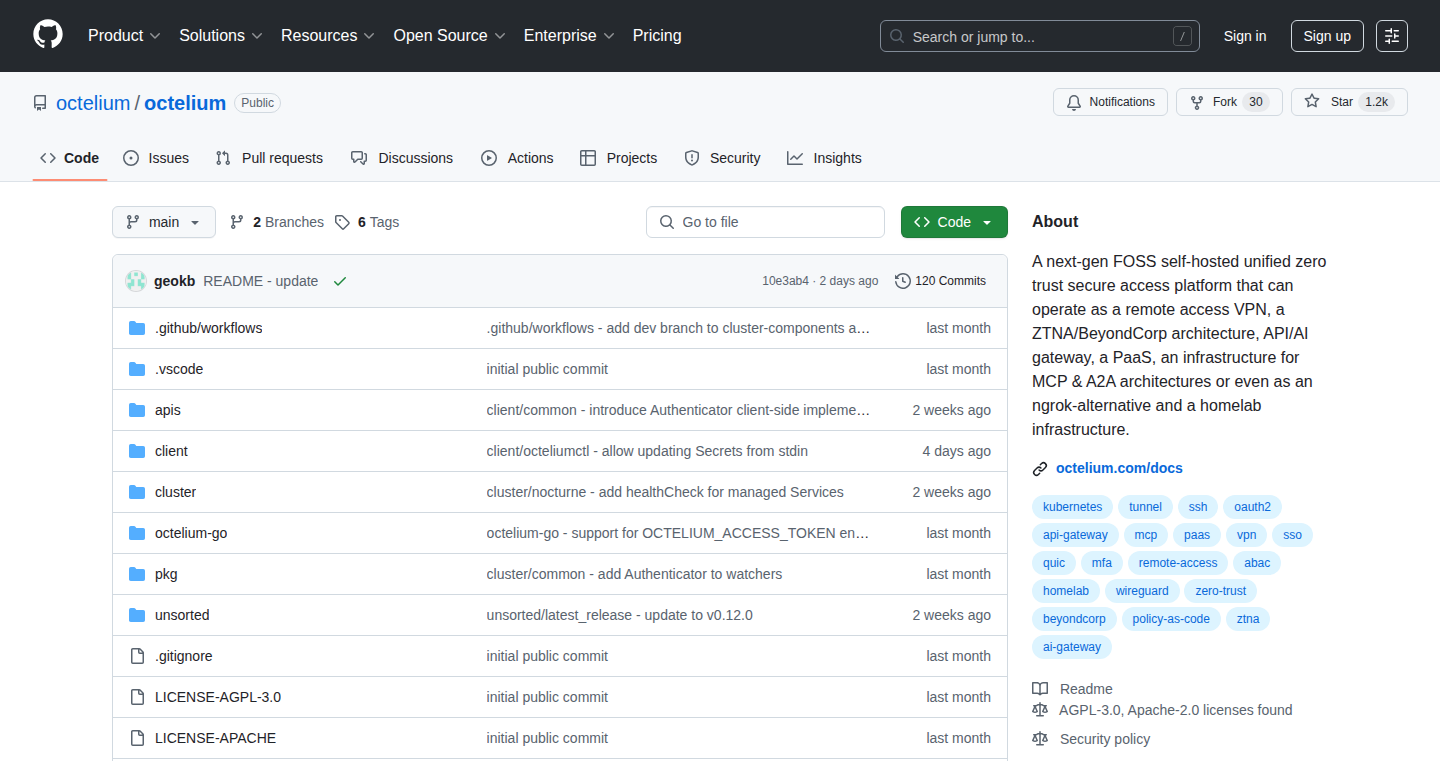
Author
geoctl
Description
Octelium is an open-source platform designed to replace traditional VPNs and provide secure access to resources using a "zero trust" approach. It's a modern alternative to tools like Teleport, Cloudflare Access, and Tailscale. The core innovation lies in its ability to unify various access control methods – from remote access to API gateways – under a single, scalable architecture, similar to how Kubernetes manages containerized applications. This allows for a more secure, flexible, and manageable approach to accessing resources, eliminating the need for complex and often vulnerable VPN configurations. So this can replace your VPN and provides a more secure way to access your data.
Popularity
Points 318
Comments 136
What is this product?
Octelium is a software solution built on the principles of zero-trust security. Instead of blindly trusting users who connect to your network, it verifies every user and device before granting access to specific resources. It achieves this through a unified platform that supports various access methods: remote access (like a VPN), access to cloud applications (ZTNA), and API gateways. Technically, it leverages technologies like identity verification, device posture assessment, and granular access policies. Think of it as a Kubernetes-like system for managing secure access, making it easy to scale and control access across different environments. So, it's like a super-secure gateway that lets the right people and devices access the right things.
How to use it?
Developers can use Octelium in several ways. They can set it up as a replacement for VPNs, securing remote access to their internal servers and applications. They can use it as a ZTNA (Zero Trust Network Access) solution, controlling access to cloud-based resources. They can also configure it as an API gateway, adding security and access control to their APIs. Deployment involves installing Octelium on your infrastructure, configuring your authentication methods, defining access policies, and integrating it with your existing services. This is often done through configuration files and command-line tools. So, it helps developers secure their projects and make them available to the right people in a more streamlined way.
Product Core Function
· Remote Access/VPN Replacement: Octelium provides a secure alternative to traditional VPNs, allowing employees to access internal resources remotely without the security risks associated with VPNs. So, it is great for remote teams.
· ZTNA (Zero Trust Network Access): It implements zero trust principles, verifying users and devices before granting access to applications, preventing unauthorized access and reducing the attack surface. So, it provides better security for accessing your apps.
· API/AI Gateway: Octelium can act as a gateway for APIs, enabling secure access control, authentication, and rate limiting, which is crucial for managing and protecting your APIs. So, it helps to protect your API from the outside world.
· Infrastructure for Machine-to-Machine (M2M) & Application-to-Application (A2A): It supports secure communication between applications and services, making it suitable for microservices architectures and service meshes. So, it is great for building more complex systems.
· Kubernetes Ingress Alternative: Octelium can be used as an ingress controller for Kubernetes, providing secure and controlled access to services running inside a Kubernetes cluster. So, it offers a secure path for users to get into your Kubernetes cluster.
· Self-Hosted Platform: As a self-hosted platform, Octelium gives developers full control over their access infrastructure, ensuring data privacy and compliance with regulations. So, you own your data and how it is secured.
Product Usage Case
· A startup uses Octelium to replace their VPN, securely connecting remote employees to their development servers, protecting the codebase from unauthorized access. They have a team that works from all over, and this keeps them secure.
· An enterprise deploys Octelium as a ZTNA solution to control access to its cloud-based applications, ensuring that only authenticated and authorized users can access sensitive data. This allows them to secure their AWS accounts.
· A company uses Octelium as an API gateway, adding authentication, authorization, and rate limiting to their APIs, protecting them from abuse and ensuring the API services are reliable. If you provide services over APIs, this keeps them safe.
· A developer sets up Octelium in their homelab to securely access their personal servers and services from anywhere, using it as a secure and easy-to-manage remote access solution. Great for those that like to tinker!
2
LLM API Test: Performance Benchmarking Tool
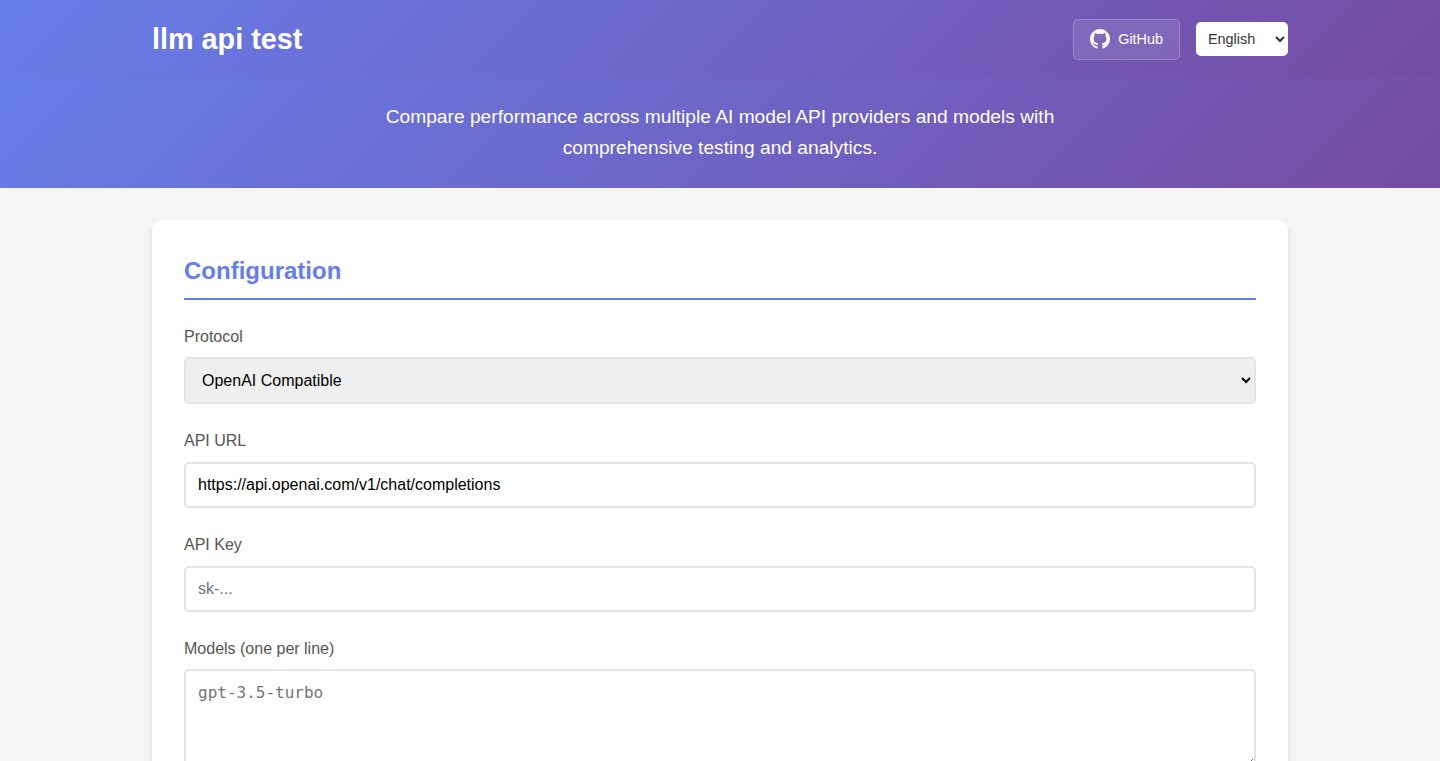
Author
mrqjr
Description
This project is a straightforward, open-source tool designed to measure and compare the performance of various Large Language Model (LLM) APIs, including OpenAI, Claude, and self-hosted models like llama.cpp. It focuses on two key metrics: 'first-token latency' (how quickly the model starts responding) and 'output speed' (how many words it generates per second). The tool allows developers to easily assess different LLM providers, including third-party proxies and self-hosted options. The core innovation is the ease of comparing different LLMs in a consistent and reproducible way, making it simple to choose the best model for a specific application.
Popularity
Points 45
Comments 8
What is this product?
LLM API Test is a performance testing tool for LLMs. It works by sending test requests to different LLM APIs and measuring their response times and output speeds. It’s like a stopwatch for language models. The key innovation is that it provides a standardized method to evaluate and compare different LLMs, including both well-known providers and self-hosted options. So what does this mean to you? You can choose the most performant and cost-effective LLM for your project, saving you time and money.
How to use it?
Developers can use this tool by providing the API endpoint URL and any necessary authentication keys. The tool then runs a series of tests and generates a report showing the performance metrics. It is designed to be easily configured to support new LLM providers. The project supports several configurations including using docker-compose for self-hosting. This allows developers to integrate it into their development workflows to automatically test their chosen models. The ease of use and clear visualization will allow you to rapidly compare different API endpoints. So what does this mean to you? You can quickly identify and switch to faster or cheaper LLMs, improving user experience and reducing costs.
Product Core Function
· First-Token Latency Measurement: Measures how quickly an LLM API starts responding to a query (in milliseconds). This helps developers understand how quickly users will start seeing results. For example, if you're building a chatbot, this metric directly impacts how responsive the bot feels. So what does this mean to you? Faster first token means a more responsive application, leading to a better user experience.
· Output Speed Measurement: Measures the speed at which an LLM generates tokens (words) per second. This indicates the overall fluency of the model. This is crucial for applications that require fast generation of text, like summarizing long documents or writing articles. So what does this mean to you? Higher output speed means faster generation and potentially more efficient use of the LLM.
· Support for Multiple API Endpoints: Allows testing and comparison of OpenAI, Claude, and self-hosted LLMs. This provides flexibility and allows developers to choose the best LLM for their needs, considering factors such as cost, performance, and privacy. So what does this mean to you? You can compare and choose from different LLM providers, based on your specific needs and budget.
· Configurable Test Requests: Provides the ability to set up test requests with different parameters, such as the number of requests and the prompt used. This allows for more fine-grained performance testing. This enables developers to fine-tune their testing to specific use cases and workloads. So what does this mean to you? You can tailor your tests to reflect your actual use cases, improving the accuracy of the results.
· Clear and Visual Reporting: Presents performance data in a simple and understandable format, including graphs and charts. This simplifies the process of analyzing and comparing the performance of different LLMs, allowing for easy identification of bottlenecks and areas for improvement. So what does this mean to you? You can quickly see the performance differences and make informed decisions.
Product Usage Case
· Building a Chatbot: Developers can use this tool to benchmark different LLMs to identify which one provides the fastest response times and the most fluent output. This helps in creating a responsive and user-friendly chatbot. So what does this mean to you? You can make your chatbot feel more responsive and engaging.
· Content Generation Platform: Developers can use this tool to test different LLMs for article generation, content summarization, or rewriting tasks. By comparing the output speed, they can find the most efficient LLM for their content creation pipeline. So what does this mean to you? You can optimize your content creation workflow to be more efficient and faster.
· Selecting an LLM Provider: Companies can utilize this tool to compare the performance of various LLM providers to determine which best fits their needs in terms of speed, cost, and reliability. This allows for informed decision-making when selecting an LLM provider. So what does this mean to you? You can select the right LLM provider to balance performance and cost.
· Self-Hosted LLM Evaluation: Developers and organizations can use the tool to test and benchmark their own self-hosted or custom-built LLMs. This aids in tuning and optimizing their models for their specific hardware and use cases. So what does this mean to you? You can optimize your own models for your specific needs.
· Proxy Service Evaluation: Those using proxy LLM API services (which often promise to reduce costs), can use this tool to verify performance claims and ensure their applications aren't suffering from slower response times due to the proxy. So what does this mean to you? You can determine if a proxy LLM API is genuinely providing benefits.
3
SharpeRatioExplorer: Historical Sharpe Ratio Visualization

Author
navquant
Description
This project is a simple but effective tool for calculating and visualizing the Sharpe Ratio, a key metric used in finance to measure the risk-adjusted return of an investment. The innovation lies in providing the full historical variation of the Sharpe Ratio, allowing users to understand how it has changed over time. This addresses the common problem of only seeing a single Sharpe Ratio value, which can be misleading. This tool helps users gain a deeper understanding of investment performance and volatility.
Popularity
Points 20
Comments 16
What is this product?
This tool calculates the Sharpe Ratio using historical data. The core innovation is not just calculating a single number but showing how the Sharpe Ratio has changed over a given period. The underlying technology involves fetching financial data (like stock prices), calculating returns, and then using the formula for Sharpe Ratio (which factors in the average return, risk-free rate, and volatility). The historical visualization allows users to spot trends and understand risk exposure better. So this tool helps you understand how well an investment performed compared to its risk, and how that performance has changed over time.
How to use it?
Developers and financial analysts can use this tool by inputting historical price data or integrating it with their existing financial analysis tools. The tool likely provides a way to input data (e.g., CSV files, API connections) and visualizes the results, probably with charts and graphs showing the Sharpe Ratio over time. This allows users to quickly assess the risk-adjusted performance of investments. So you can easily plug in your investment data and see how its risk and return have performed, or build it into your own analysis tools.
Product Core Function
· Sharpe Ratio Calculation: Computes the Sharpe Ratio, a metric that tells you how much excess return you are receiving for the extra volatility that you bear for holding an investment. Value: Offers a quantifiable measure of investment performance, adjusted for risk. Applications: Evaluating portfolios, comparing investment options.
· Historical Sharpe Ratio Visualization: Displays the Sharpe Ratio over time, allowing users to see how performance has changed. Value: Provides a dynamic view of investment performance and helps identify periods of high or low risk-adjusted returns. Applications: Identifying trends, understanding risk profiles, backtesting investment strategies.
· Data Input and Processing: Allows users to input financial data (e.g., stock prices). Value: Enables the analysis of various investment products or strategies. Applications: Analyzing stocks, mutual funds, ETFs, or custom trading strategies.
Product Usage Case
· Backtesting a Trading Strategy: A developer can use this tool to analyze how the Sharpe Ratio of a trading strategy has performed over different time periods. For example, someone using a machine learning model for trading can use this tool to see how the Sharpe Ratio performed over a 5-year period. Value: This helps to understand the risks of this strategy and fine tune it to maximize returns.
· Comparing Investment Options: A financial analyst can use the tool to compare the Sharpe Ratios of different investment funds. For example, comparing a small-cap growth fund to a large-cap value fund using their historical Sharpe Ratios will show the risk-adjusted performance of each one, informing investment decision making. Value: Helps making data-driven investment decisions, by showing you the risk-adjusted performance of different investments.
4
SmartStepper v2: Declarative Multi-Step Forms for React
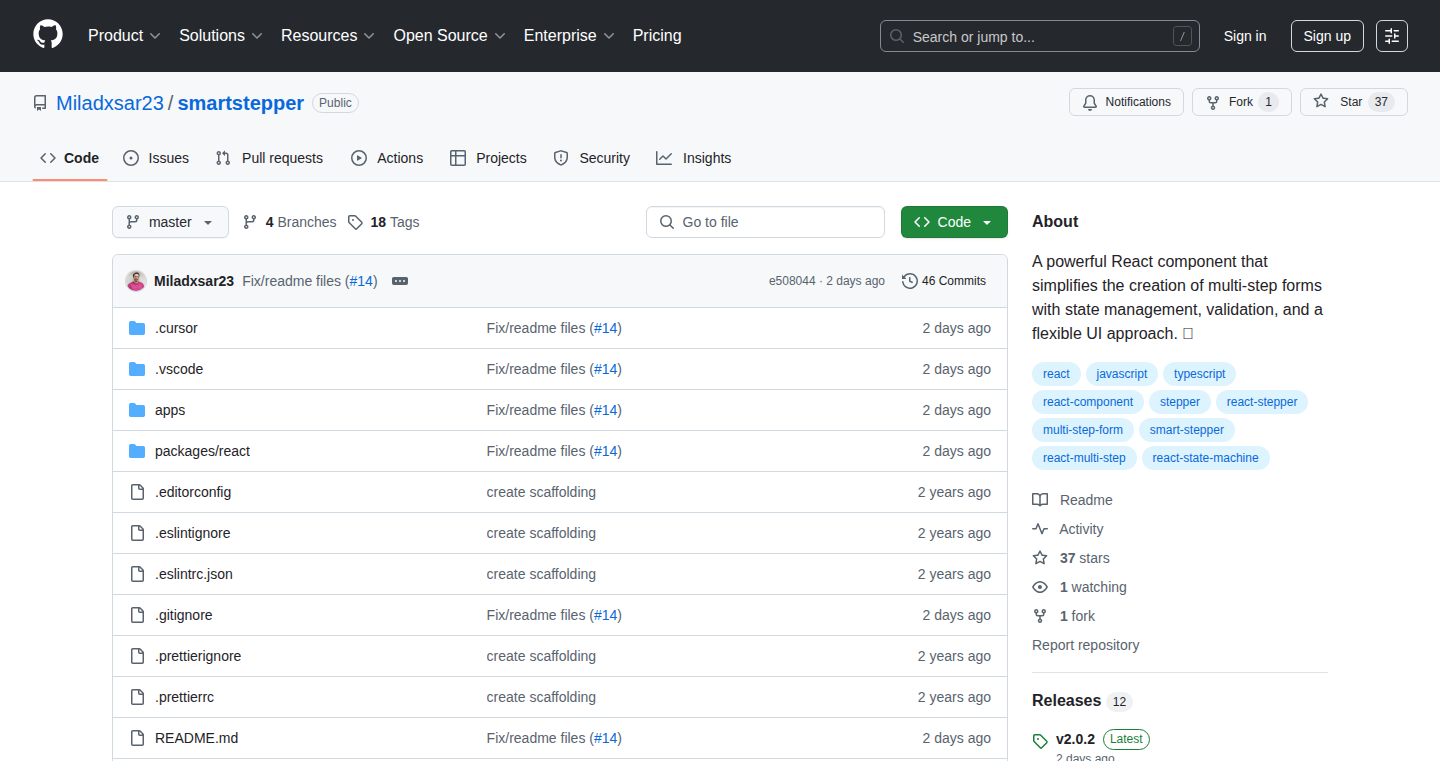
Author
milad_shirian
Description
SmartStepper v2 simplifies the creation of multi-step forms in React applications. It introduces a config-based approach, allowing developers to define the flow (next/previous steps), validation rules, and views using a single configuration object. This eliminates the need for complex if/else statements and scattered state management, making form development cleaner and more manageable. So, it helps you build complex forms with less code and fewer headaches.
Popularity
Points 14
Comments 4
What is this product?
SmartStepper v2 is a React library that allows you to build multi-step forms using a declarative approach. Instead of writing a lot of code to manage each step, validation, and navigation, you define everything in a configuration object. This object specifies the order of steps, validation rules for each field, and what each step looks like. This means you describe *what* you want the form to do, and SmartStepper takes care of *how* it's done under the hood. It's like giving the library a blueprint and letting it build the form for you. So, it streamlines the whole process of building complex forms.
How to use it?
Developers integrate SmartStepper into their React projects by importing and using the library's components. They create a configuration object that outlines the structure of their multi-step form. This object defines the steps, their order, validation rules, and the React components to render for each step. SmartStepper then handles the navigation between steps, the validation of data, and the display of the correct view at each stage. You would typically use it in applications like signup processes, onboarding flows, or any application requiring a step-by-step data entry process. So, it's very helpful for improving the user experience in forms.
Product Core Function
· Declarative Configuration: Defines form structure, validation, and navigation in a single config object, which makes forms easier to understand, maintain, and modify. So, it means less debugging time and more time building features.
· Config-Based Flow Control: Manages the flow between steps based on the configuration, removing the need for manual conditional logic. So, it saves you from the messy code for controlling the navigation between form steps.
· Validation Support: Integrates validation rules directly into the configuration, ensuring data integrity and providing immediate feedback to users. So, it helps you ensure that the data entered in the form is accurate.
· Component Agnostic: It is independent of specific UI libraries and can be used with any UI component library, such as Material UI, Ant Design, or your custom components. So, it provides flexibility in how your form looks.
· State Management: Handles the state management of form data automatically, reducing the boilerplate code developers have to write. So, it takes care of the complexity of managing the form's internal state.
Product Usage Case
· User Onboarding: Creating a multi-step signup process for a web application. SmartStepper would manage the steps, validation of email and password, and display different steps. So, it improves the onboarding experience and reduces the number of frustrated users.
· E-commerce Checkout: Building a checkout form with multiple steps (shipping address, payment details, order confirmation). SmartStepper would handle step navigation and data validation. So, it helps to ensure the checkout process is smooth and secure.
· Application Form: Developing an application form with multiple sections (personal information, education, experience). SmartStepper would ensure all the data is valid. So, it will reduce errors and improve data quality.
· Survey/Quiz: Creating a multi-page survey with different questions on each step. SmartStepper helps to manage the quiz steps and validation. So, it facilitates the creation of engaging user surveys.
5
ConsonantGuess – A Daily Word Puzzle Solver

Author
nbhat
Description
ConsonantGuess is a web-based daily word puzzle. The user is presented with a word, but only the consonants are revealed. The challenge is to guess the vowels and complete the word. The technical innovation lies in its efficient algorithm for generating the puzzles, utilizing a dictionary and a word validation process to ensure the puzzle is solvable and challenging. It tackles the problem of creating engaging word puzzles with minimal resources.
Popularity
Points 3
Comments 5
What is this product?
It's a simple word puzzle game. You see a word with only consonants, and you have to guess the vowels to complete it. The cool part is how it's made. The program uses a huge list of words (a dictionary) and cleverly picks words, hiding the vowels. It then makes sure the puzzle is actually possible to solve. So this program automates the creation of a new, solvable word puzzle every day.
How to use it?
As a developer, you can either play the game directly on the webpage. If you're interested in building your own word puzzle game, you could examine its source code and see how it's built. This project offers a simple example of how to generate puzzles algorithmically, which could be adapted for other similar game concepts.
Product Core Function
· Word Selection: The core function involves randomly selecting words from a dictionary. This is the foundation of generating a new puzzle, providing the words that players will be trying to solve. So this is useful for choosing words appropriate for a puzzle.
· Consonant Masking: The system hides the vowels of the selected word, showing only the consonants. This function creates the puzzle's core challenge. This is useful for creating a challenge for your players.
· Solvability Validation: Before presenting the puzzle, it confirms that the hidden vowels can actually be filled in to form a valid word. This prevents unsolvable puzzles and ensures a positive player experience. So this is useful for verifying a correct puzzle.
· User Interface (UI): The UI for displaying the masked word and allowing the player to input their guesses. So this is useful for displaying the puzzle and for players to try solving.
Product Usage Case
· A developer could use the core puzzle generation logic to build variations of the game, like a daily riddle using different masking rules or difficulty levels, using the same dictionary.
· Another application could be in education. The game's logic can be incorporated into learning tools for language, helping students with vocabulary by showing only consonants and prompting them to guess the vowels. So this can be used in educational tools.
6
Domain-Check: A Rust-Powered Domain Availability Checker
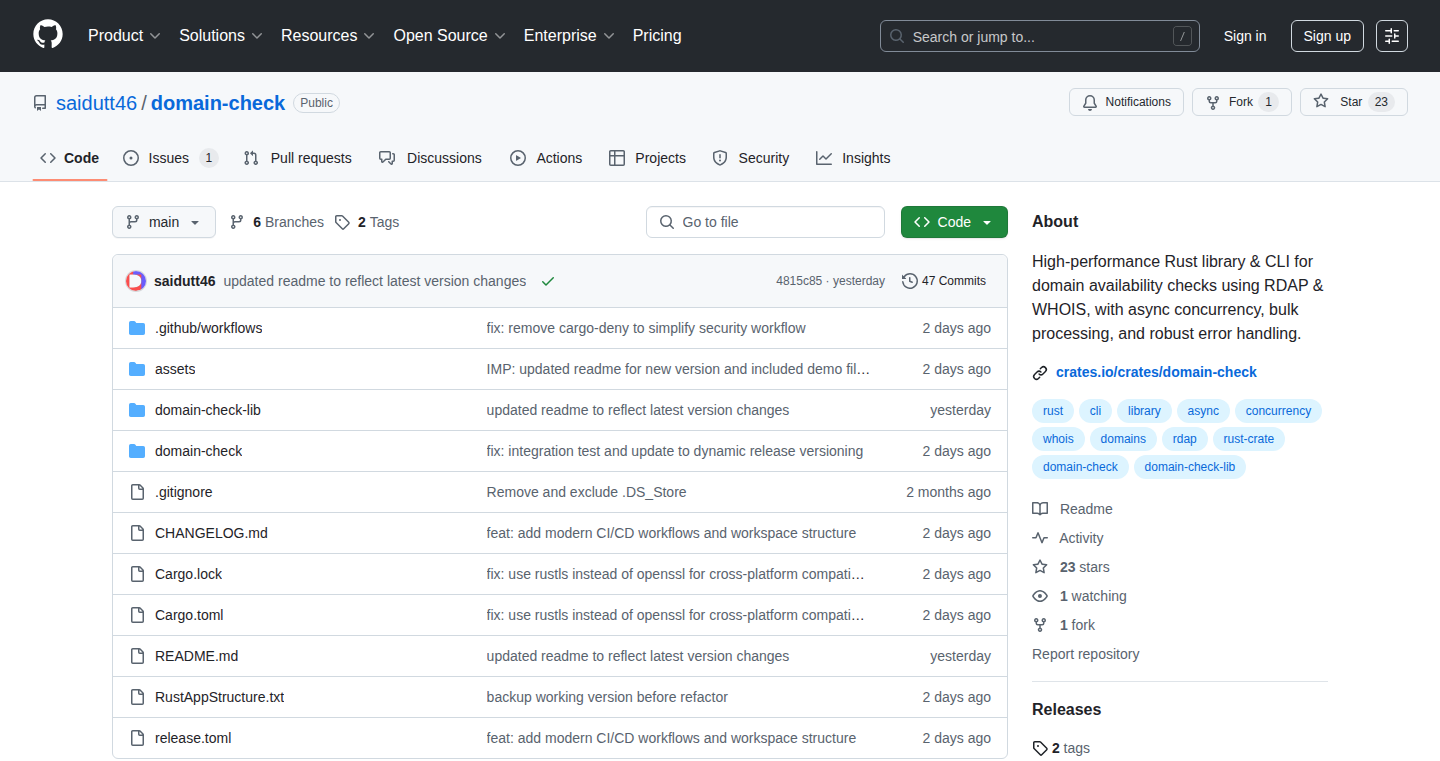
Author
gvs46
Description
This project is a command-line tool built with Rust that quickly checks the availability of domain names. The key innovation is its speed and efficiency, achieved through Rust's performance capabilities, allowing for rapid and parallel checks. This solves the problem of slow and cumbersome domain availability searches, crucial for anyone looking to register a new domain or build a web application.
Popularity
Points 3
Comments 1
What is this product?
Domain-Check is a tool that uses the Rust programming language to efficiently determine if a domain name is available for registration. The technical innovation lies in using Rust's speed and multi-threading capabilities to perform multiple domain lookups simultaneously. This significantly speeds up the process compared to traditional methods that often involve sequential checks or rely on external APIs with rate limits. So this means you can check a lot more domains, a lot faster.
How to use it?
Developers use Domain-Check from the command line. You simply provide a list of domain names, and the tool quickly tells you which ones are available. This can be integrated into scripts for automated domain name research, used in web development projects to help users find available domain names, or even used as a component in a larger system that monitors domain name availability. So, you can use this to make your automated systems for domain name checking and suggestion.
Product Core Function
· Fast domain availability checks: The tool leverages Rust's efficiency to rapidly query domain name servers, providing quick results. This saves developers time compared to slower methods. The value is in quickly finding available domain names for projects.
· Parallel domain checking: Domain-Check utilizes multi-threading to check multiple domains concurrently. This dramatically reduces the time required to check large lists of domain names. The value here is the significant time savings when searching for domain names.
· Command-line interface (CLI): The CLI provides a straightforward way to input domain names and view the results. This makes it easy to integrate into existing workflows. The value is its ease of use and integration into other tools.
· Lightweight and efficient: Built in Rust, the tool has minimal dependencies and consumes few resources. This makes it suitable for use on various platforms and in resource-constrained environments. The value is the tool's portability and low resource usage.
Product Usage Case
· Automated domain name research: A developer can use Domain-Check in a script to automatically check the availability of potential domain names for a new project. This saves time and manual effort. So, if you need to find a domain for your new company, this helps you.
· Integration into web application builders: The tool could be integrated into a web application builder, allowing users to check domain availability directly within the application. This improves the user experience by providing real-time feedback. So, people can check domains while they are making their websites.
· Domain name monitoring: Developers can create scripts that regularly check the availability of specific domain names, helping them to identify when a domain expires or becomes available. So, it helps in getting expired domains.
7
Memory-Rush: Emoji-Powered Memory Game
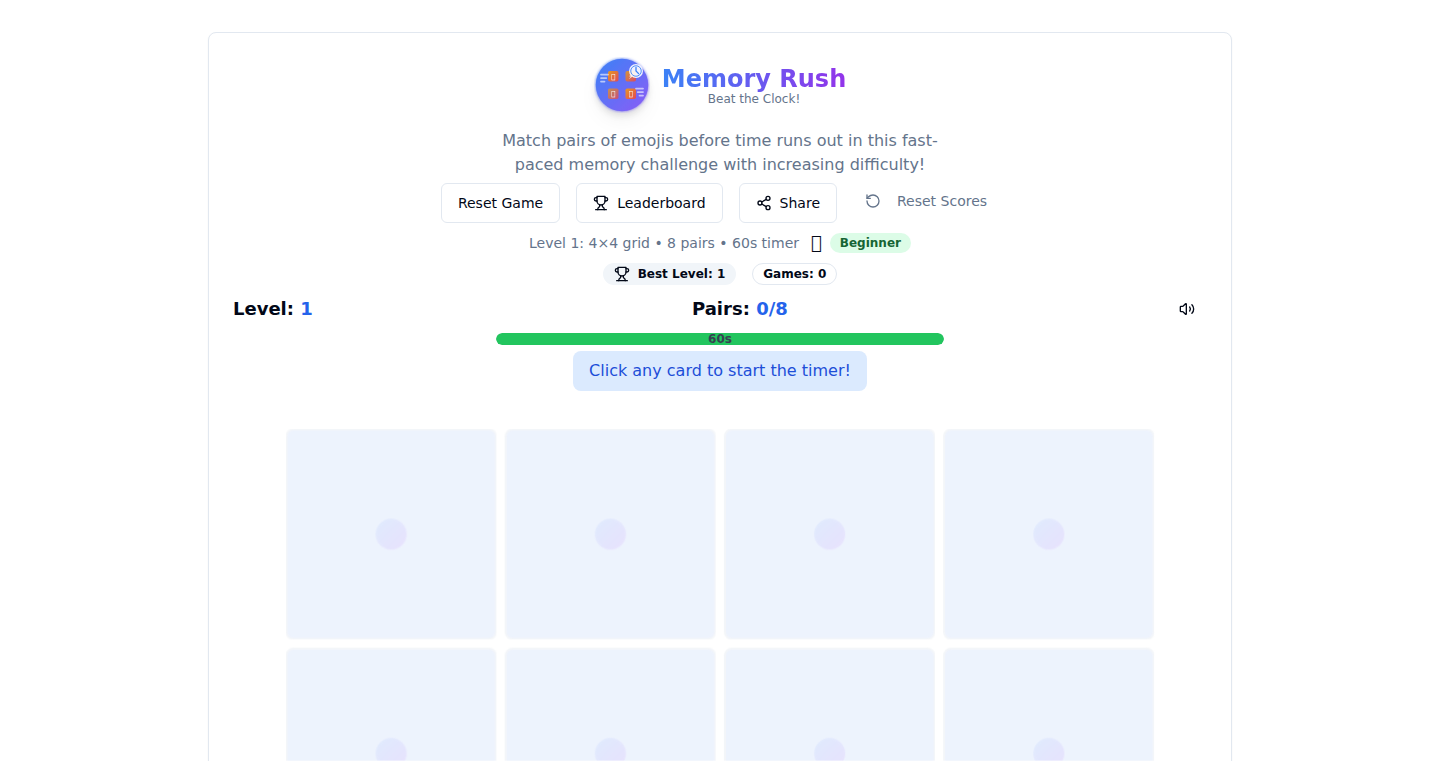
Author
sanchitak
Description
Memory-Rush is a basic emoji memory game, demonstrating a simple approach to game development and potentially serving as a learning tool for beginners. It highlights the use of emoji as visual elements and provides a framework for understanding game logic.
Popularity
Points 2
Comments 2
What is this product?
Memory-Rush is a browser-based game where you match pairs of emojis. The core innovation lies in its simplicity and use of emojis, making it accessible to anyone familiar with emojis. The project is likely built using HTML, CSS, and JavaScript, common web technologies for creating interactive user interfaces. So, this demonstrates how easy it is to build a simple game with web technologies.
How to use it?
Developers can access the game via a web browser. To utilize it, one can view the source code and understand the implementation details. The developer can use the game's core logic as a foundation, learn about basic game mechanics, and leverage the project for educational purposes. For example, you can adapt the existing code and build on it to add more complex game features. So, you can understand how game logic can be implemented simply and creatively.
Product Core Function
· Emoji Display and Randomization: The game randomizes the arrangement of emojis on the game board, demonstrating basic JavaScript array manipulation techniques. This allows for creating a different game layout each time, showing a fundamental technique in game design to ensure replayability. For example, you can adapt the emoji selection and the number of emojis to create a game that fits specific requirements.
· Click Event Handling: The game responds to user clicks on the emoji tiles. The implementation teaches how events can be handled in JavaScript to create a responsive user experience. This helps understand how to create interactive web pages. For example, this helps you understand how to react to users' clicks and other interactions.
· Pair Matching Logic: The core game mechanic of matching emoji pairs is implemented with conditional logic. This shows how to control the gameplay based on user interactions. It demonstrates the fundamentals of game design like comparisons and conditional statements. For example, you can learn the logic of how to check whether a pair has been found or not.
Product Usage Case
· Educational Project: Beginners can learn to use the game as a coding example and guide. It teaches the fundamentals of front-end web development and game design in a fun, understandable format. So, you can use this project as a coding exercise to learn the basic technologies and logic.
· Prototype for a Larger Project: The game’s structure may be useful as a starting point for building a more complex memory game or other similar games. So, this helps you set up a working base to build a more complex game and start quickly.
· Interactive Tutorial: Developers can use this project to teach web development and game design to beginners, helping them understand game mechanics and the basics of JavaScript. So, you can use the code of this project to show students how to create a simple memory game.
8
GoXDP-DNS: Blazing-Fast DNS Resolution with XDP Sockets
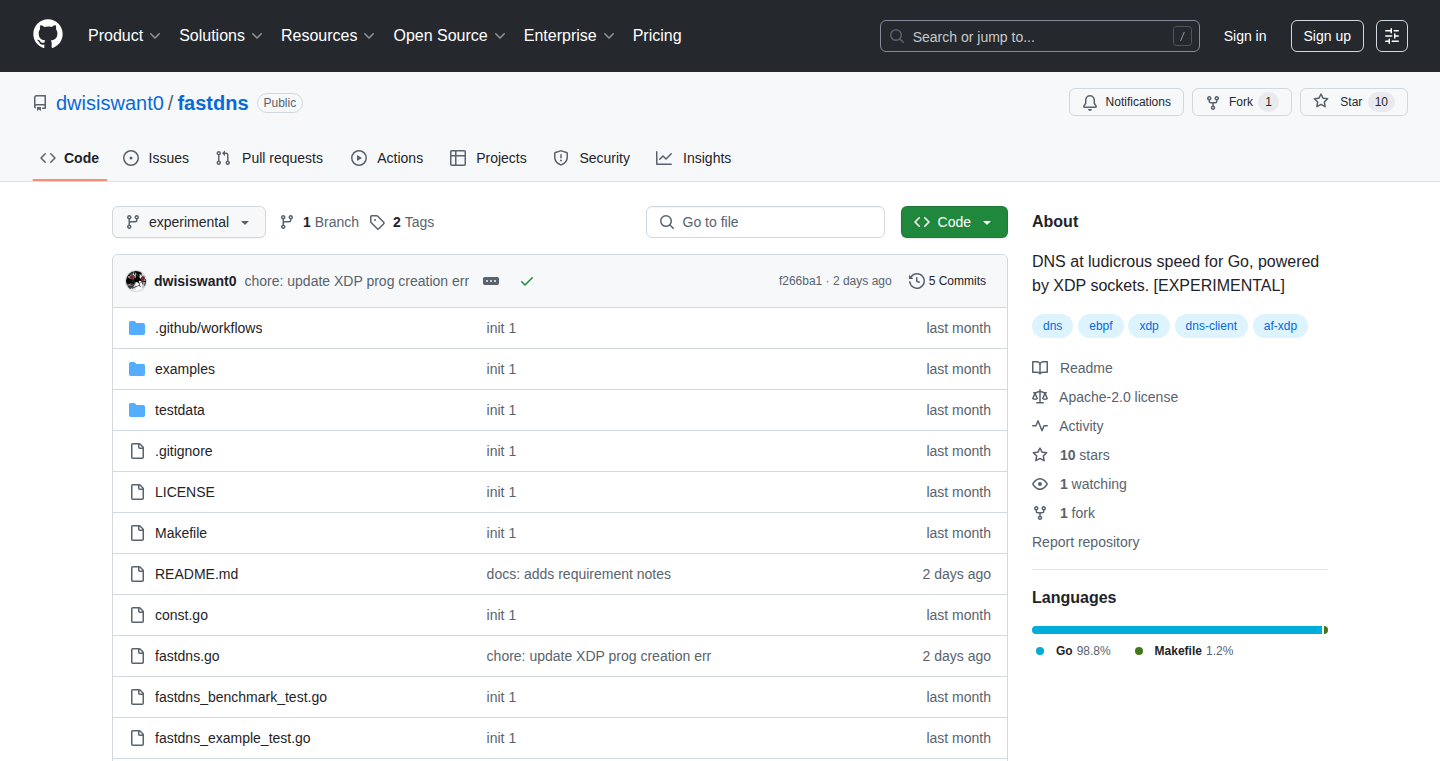
Author
dwisiswant0
Description
This project builds a DNS resolver in Go leveraging the power of XDP (eXpress Data Path) sockets. It achieves incredible speed by processing network packets directly within the kernel, bypassing many traditional networking layers. It solves the problem of DNS resolution latency, allowing for significantly faster lookups, crucial for performance-sensitive applications. Think of it as a supercharged DNS lookup engine, built for speed and efficiency.
Popularity
Points 3
Comments 1
What is this product?
GoXDP-DNS uses XDP, a technology that allows programs to run very close to the network interface card (NIC). This means network packets can be processed with minimal overhead, leading to ultra-fast DNS resolution. The innovation lies in combining Go's concurrency with XDP's low-level packet processing, creating a highly performant and scalable DNS resolver. This project bypasses the usual layers of network processing, reducing latency and improving the responsiveness of network applications. The technical principle involves directly interacting with network packets, filtering and forwarding them at the kernel level.
How to use it?
Developers can integrate GoXDP-DNS into their Go applications as a high-speed DNS resolver. This involves configuring the application to use this resolver instead of the system's default resolver. You would typically use it in situations where you need to minimize DNS lookup times, such as in high-traffic web servers, content delivery networks (CDNs), or applications requiring near real-time performance. For example, you would configure your application's network settings to point to this custom DNS resolver, which would then handle the DNS queries.
Product Core Function
· XDP-Accelerated DNS Resolution: This is the core function. It uses XDP sockets to process DNS requests directly in the kernel, minimizing latency. This is valuable because it significantly speeds up DNS lookups, critical for applications where every millisecond counts. It can be used to enhance the speed of any network-dependent application.
· Go-Based Implementation: The project is written in Go, which offers excellent concurrency and performance. This is valuable because Go's built-in concurrency features allow for efficient handling of multiple DNS requests simultaneously. Developers can easily maintain and extend the code. It makes it suitable for building scalable network services.
· Bypass of Standard Network Layers: By operating at a lower level, the resolver bypasses the overhead of standard network stack processing. This is valuable because it reduces latency. This translates to faster web page loading and quicker response times for network applications. This can greatly benefit applications dealing with high volumes of DNS queries.
· Customizable DNS Configuration: Allows for flexible configuration of DNS settings, such as upstream DNS servers and caching options. This is valuable because it allows developers to tailor the resolver to their specific needs and network environment, providing greater control over DNS resolution behavior. This improves the robustness and efficiency of the DNS lookup process.
· Scalability and Performance: The architecture is designed to handle high traffic loads and maintain high performance. This is valuable because it ensures that the resolver can handle a large number of DNS requests without performance degradation, suitable for serving large numbers of users or requests. This is important for high-traffic websites and network services.
Product Usage Case
· High-Traffic Web Servers: A web server handling a large number of concurrent requests can use GoXDP-DNS to reduce DNS lookup times, resulting in faster response times and an improved user experience. This means the server can serve web pages more quickly, reducing latency for users.
· Content Delivery Networks (CDNs): CDNs can benefit from GoXDP-DNS by speeding up DNS lookups for geographically distributed users. This leads to faster content delivery and improved overall performance. It helps deliver content to users worldwide faster and more efficiently.
· Real-Time Applications: Applications requiring real-time data transmission, such as online gaming or financial trading platforms, can use GoXDP-DNS to minimize latency and improve responsiveness. This means faster data updates and a smoother user experience.
· Load Balancing Infrastructure: Load balancers can use the resolver to speed up the process of resolving backend server IP addresses, improving overall application availability. It improves the reliability of load balancing systems.
· Network Monitoring Tools: Network monitoring tools can use GoXDP-DNS to perform DNS lookups more quickly, enabling faster data collection and analysis. This improves the efficiency of network analysis tasks.
9
Layerfig: Type-Safe Layered Configuration
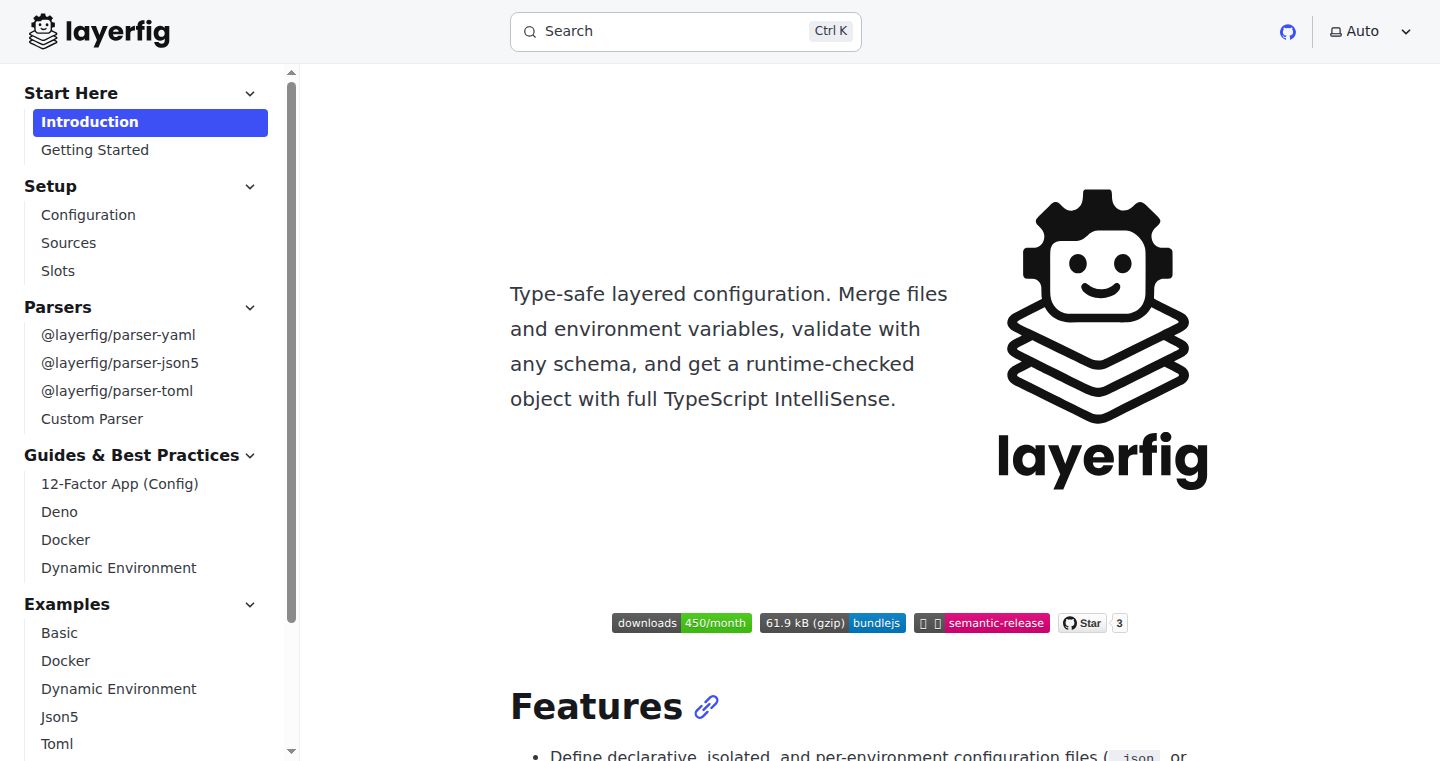
Author
raulfdm
Description
Layerfig is a JavaScript/TypeScript library designed to handle configuration in a type-safe and layered manner. It allows developers to manage application settings from various sources (environment variables, files, etc.) and merge them with a clear precedence order, ensuring that the most important settings override others. The innovation lies in its robust type safety, which catches configuration errors at development time, and its flexible validator integration. So this prevents unexpected behavior in your application and makes configuration management much more reliable.
Popularity
Points 4
Comments 0
What is this product?
Layerfig simplifies managing application configurations by allowing developers to load settings from multiple sources (like environment variables, configuration files, or command-line arguments) and merge them in a specific order. It uses TypeScript to ensure the configuration settings adhere to a predefined structure (type safety). It also integrates validators (like Zod or Yup) to further check if configuration values meet specific criteria. This helps developers to avoid common configuration pitfalls, such as typos, invalid values, and unexpected behavior. The innovative part is the layered approach combined with type safety and validation, resulting in a more resilient and maintainable configuration process. So, it ensures the configuration behaves predictably.
How to use it?
Developers integrate Layerfig by defining a configuration schema (using TypeScript interfaces or types) that describes the expected configuration settings and their data types. They then define the sources for their settings (e.g., environment variables, configuration files). Layerfig loads settings from these sources, applies the precedence rules, merges them, and validates them against the schema. Finally, developers can access the merged, validated configuration via a type-safe object. This is typically used in any project that has settings like databases, API keys, etc. For example, in a Node.js server, it might read the database connection string and the port the server runs on. So you have a clear and safe way to manage your application's crucial settings.
Product Core Function
· Layered Configuration Loading: Load settings from multiple sources with a defined precedence order (e.g., command line arguments take priority over environment variables). This is useful for overriding default settings for different deployment environments.
· Type-Safe Configuration Schema: Define the expected structure of configuration settings using TypeScript types. This prevents type errors at runtime. This helps catch errors early in the development process and improves code maintainability.
· Validator Integration: Integrate validation libraries (like Zod, Yup) to validate configuration values against custom rules and constraints. This is useful for ensuring the values meet certain criteria.
· Error Reporting and Handling: Provide clear error messages when configuration loading, validation, or merging fails. This improves the debugging experience and helps developers quickly identify configuration problems.
· Merge and Override: Merge configurations with the specified precedence, allowing for settings to override each other. This is useful for handling setting overrides. For example, you can override a production database connection string in a production environment, keeping a default setting in your development environment.
Product Usage Case
· API Server Development: In a Node.js API server, use Layerfig to load database connection strings, API keys, and server port numbers from environment variables and configuration files. This makes it easy to deploy the API server in different environments (development, staging, production) without changing code. So you can control your server's configuration.
· Frontend Application Development: Load API endpoints and feature flags in a frontend application from a configuration file or environment variables. This allows developers to control which features are enabled in different environments without modifying the codebase, and also, you can easily update those features.
· Command-Line Tools: Create command-line tools that load configuration settings from configuration files, environment variables, and command-line arguments, with Layerfig managing the merging and validation process. This provides a robust and error-resistant way to build command-line applications.
· Microservices Architecture: In a microservices architecture, Layerfig is great for loading service-specific configuration settings from various sources, ensuring consistency across multiple services. So, it helps you maintain a consistent environment for your microservices, reducing the chance of errors.
10
ZigCV: A ColecoVision Emulator Crafted in Zig
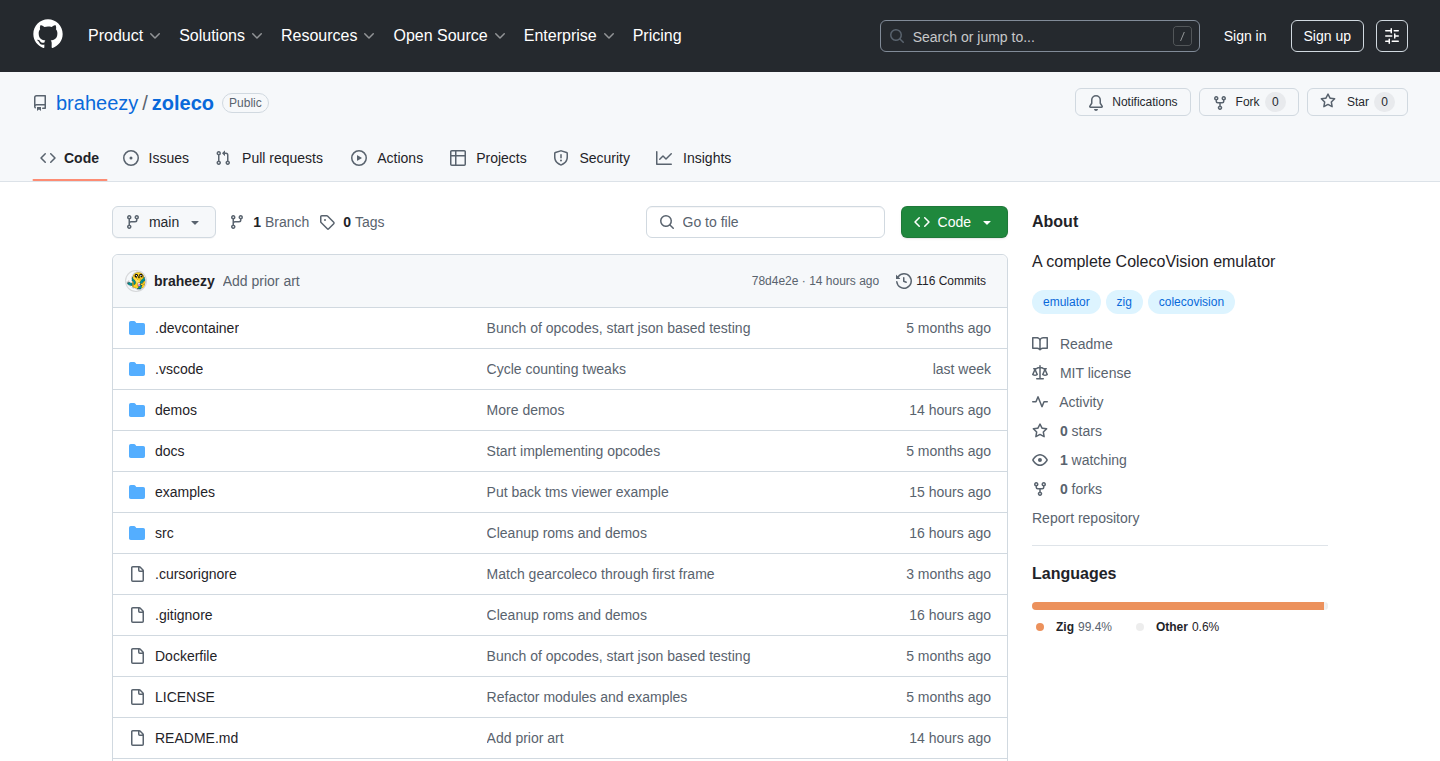
Author
braheezy
Description
ZigCV is an emulator for the ColecoVision game console, entirely written in the Zig programming language. It focuses on accurately replicating the console's hardware behavior, offering a fast and portable way to play classic ColecoVision games. The innovation lies in using Zig, a modern systems programming language, to create a highly performant and potentially more maintainable emulator. This project tackles the challenge of precise hardware emulation with a fresh approach, leveraging Zig's memory safety and focus on performance.
Popularity
Points 3
Comments 1
What is this product?
ZigCV is a piece of software that mimics the ColecoVision console, allowing you to play its games on your computer. The cool thing is that it's built using Zig, a new programming language designed for speed and safety. The project recreates how the ColecoVision's chips and components worked. It's innovative because it utilizes Zig's special features to create a potentially faster and more reliable emulator than those written in older languages like C or C++. So this means, if you're a fan of old video games, you can play ColecoVision games on modern hardware.
How to use it?
Developers can use ZigCV to play ColecoVision ROMs (the game files) on their computers. You would typically download the ZigCV emulator, get the ROM files for your favorite games, and then run the emulator to load and play them. This is useful for game preservation and for retro-gaming enthusiasts. Developers can also study the ZigCV code to learn about emulator design, the ColecoVision's architecture, and Zig programming itself. You can integrate the emulator into larger projects or use its core functionalities as a basis for further development. For instance, you could potentially build a web-based ColecoVision emulator or incorporate it into a gaming platform. This offers a practical way to experience classic games and a learning tool for understanding hardware and programming.
Product Core Function
· Accurate Hardware Emulation: The core function is to precisely simulate the behavior of the ColecoVision's CPU, graphics processor, and other components. This ensures the games run correctly, just as they did on the original console. So this provides a faithful recreation of the classic gaming experience.
· ROM Loading and Execution: The emulator allows you to load and run ColecoVision game ROM files. It reads the game data and translates it into instructions that the emulated hardware understands. So this provides access to a library of classic games.
· Video and Audio Output: The emulator renders the game's graphics on your screen and produces sound through your computer's speakers. It converts the game's internal video and audio signals into formats compatible with modern displays and sound systems. So this lets you visually and aurally enjoy the games.
· Input Handling: The emulator takes input from your keyboard or a connected gamepad and translates it into commands the emulated game can understand. This allows you to control the games. So this gives you control over the games.
Product Usage Case
· Retro Gaming Enthusiasts: Users can enjoy ColecoVision games on modern computers without needing the original console. They can rediscover classic titles or experience them for the first time. So this is a direct way to relive the gaming history.
· Game Preservation: The emulator allows the preservation of ColecoVision games. By running them on a computer, the games are protected from hardware failure or degradation. So this helps ensures that the games are available for future generations.
· Software Developers: Developers can study the code to learn how to emulate a console, and also learn about Zig programming. This is useful to understand hardware architecture. So this enhances the technical skills and understanding of system design.
· Educational Purposes: Students or hobbyists can use the emulator to understand the inner workings of the ColecoVision console, a specific piece of computer history. So this is an ideal environment to learn about how early video game consoles were built.
11
colorr.me - HEX-Based Background Generator
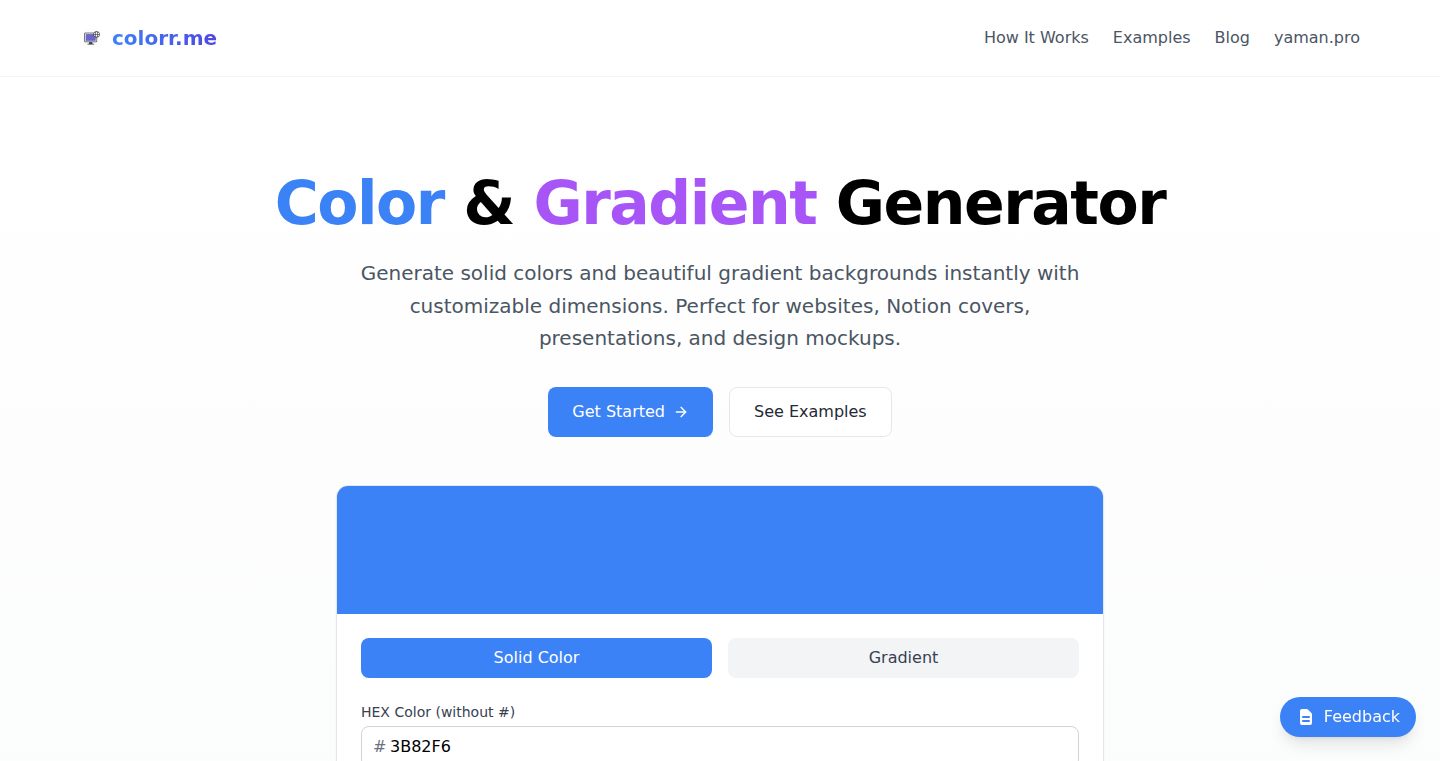
Author
yaman071
Description
colorr.me is a straightforward tool designed to generate simple solid-color or gradient backgrounds from provided HEX color codes. It allows users to customize image dimensions and properties, making it suitable for applications like Notion covers, background images, and other visual needs. The project is built as a learning experience using Go, emphasizing simplicity and ease of use. The key innovation lies in its rapid background generation and customization based on simple HEX input.
Popularity
Points 2
Comments 2
What is this product?
colorr.me is a web-based tool that simplifies the creation of custom backgrounds. You provide the tool with a few HEX color codes (like #FF0000 for red or #00FF00 for green), and it generates an image file with the specified color or gradient. It is all about taking color information and turning it into something visual. So what? This tool helps you quickly create backgrounds for your presentations, websites, or social media, and allows you to customize the size and other properties to your needs. You don't need to be a designer or have any complicated software.
How to use it?
Developers can use colorr.me to generate backgrounds programmatically or manually. You provide the HEX color codes, specify the desired dimensions, and the tool will provide the image. It is great for any project needing custom graphics, like a content management system (CMS) or a website builder, where users might want to personalize their background easily. You can integrate this tool into your workflow with a simple API call (though not provided).
Product Core Function
· HEX code input: This is the core of the application. Users enter a HEX color code or multiple codes to create gradients. The value lies in providing a user-friendly way to specify colors, bypassing more complex color selection methods. So what? This is useful for people who know their HEX codes or want to quickly test a color scheme.
· Gradient generation: The tool supports generating gradient backgrounds from multiple HEX codes. This allows users to create visually appealing backgrounds with a smooth transition of colors. So what? This allows for more dynamic and attractive backgrounds compared to solid colors, enhancing the visual appeal of any project.
· Customizable dimensions: Users can specify the dimensions (width and height) of the generated background image. This makes the tool versatile for various applications, ensuring that the generated backgrounds fit the intended use case, such as Notion covers, website banners, or social media graphics. So what? This means you get the exact size you need for your background, avoiding the need to resize images later and potentially losing quality.
· Fast background generation: colorr.me is designed for speed, allowing for quick background generation and a responsive user experience. So what? You can generate your backgrounds very quickly, making it a valuable tool if you are on a tight deadline or frequently needing to test design variations.
Product Usage Case
· Notion Cover Creation: A user can generate a custom-colored or gradient background for a Notion page cover. This is a simple use case, but it immediately personalizes a Notion workspace. So what? It allows users to visually enhance and customize their Notion pages without any design skills.
· Website Backgrounds: A web developer can use colorr.me to generate unique background images for website elements, improving the overall design and branding of the site. So what? It provides a quick and efficient way to create custom backgrounds, without the need for a graphic designer.
· Presentation Backgrounds: A presenter can create custom gradient backgrounds for their slides to create a visually appealing presentation. So what? It helps you to make your presentation visually appealing and memorable, without needing complicated design tools.
12
mcp-chat: Async Chat with MCP Tool Calls
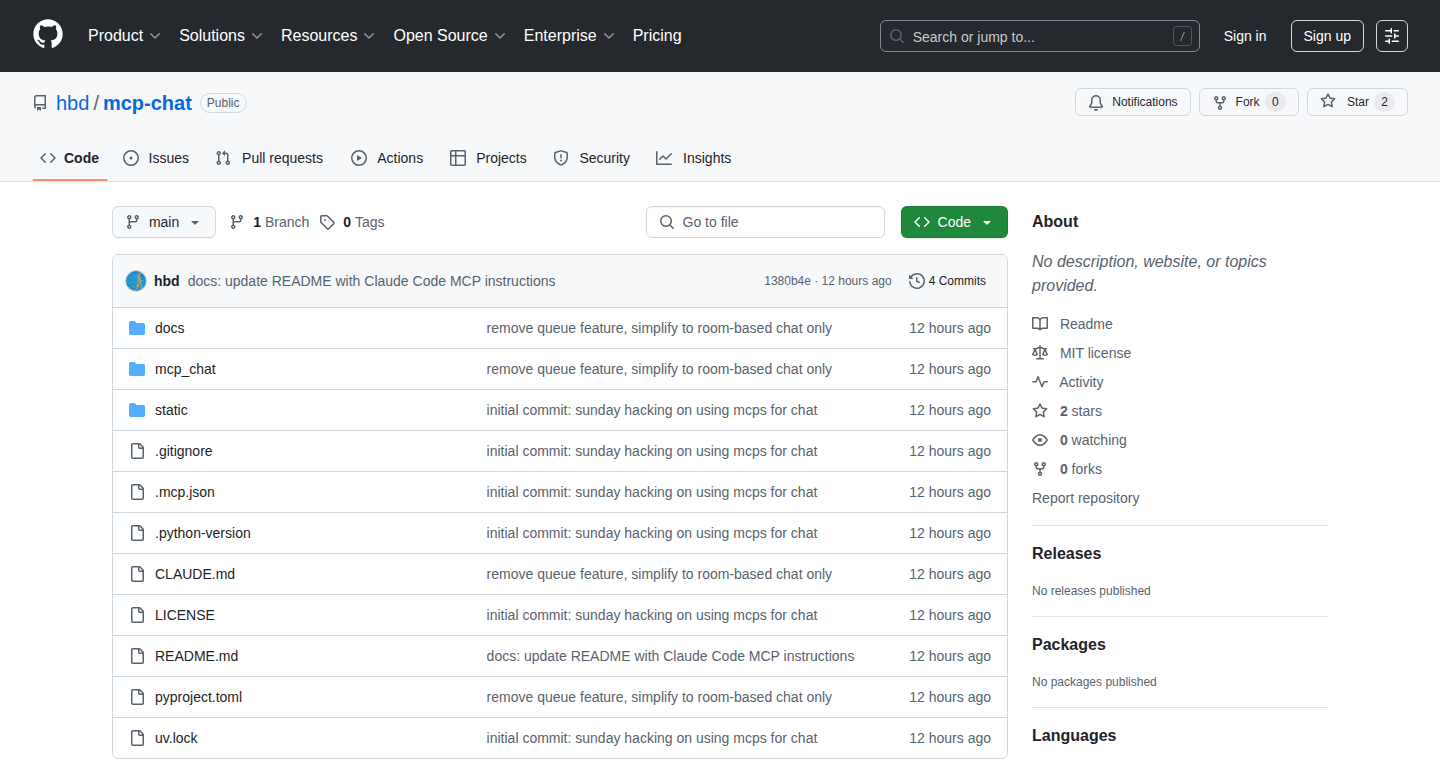
Author
myrloc
Description
mcp-chat is a chat server leveraging the power of MCP (Model-based Communication Protocol) tool calls. It allows for asynchronous chat features, meaning users can interact without needing to be online simultaneously. The core innovation lies in integrating MCP's tool call capabilities to build a more flexible and feature-rich chat experience, enabling functionalities beyond basic text communication. This approach addresses the challenge of creating real-time, complex interactions in a chat environment, moving beyond simple text exchange.
Popularity
Points 4
Comments 0
What is this product?
mcp-chat is a chat server built on top of MCP. Instead of just sending text, it uses MCP's "tool calls" feature. Think of tool calls like little helpers that can do different things, opening up possibilities beyond just basic chat. The technical innovation lies in using these tool calls to handle features such as delayed messages, automated responses, or even integrating with other services. This allows for more advanced chat functionalities without the need for constant online presence. So, this means the chat server can perform actions even when a user isn't actively online. The core technology behind it involves using asynchronous processing and the flexibility offered by MCP’s tool call mechanism, making it more adaptable to different communication patterns. This is different from traditional chat systems, which usually require both parties to be online at the same time.
How to use it?
Developers can integrate mcp-chat by connecting their existing chat clients to this server. The server acts as an intermediary, handling the complex interactions related to tool calls and asynchronous communication. Developers can then build their clients using MCP protocol, allowing them to send and receive messages, trigger tool calls, and benefit from the server's added capabilities. For example, you could create a chat client that uses tool calls to schedule messages to be delivered later. By integrating with mcp-chat, developers can extend their chat applications' functionalities without having to reinvent the wheel and build the entire asynchronous mechanism from scratch. So, if you are a developer wanting to add asynchronous chat features or integrate tool calls into your chat client, you can use this.
Product Core Function
· Asynchronous Message Delivery: This allows messages to be sent and received even when the recipient is offline, ensuring a more flexible communication experience. It leverages the underlying MCP's tool calls to manage the message queuing and delivery.
· Automated Responses via Tool Calls: mcp-chat can trigger automated responses based on incoming messages, such as responding with a status or executing commands. This can add automation and smart features to the chat application, such as auto-reply for unavailability.
· Integration with External Services: The tool calls can be used to interface with other services, like a calendar or a task management tool, enabling users to integrate chat with other useful tools and services. For example, a tool call could be triggered to book a meeting or create a task directly from the chat interface.
· Enhanced User Experience through MCP's Flexible Structure: Utilizing MCP enables advanced chat functionalities by building upon the existing structure of the protocol, providing features like detailed data representation and better message handling to significantly enhance the user experience.
Product Usage Case
· Scheduling Messages: Imagine scheduling a message to be delivered at a specific time. You could write a command with your chat client, and mcp-chat will use tool calls to queue your message and deliver it later. This is useful if you want to remember to send messages to others at the same time. This avoids having to set calendar notifications.
· Automated Customer Support: Build a simple customer support chat bot that leverages tool calls to answer common FAQs or provide relevant links based on the user's query. This minimizes manual intervention and gives users rapid answers.
· Project Management Integration: Integrate the chat with project management tools. For instance, use a tool call to create a task in your project management tool without leaving the chat environment. This means less switching between applications and more workflow efficiency for your project.
13
Tablr – AI-Powered Supabase Integration

Author
Dhruv1823
Description
Tablr enhances Supabase, a popular open-source Firebase alternative, by integrating AI capabilities. It allows developers to build applications that can leverage AI features like natural language querying and data summarization directly within their database. This simplifies the process of incorporating AI into applications, making it more accessible and reducing the need for complex integrations. It addresses the challenge of seamlessly merging AI with traditional database functionalities, promoting rapid application development.
Popularity
Points 3
Comments 1
What is this product?
Tablr is a tool that combines the power of Supabase (a database service) with AI functionalities. Imagine asking your database questions in plain English, or automatically getting summaries of your data. Tablr does this by embedding AI models directly into your Supabase setup. This innovation removes the need for complex coding and integrating separate AI services, making AI integration far easier for developers.
How to use it?
Developers can integrate Tablr by setting up Supabase and connecting it to Tablr's AI features. They can then use these features through SQL-like queries, or use Tablr’s APIs. For example, a developer could use it to create a customer service chatbot that retrieves information from a database using natural language understanding, or summarize the sales data with a few lines of code. You'll likely integrate Tablr as part of your existing Supabase deployment, adding in the AI features via a set of APIs.
Product Core Function
· Natural Language Querying: This allows users to query the database using plain English instead of needing to write complex SQL queries. Value: Developers can quickly access the information they need without learning SQL. Application: Simplify data retrieval for non-technical users, such as in a business intelligence dashboard.
· Data Summarization: Automatically generate summaries of data, such as sales reports or customer feedback. Value: Save time on manual analysis and easily spot trends. Application: Create automated reports for executives or automatically generate summaries of customer reviews.
· AI-Powered Data Transformation: Apply AI-driven transformations to your data, such as sentiment analysis or topic modeling. Value: Add context and understanding to your data with ease. Application: Analyze customer sentiment in real-time, enabling faster response times or automatically classifying incoming support tickets.
· AI-Driven Data Validation: Automatically validate data based on AI predictions. Value: Improve data quality by detecting errors and anomalies. Application: Reduce errors and prevent bad data from entering your systems, improve data integrity.
Product Usage Case
· Customer Relationship Management (CRM): A CRM application can utilize Tablr to automatically summarize customer interactions, extract key sentiments from customer emails, and suggest the best course of action for sales or support teams. This empowers teams to be more efficient in their tasks by automatically distilling customer information for them.
· E-commerce Analytics: An e-commerce platform can use Tablr to automatically generate product recommendations based on customer reviews and sales data. Tablr would analyze historical sales data, understand customer preferences, and generate recommendations in real-time based on natural language understanding. This assists product teams to learn what product to display and promote.
· Content Management System (CMS): A CMS can be used to automatically generate article summaries and SEO-optimized content based on keywords and content in a database. Using AI models to automatically summarize and improve content will help to improve the discovery of the articles. This reduces the time a user must spend on content writing.
14
Executive Order Summarizer: AI-Powered Insight Tracker
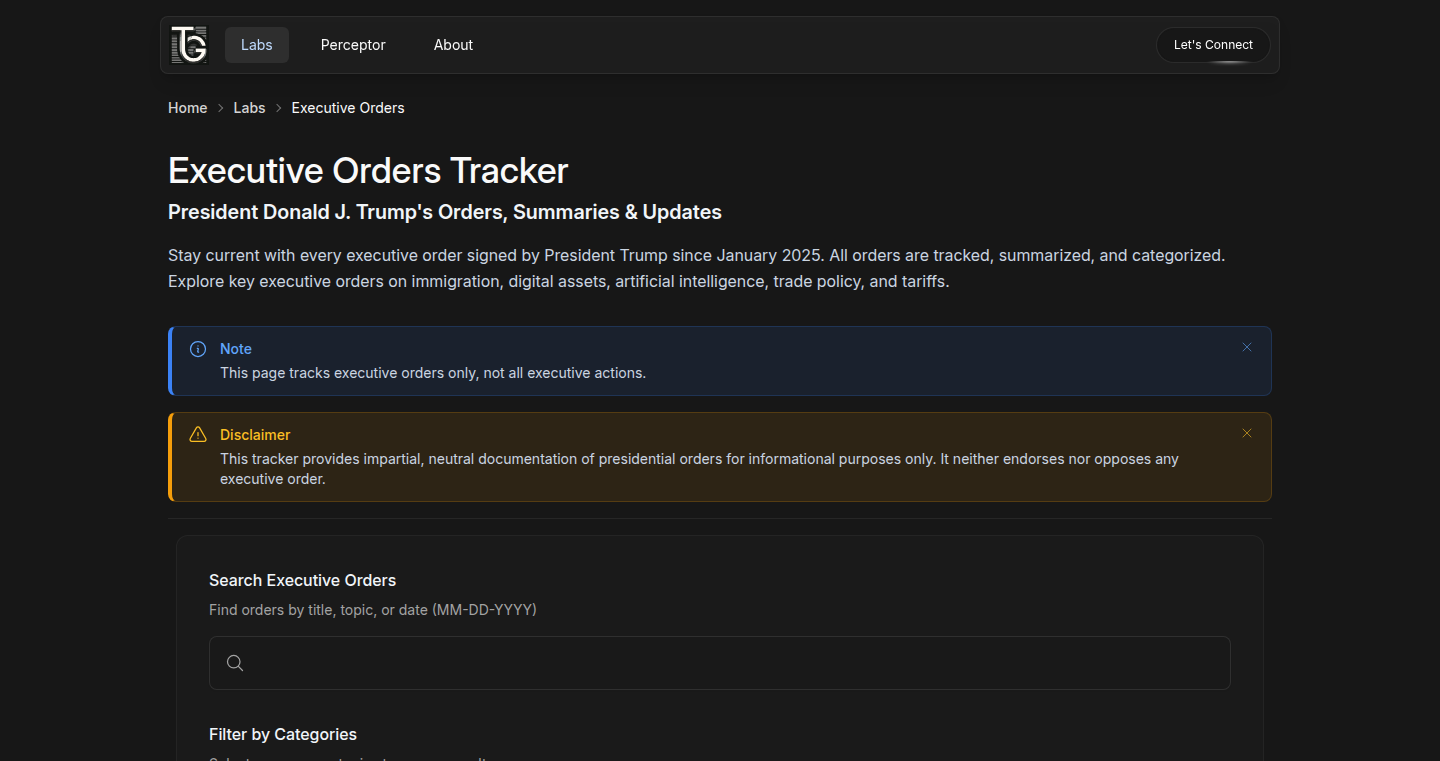
Author
LightMorpheus
Description
This project automatically tracks and summarizes US executive orders from the White House website using AI. It scrapes the site daily, feeds the text of new orders to GPT-4 for plain-English summarization and categorization, and then generates individual pages with summaries, auto-categorization, and even custom images for social media. The project addresses the problem of understanding complex legal documents by leveraging the power of AI to make the information accessible and easily digestible. So this lets you quickly grasp the essence of important policy changes without struggling through dense legal jargon.
Popularity
Points 4
Comments 0
What is this product?
This is a web application that simplifies understanding US executive orders. It works by:
1. **Scraping**: Automatically collecting executive orders from the White House website using a tool called BeautifulSoup (like a smart web robot).
2. **Summarizing**: Employing GPT-4, a powerful AI model, to condense the complex legal text into easy-to-understand summaries.
3. **Categorizing**: Using AI to automatically classify the orders by subject (e.g., immigration, trade) for easy filtering.
4. **Displaying**: Presenting each order on its own webpage, including the summary and any related details.
5. **Sharing**: Generating images automatically that are designed to work well when shared on social media.
So this allows you to stay informed about government actions in a quick and accessible way.
How to use it?
Developers can adapt this project in various ways. They could:
* **Integrate into their own news aggregators:** By using the project's scraping and summarization components.
* **Create custom dashboards:** To track specific types of orders or policy areas that interest them.
* **Build educational tools:** To help students and researchers understand the executive order process.
* **Extend for other government documents**: The underlying techniques can be generalized to other sources of legal or policy documents.
For example, a developer could use the Python scraper to fetch data, then feed the data into another LLM (large language model) for specific analysis or presentation. So you can build your own custom information tracking system.
Product Core Function
· Automated Web Scraping: The project automatically fetches new executive orders from the White House website. This involves using a web scraping library, which acts as an automated visitor to the website, collecting the necessary information. This process ensures the tracker is always up-to-date with the latest orders. So, you don't have to manually check the site for updates.
· AI-Powered Summarization: Utilizes GPT-4 to generate plain-English summaries of the executive orders. This means taking complex legal language and transforming it into easily understandable summaries. The AI handles the complex process of interpretation. So, you can quickly understand the key points of each order.
· Automated Categorization: Automatically categorizes executive orders by policy area (e.g., immigration, trade, AI) using AI. This makes it easier to find and track orders related to specific topics. So you can filter and organize the orders efficiently.
· Keyword, Date, and Category Search: Provides search functionality by keywords, dates, or categories, enabling users to quickly find specific orders of interest. This makes it easy to browse the data. So, you can easily find the information you need.
· Individual Pages with Full Text: Generates individual pages for each order, including the full text and AI-generated summaries, providing comprehensive information in one place. This means you can quickly get all the necessary information about an executive order. So, it gives you the complete picture in a convenient format.
· Automated OG Image Generation: Creates custom Open Graph (OG) images for social sharing, improving the visibility and engagement of the shared content. These images are automatically generated to make the shared content visually appealing. So your shared content looks better and gets more attention.
Product Usage Case
· A news aggregator could use the project's scraping and summarization capabilities to automatically update its coverage of executive orders. The AI summaries could be presented alongside the original text. So, the news aggregator provides up-to-date and easily digestible information.
· A policy research group could integrate the project's categorization feature to track executive orders related to specific areas of interest. The AI helps automate part of the research workflow. So, the research group can save time and focus on analysis.
· An educational platform could use the summaries and categorization to create a simple and accessible database of executive orders for students, making it easier to understand complex government actions. So, the platform creates a valuable resource for education.
· A developer could use the core scraping and summarization technology to build a similar tool for tracking regulations from other government agencies, using GPT-4 or other advanced LLMs. This extends the capability to other domains. So the developer builds a valuable tool for tracking other types of complex documents.
15
Cheesy Mamas: A Local-First Code Editor with Integrated Git and Bash Support
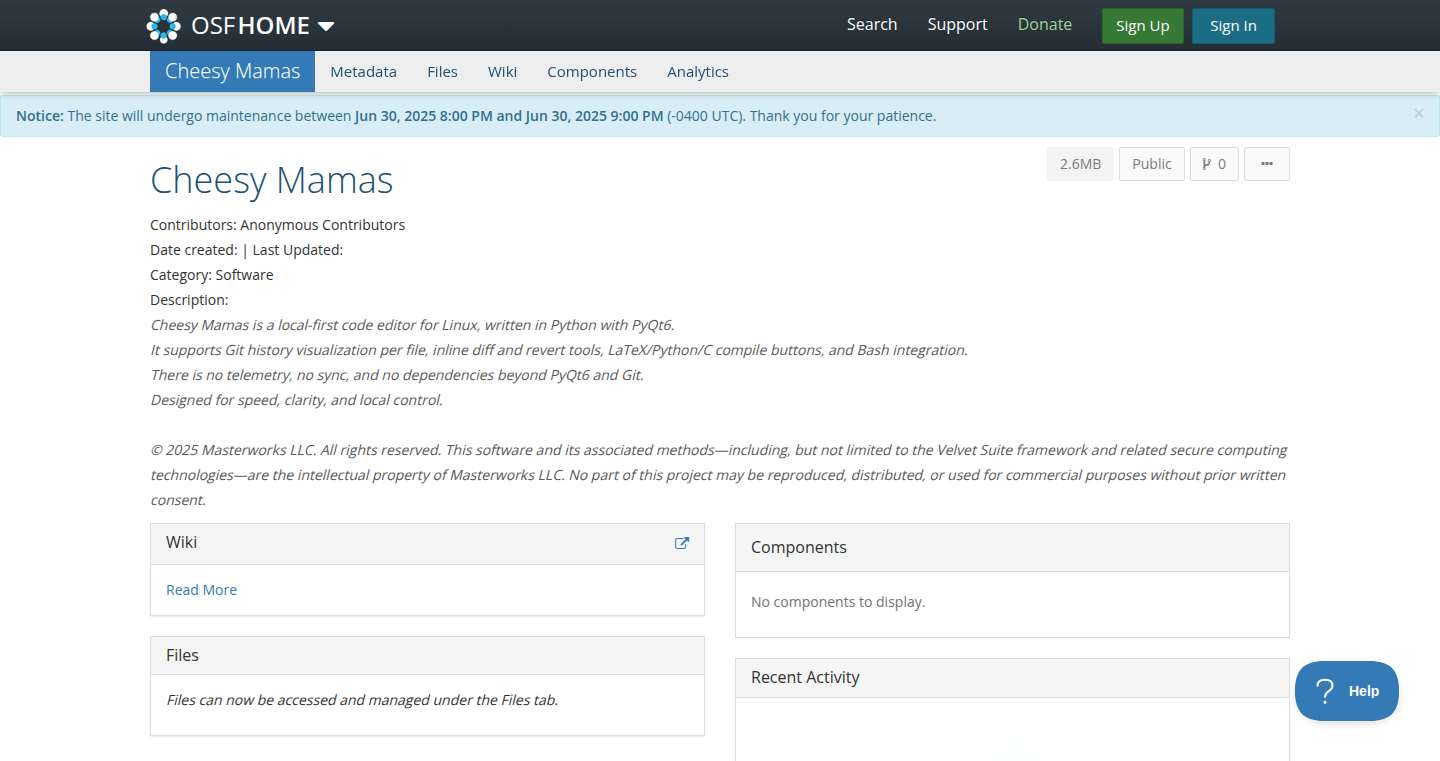
Author
LambriniWorks
Description
Cheesy Mamas is a code editor designed for Linux, focusing on local-first operation, Git integration, and simplicity. It allows users to easily manage code with built-in Git version history directly within the editor, without relying on external panels or plugins. The editor also features a built-in Bash button for scripting and executing code. This project aims to simplify the coding workflow by making version control an integral part of the editing experience, providing a transparent and controlled environment. This is all done locally, without any cloud syncing or accounts. So this allows me to have my code with its git history always present next to my code and I can easily revert code changes.
Popularity
Points 4
Comments 0
What is this product?
Cheesy Mamas is a Python-based code editor built on PyQt6, offering a streamlined experience for Linux users. The core innovation lies in its tight integration with Git. Unlike many editors that treat Git as an external tool or sidebar, Cheesy Mamas embeds Git history directly next to each open file. It retrieves the commit history for each file and allows users to view, compare, and revert changes easily. The editor also includes syntax highlighting for Python, C, and LaTeX, with built-in execution support for these languages. Furthermore, it provides a Bash button for executing or editing shell scripts. The absence of a plugin system and reliance on standard system tools enhance transparency and control. In short, this means that developers can easily track changes, revert code and execute code inside the same place: their editor.
How to use it?
Developers can use Cheesy Mamas by installing it via a shell script on their Linux system. After installation, users can open files, edit code, and use the built-in Git integration to manage version history. Clicking on a commit in the sidebar loads that specific version of the file and highlights the differences against the current version. Users can then revert individual lines or the entire file to a previous state. The Bash button allows developers to execute Python scripts, compile C code, run LaTeX files, or launch shell scripts. The editor integrates directly with standard file formats like `.py`, `.c`, `.tex`, and `.sh`, making it easy to manage different types of projects. This means a developer can have the code editor, git and bash all in one place without the need of installing different plugins or different programs.
Product Core Function
· Integrated Git History: The editor displays Git commit history directly beside each open file, enabling developers to easily view, compare, and revert changes. This eliminates the need for external Git panels or tools, streamlining the version control process. So, you can track every change without leaving your editor.
· Line-by-Line Reversion: Users can revert individual lines of code to previous versions, offering granular control over code changes. This feature is particularly useful for undoing specific modifications without affecting the entire file or needing to manage complicated diff tools. So, if you make a mistake, you can undo it without affecting the rest of the file.
· Syntax Highlighting and Execution Support: Cheesy Mamas provides syntax highlighting for Python, C, and LaTeX, along with built-in execution support for these languages. This allows developers to write, test, and compile code directly within the editor, simplifying the development workflow. So, you can write and run code in one place.
· Bash Button: The editor includes a Bash button, enabling users to execute or edit shell scripts. This feature allows developers to easily integrate shell commands and automation tasks into their coding workflow. So, you can easily use shell commands to run or edit your code.
· Local-First Operation: The editor operates entirely on the local machine without any cloud syncing or account requirements. This ensures privacy and control over code, making it suitable for sensitive projects or environments with limited internet access. So, your code is stored locally and safely.
Product Usage Case
· Software Development: A developer is working on a Python project and needs to revert a specific change made a few commits ago. With Cheesy Mamas, they can easily select the commit, view the differences, and revert only the necessary lines of code, without impacting other parts of the project. So, they can quickly go back and fix an error without messing up the rest of the code.
· Version Control and Collaboration: A team of developers collaborates on a C project, and one of them needs to understand how a specific function was implemented over time. Using Cheesy Mamas, they can browse the Git history for the file and view all changes to the function, which will enable better understanding and communication among team members. So, they can easily work together on the code, see all the changes and work faster.
· Scripting and Automation: A system administrator writes shell scripts to automate system tasks. They use Cheesy Mamas to edit and test their scripts, and with the Bash button, they can run the scripts directly from the editor. So, they can write and run the scripts in the same place, saving time and making the work easier.
· Local Code Management: A developer wants to keep their code private and avoid syncing to the cloud. They use Cheesy Mamas to manage all their projects, knowing that the code is stored locally and securely. They can use all the other git and bash features. So, the developer's code is safely and privately managed and easy to work with.
16
InfiniDesk: Project-Specific Desktop Manager for macOS
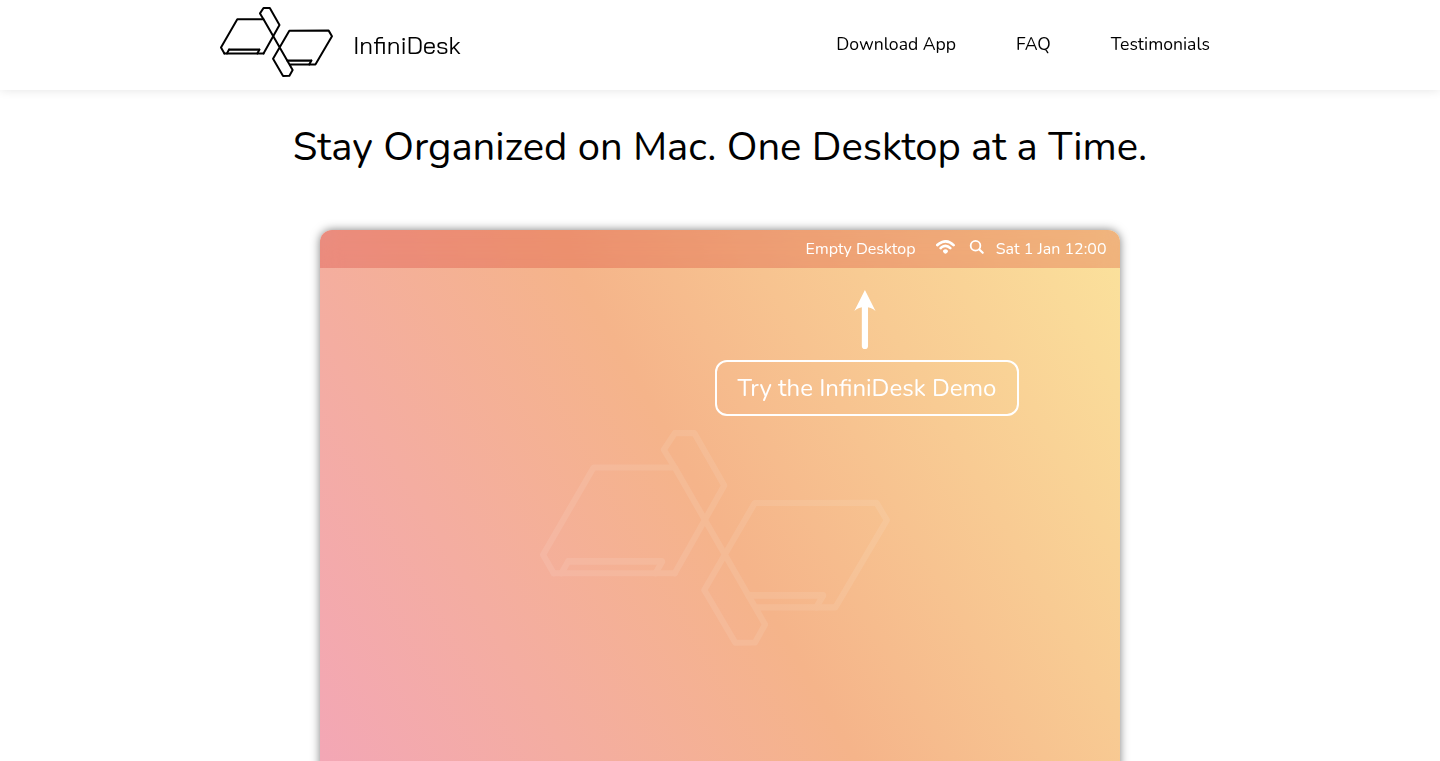
Author
ben_s_e
Description
InfiniDesk is a macOS menu bar application that allows users to rapidly switch between different sets of desktop files, tailoring the desktop environment for each project or context. This solves the problem of cluttered desktops and the challenge of context switching by creating isolated workspaces. The core innovation lies in its ability to toggle the visibility of desktop files without moving or deleting them, ensuring data safety. It also offers a clean, empty desktop view for focused work or presentations. Essentially, it's like having multiple virtual desktops tailored to your specific needs. This offers a quick, safe, and offline-friendly solution for better organization and productivity. So this is useful because it helps you stay organized, focused, and protects your data.
Popularity
Points 2
Comments 1
What is this product?
InfiniDesk is a macOS application that creates distinct desktop environments by managing the visibility of files. Instead of physically moving or deleting files, it cleverly toggles their visibility, allowing users to switch between different project-specific sets of files instantly. This is achieved through clever manipulation of the operating system's desktop file management capabilities. It's designed to be offline-first, preserving user privacy, and safe, ensuring no data loss. So it’s great for people who need to juggle multiple projects or want a clean workspace for focused work.
How to use it?
Developers can use InfiniDesk to streamline their workflow by creating separate desktops for different projects, coding environments, or tasks. For example, a developer working on multiple web development projects can set up a desktop for each project, with relevant files, documentation, and code editors visible. Switching between projects becomes a simple menu bar click. It integrates into your workflow by residing in the menu bar, allowing quick access to your saved desktop configurations. So, for developers, this means less context switching and more time coding.
Product Core Function
· Desktop Switching: Instantly switch between different configurations of visible desktop files. This reduces the time wasted in searching and organizing files for each project, thereby improving productivity. For example, rapidly switching between your work documents and a clean desktop for a presentation.
· Project-Specific Desktops: Create dedicated desktops for specific projects, allowing you to isolate files, documents, and assets relevant to a particular task. This is particularly useful for developers handling various codebases.
· Clean Desktop Mode: Provides a clean, empty desktop view for focused work, online meetings, or presentations. This feature removes distractions, improving concentration. For example, using it before a crucial online presentation.
· Offline Operation: Works entirely offline, ensuring user privacy and data safety. You don't need an internet connection to manage your desktops. This is a boon for developers working in environments with restricted internet access.
· Non-Destructive File Management: Does not move or delete files; instead, it toggles their visibility. This means your files are always safe. This reduces the risk of accidental data loss and assures peace of mind. For instance, knowing that switching desktops won't corrupt or delete any files.
Product Usage Case
· Software Development: A developer is working on three different projects: a web application, a mobile app, and a backend service. Using InfiniDesk, they create three distinct desktops, each containing files, code editors, and documentation relevant to each project. Switching between these is instantaneous. This allows for a streamlined development workflow without the clutter of multiple projects intermingling.
· Freelance Work: A freelancer manages multiple clients and projects simultaneously. They use InfiniDesk to create a desktop for each client, keeping client-specific files, contracts, and communication organized separately. This maximizes efficiency, reducing the risk of errors by keeping projects isolated.
· Academic Research: A researcher is working on multiple research papers and projects. They create dedicated desktops for each paper, storing relevant data, references, and drafts. This enables them to quickly access the information needed for each project, improving focus and productivity.
· Remote Work and Presentations: A remote worker needs to present their work. They quickly switch to a clean desktop using InfiniDesk, eliminating distractions and ensuring a focused presentation environment, increasing professionalism.
· Data Science Projects: A data scientist works on various machine learning models. They create separate desktops to store datasets, code, and experiment outputs. This maintains clarity and organization, thus accelerating project timelines.
17
120 HN: A Cross-Platform Hacker News Client with AI Integration
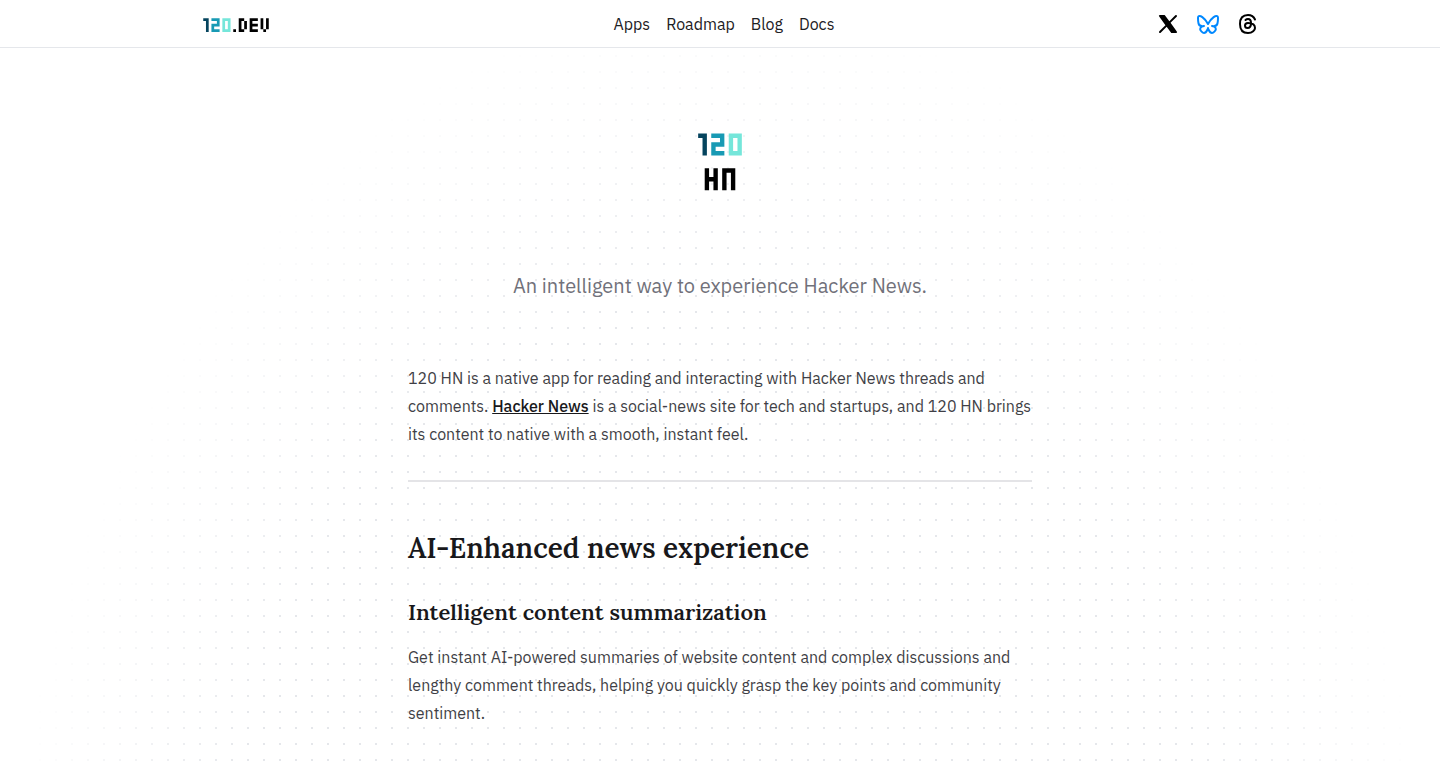
Author
120-dev
Description
120 HN is a native application designed for reading and interacting with Hacker News (HN) threads and comments across different platforms. The project distinguishes itself by allowing users to integrate their own AI API keys for features such as summarization, providing a personalized and enhanced reading experience. This addresses the challenge of efficiently navigating the vast amount of information on HN, especially for busy users who need quick summaries.
Popularity
Points 1
Comments 2
What is this product?
120 HN is a software application specifically built for accessing and interacting with Hacker News, a website popular among developers and tech enthusiasts. The core innovation is its native, cross-platform nature, meaning it works smoothly on various devices and operating systems. What makes it stand out is the integration of AI capabilities. Users can provide their own AI API keys (like from OpenAI) to leverage AI features such as automatically generating summaries of long HN threads and comments. This lets users quickly grasp the gist of discussions without reading everything. The project is an example of how to bring a community website into a modern, functional application by using native development tools with advanced AI.
How to use it?
Developers can use 120 HN as a daily tool to keep up with the latest trends and discussions in the tech world. You would download and install the application on your device (iOS, Android, etc.). After that, the app connects you to Hacker News's data. If you have an AI API key, you can enter it into the app. Then, when you view an HN post or comments, you can use the AI feature to get a summary of the main points, this feature will greatly improve your efficiency in reading and gathering information. This can be integrated as a starting point for developing your own HN client or to learn about cross-platform app development and AI integration.
Product Core Function
· Native Cross-Platform Support: The application can be used on various operating systems like iOS and Android. Value: Allows access to Hacker News on different devices. Use Case: Read Hacker News on a mobile phone or tablet.
· AI-Powered Summarization: Integrates with AI APIs to generate summaries of Hacker News threads and comments. Value: Saves time and effort by condensing large amounts of text. Use Case: Quickly understand the context and key points of complex discussions without reading every comment.
Product Usage Case
· A software engineer needs to quickly scan multiple Hacker News threads to identify emerging technologies and project announcements. Using 120 HN with AI summarization, they can rapidly filter through the content, focusing only on the most relevant discussions.
· A product manager wants to track the sentiment around a new product release mentioned on Hacker News. They can use the app to monitor the comments, and utilize the AI to understand opinions without reading every comment.
18
EliteSaaS: The All-in-One SaaS Starter Kit
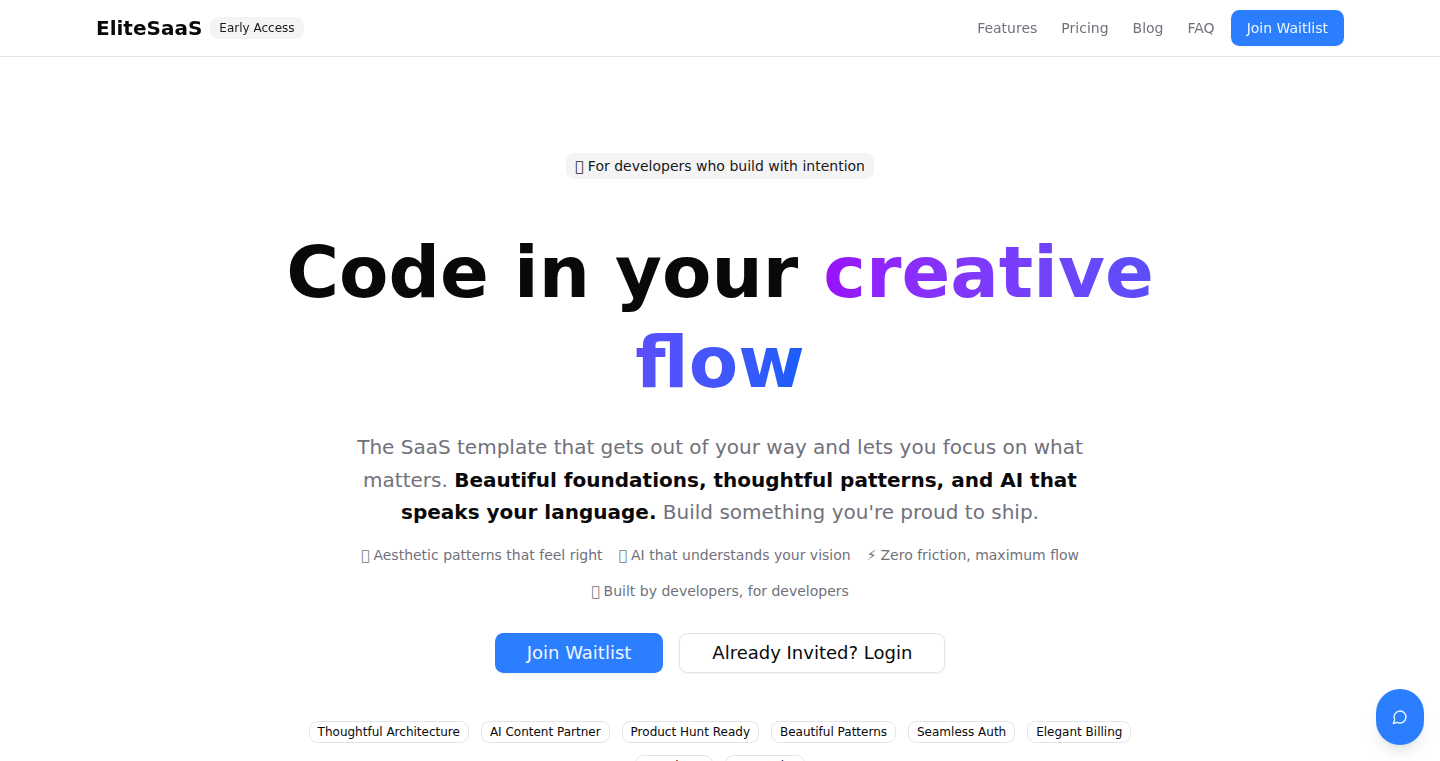
Author
eibrahim
Description
EliteSaaS is a pre-built foundation for launching Software-as-a-Service (SaaS) projects. It tackles the tedious parts of SaaS development like user authentication, billing, email management, and marketing, all in one package. The key innovation lies in its self-contained nature, integrating essential tools instead of relying on external services. This simplifies setup, reduces fragility, and lowers costs, allowing developers to focus on their core product rather than repetitive setup tasks. So this saves developers time and money by providing a ready-made platform, letting them quickly build and deploy their ideas.
Popularity
Points 3
Comments 0
What is this product?
EliteSaaS is essentially a 'starter kit' for building SaaS applications. It provides ready-to-use components for common features like user accounts, handling payments (via Stripe), managing user data, sending emails, and even generating SEO-friendly content. Instead of piecing together various services like Mailchimp or Zapier, EliteSaaS incorporates these functionalities, making it a more integrated and streamlined solution. The technical architecture relies on Next.js for the front-end, Tailwind for styling, Supabase for the database, Resend for email sending, and Vercel for deployment. This stack is known for its efficiency and developer-friendliness. So it’s like having a pre-built house frame, allowing you to start decorating and adding your personal touches immediately.
How to use it?
Developers can use EliteSaaS by downloading the code and customizing it to fit their specific SaaS project. They can adapt the user interface, modify the database schema, and adjust the integrated services like email campaigns and billing. The project is designed for easy deployment on platforms like Vercel. For example, to integrate it, you can configure the database connection details, set up your Stripe account, and personalize the email templates. So you can quickly bootstrap a project by starting with a solid base, rather than starting from scratch.
Product Core Function
· Auth, user management, and password reset: This handles user accounts, allowing people to register, log in, and recover their passwords. This removes the need to write this basic, time-consuming functionality, so you can focus on the core part of your app.
· Stripe subscriptions (recurring billing + coupons): This allows you to integrate payment processing into your application, including support for recurring payments and coupon codes. This makes it easy to start selling your SaaS product and manage customer subscriptions.
· Admin dashboard, user table, and impersonation: Provides an admin interface to manage users and view analytics, including the ability to log in as a user for troubleshooting. This helps you keep track of your user base, identify issues, and understand their experience.
· Built-in email flows and campaign manager (uses Resend): Enables you to send emails to users, including welcome messages, notifications, and marketing campaigns, all within the platform. This enables you to keep in touch with your users without external email marketing tools.
· Basic analytics: Includes basic tracking of user behavior and app usage. This helps you learn how people are using your product, so you can iterate on them and improve the platform.
· SEO + OpenGraph generator: Helps to optimize content for search engines and social media sharing by creating optimized meta tags. This allows you to get your product discoverable on search engines and generate social media buzz.
· Product Hunt + social launch content generator: Assists in generating content for launch on platforms like Product Hunt and social media. This simplifies the marketing process, so you can focus on the product itself.
Product Usage Case
· Building a new SaaS application: Developers can use EliteSaaS as the starting point for any new SaaS project, saving weeks or months of development time by skipping the boilerplate. So it quickly turns ideas into working products and reduces the time to market.
· Developing a SaaS with recurring billing: Use it to create a product that offers paid subscriptions. So you can easily start charging customers and generate revenue quickly.
· Quickly launching a minimum viable product (MVP): Use its built-in features, such as auth, billing, and basic analytics, to get a basic version of the product to market faster. So you can get user feedback rapidly and iterate on the product.
· Simplifying the development process: Eliminate the need to integrate various third-party services like Mailchimp or Zapier, as it bundles these functionalities. So you have a simpler and more reliable system to manage all of your app needs.
19
BloomPilot: AI-Enhanced Bloomberg Terminal Overlay
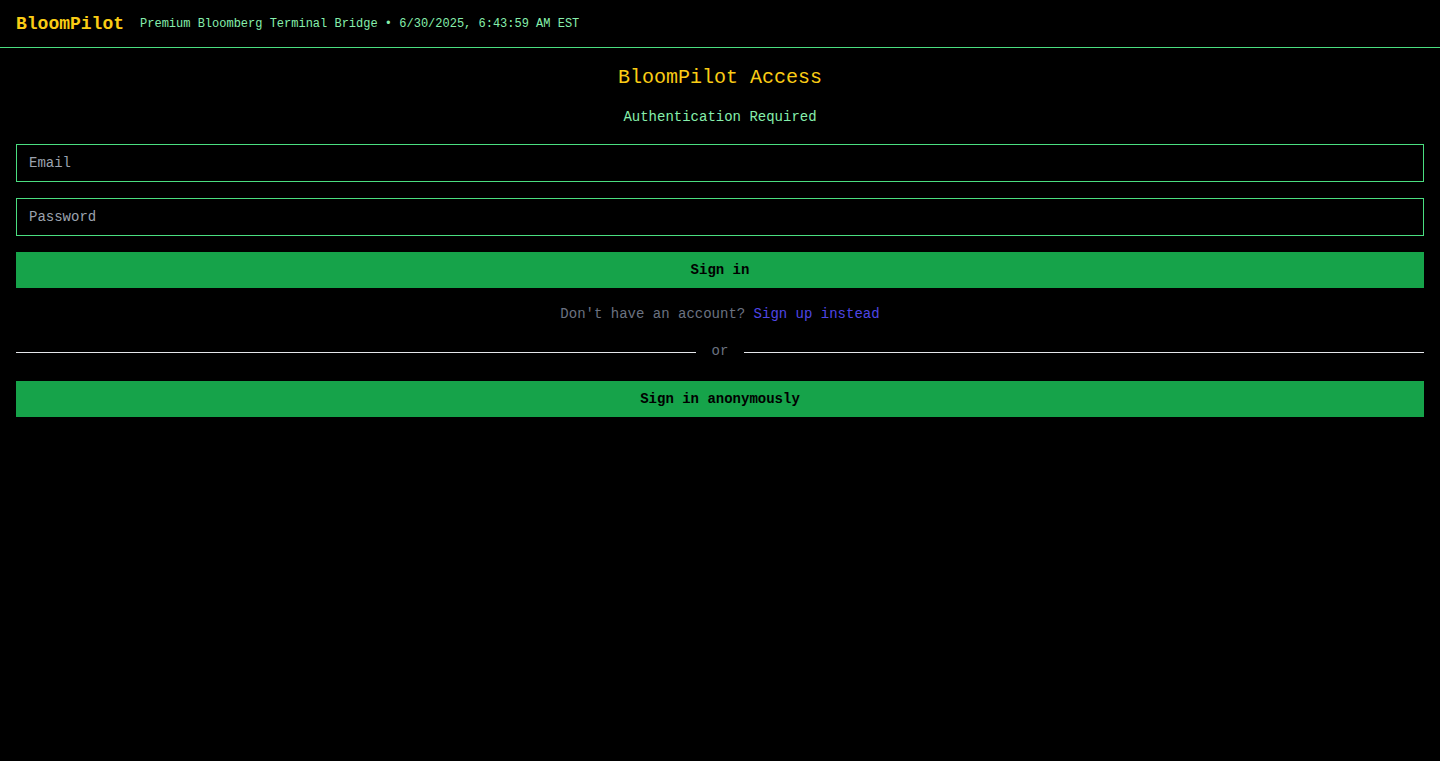
Author
symwn
Description
BloomPilot is a clever piece of software that sits on top of the Bloomberg Terminal, using the power of AI to give users quicker insights. It's designed for finance professionals, offering a more streamlined interface and modern tools to work with the Bloomberg infrastructure they already rely on. The main innovation is integrating AI, specifically GPT-4o, directly into the command line, making it easy to get smart analysis quickly. It also has built-in backup systems to get data even if the Bloomberg API is down. So, it helps users get the information they need faster and more efficiently.
Popularity
Points 2
Comments 1
What is this product?
BloomPilot is like a smart assistant for the Bloomberg Terminal. It takes the existing terminal and adds AI capabilities. It uses GPT-4o to analyze data and provide insights directly within the terminal's command line. If the usual data sources aren't available, it cleverly switches to alternatives like Alpha Vantage, Polygon, or Finnhub to keep the data flowing. So, it's like having a turbocharger for your Bloomberg Terminal, making it faster and smarter for accessing financial data and analysis.
How to use it?
Developers can't directly 'use' BloomPilot as a library or code snippet to integrate into their projects. BloomPilot is designed as a ready-to-use application for Bloomberg Terminal users. Finance professionals simply install it and start using it on top of their existing Bloomberg setup. They would interact with it through the familiar command line interface, augmented with AI-powered features. For developers, it offers inspiration for how to integrate AI into existing workflows and build user-friendly interfaces around complex tools. It demonstrates how to leverage AI for data analysis and access control using tools like Phantom wallets.
Product Core Function
· GPT-4o integration for AI-powered data analysis: This allows users to get instant, AI-driven analysis within the terminal, streamlining the research process. Application: Quickly understand complex financial data, identify market trends, and generate investment ideas. So this means quicker and better informed decisions.
· Fallback mechanisms for data retrieval (Alpha Vantage, Polygon, Finnhub): This provides continuous access to data even if the Bloomberg API is temporarily unavailable. Application: Ensures uninterrupted access to market data, crucial for timely decision-making. So you don't miss any important market changes.
· Terminal-style UI with keyboard-first design and command history: This provides a familiar and efficient interface for users accustomed to the Bloomberg Terminal. Application: Enhances user productivity and reduces the learning curve for new tools. So users can work more efficiently and comfortably.
· Real-time data streaming and AI formatting: This provides up-to-the-minute market data with AI-powered presentation. Application: Delivers the most current information in an easily digestible format, boosting decision-making. So you stay ahead of the curve.
· Wallet-based access control (Phantom wallet): This provides a secure way to manage access to the application. Application: Secures user access and simplifies payment using a Solana wallet. So your access and payments are secure and easy to manage.
Product Usage Case
· A trader uses BloomPilot to analyze a company's earnings report using the AI-powered command line. The tool quickly summarizes the report and provides insights on market impact, which saves them time and allows them to make quicker trading decisions. So they can act fast on market-moving information.
· An analyst is working in the terminal when the Bloomberg API goes down. BloomPilot seamlessly switches to alternative data sources, keeping the analyst's workflow uninterrupted and avoiding any downtime. So they can continue working without losing valuable time.
· A fintech developer sees BloomPilot and learns how to implement AI-enhanced features within existing tools by integrating GPT-4o. It provides a model for how to build an overlay that integrates with other platforms or services by using wallet based authorization, allowing secure access. So they can create smarter financial analysis applications.
20
Superclass: GPT-Powered Unstructured Data Classifier
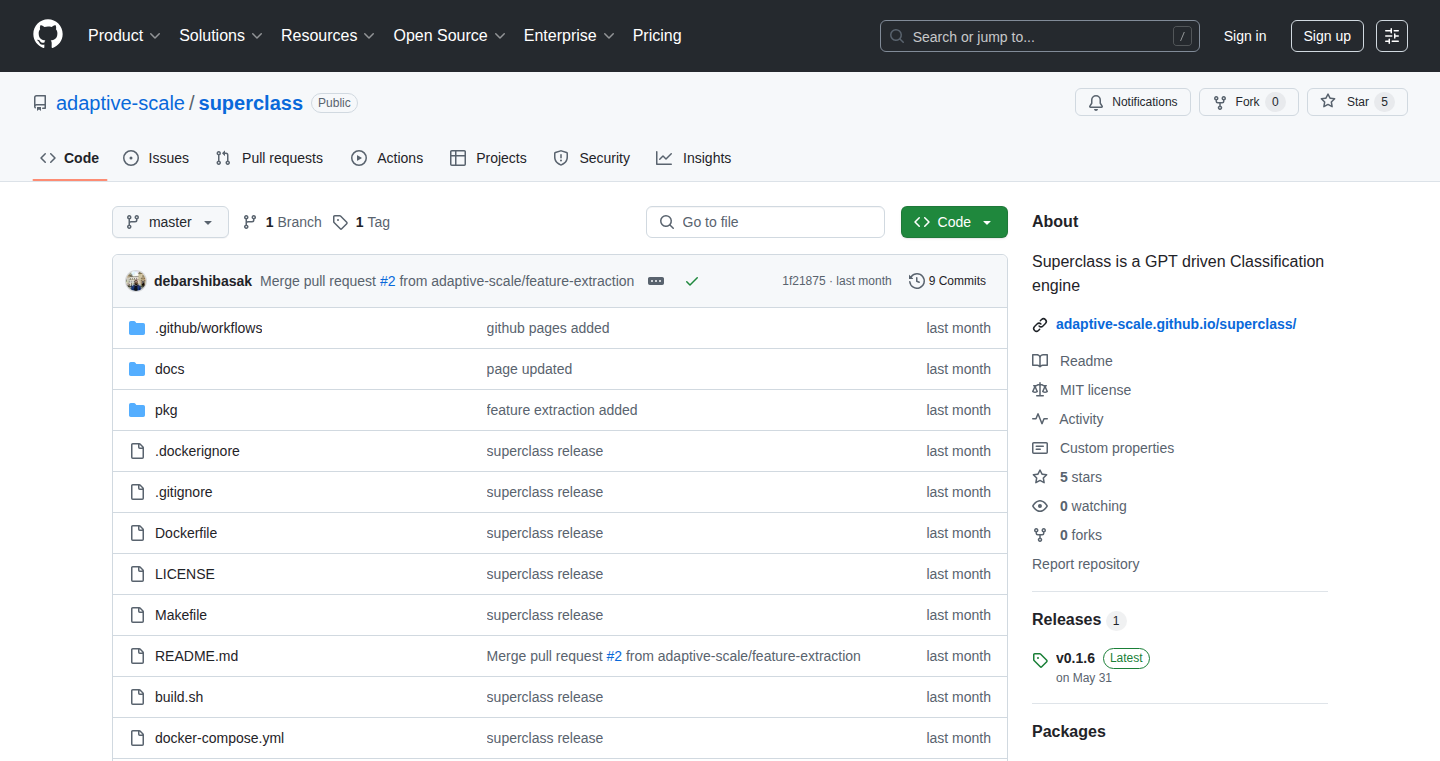
Author
debarshri
Description
Superclass is a tool that uses the power of Large Language Models (LLMs) like GPT-3, GPT-4, Claude, or Azure OpenAI to classify different types of unstructured data. This includes files such as PDFs, images, and Word documents. The key innovation is allowing users to run the classification process within their own infrastructure, giving them complete control over their data and costs. It leverages the capabilities of LLMs without relying on external, potentially insecure services, solving the problem of securely and efficiently categorizing a wide variety of data formats.
Popularity
Points 3
Comments 0
What is this product?
Superclass takes unstructured data, which is essentially any data that doesn't fit neatly into a database (like text in a document, the content of an image, or a PDF file), and categorizes it. It achieves this by using the power of LLMs to understand the content of the data and assign it to predefined categories. The project is unique because it allows users to use their own API keys from OpenAI, Claude, or Azure OpenAI, meaning they can run the classification on their own servers and keep their data private. So this allows you to use advanced AI models for data classification without giving away your sensitive information and save money.
How to use it?
Developers can integrate Superclass into their existing workflows by providing their API keys and pointing the tool towards the data they want to classify. It can be used with different data types, from documents to images. This is typically integrated via API calls or command-line tools, fitting seamlessly into data processing pipelines. For example, developers working on document management systems can classify documents by content type (e.g., invoices, contracts, reports). Or, developers building search engines can use it to categorize images, making them searchable by content. So, you can easily understand and categorize your data using the power of LLMs.
Product Core Function
· Unstructured Data Classification: This is the core function; it takes input data in various formats and uses an LLM to categorize it. This is useful for automatically organizing and understanding large datasets of diverse content, like automatically sorting customer emails based on their intent (e.g., support requests, sales inquiries).
· Customizable LLM Integration: Allows users to use their own OpenAI, Claude, or Azure OpenAI keys, providing flexibility and cost control. This empowers users to choose their preferred LLM provider and manage their spending, for example, allowing a company to switch to a cheaper model or use a more capable one as needed.
· On-Premises Data Processing: Data processing happens within the user's infrastructure, ensuring data privacy and control. This is highly important for organizations dealing with sensitive information, allowing them to comply with data privacy regulations, like in the case of financial institutions that classify documents containing financial data.
· Support for Various File Types: The tool supports a wide range of file types, including PDFs, images, and DOCX files, making it a versatile solution for handling various data formats. This means it is suitable for a diverse set of applications, such as classifying research papers from a variety of publishers regardless of the file format.
· Integration with Data Scanning Tools: Superclass is designed to work with data scanning tools (like superscan mentioned in the description), providing a comprehensive solution for unstructured data management. This allows users to automate the entire process from data ingestion to classification. For example, integrating with superscan would allow a legal firm to automatically categorize all new documents in their systems, helping them quickly find relevant information during investigations.
Product Usage Case
· Legal Document Management: A law firm uses Superclass to automatically classify legal documents (contracts, briefs, etc.) based on their content. The system drastically reduces the time spent on manual document review and improves search capabilities, allowing lawyers to quickly find the documents they need. So this automates a time-consuming task, saving time and improving efficiency.
· E-commerce Product Categorization: An e-commerce company uses Superclass to categorize product descriptions extracted from various files (product manuals, descriptions from suppliers). The system helps organize products into relevant categories, improving the customer shopping experience and SEO. So this improves product organization, making it easier for customers to find products and for search engines to index the site.
· Research Paper Organization: A research institution uses Superclass to classify research papers from various sources based on their topic and type. This helps researchers quickly find relevant papers and facilitates the building of knowledge bases. So this accelerates research by making it easier to organize and access information.
· Customer Support Ticket Automation: A company integrates Superclass into its customer support system to automatically categorize incoming support tickets based on their content. This allows the company to route tickets to the correct department and prioritize urgent requests. So this improves customer service response times and ensures issues are handled efficiently.
21
Social Harm Economic Impact Calculator

Author
avi21218
Description
This project is an interactive calculator that estimates the economic impact of social media's negative effects, like mental health problems and societal division. It works by letting users input data from peer-reviewed research papers and then instantly calculating the financial consequences. It aims to make the hidden costs of social media visible and understandable, providing insights into the real-world impact of online platforms. So this is useful because it helps quantify the negative effects of social media, making it easier to understand and address these problems.
Popularity
Points 2
Comments 0
What is this product?
It's a web-based calculator that takes data from scientific studies about social media's harms and translates it into economic terms, showing the costs of things like mental health treatment and lost productivity. It uses a transparent methodology, allowing users to adjust the inputs and see how the results change. It's innovative because it uses a real-time approach to visualize the economic impact of social issues. So this is useful because it offers a clear, data-driven way to grasp the financial repercussions of problems caused by social media, making it easier to grasp the problem.
How to use it?
Developers can use this calculator by integrating its underlying data and methodology into their own analysis tools or dashboards. They could also use it to create visualizations for research reports or advocacy campaigns. For example, a developer might use the calculator's logic to build a tool that forecasts the potential economic benefits of reducing social media's negative effects. So this is useful because it helps developers understand the economic impact of social media’s harms and integrates that understanding into their own projects.
Product Core Function
· Real-time Economic Impact Calculation: The core function instantly calculates economic costs based on the data entered from studies. This provides immediate feedback on the financial implications of different social media harms.
· Transparent Methodology: Users can see the calculations and adjust variables to understand how assumptions affect the outcomes. This transparency boosts the credibility of the results and allows users to explore different scenarios.
· Data Input from Peer-Reviewed Papers: The calculator uses data extracted from scientific papers, providing a basis in credible research. This feature provides the calculator with a base of reliability.
· User-Adjustable Multipliers: Users can adjust key factors to see how sensitive the calculations are to different inputs. This allows users to assess the impacts of various assumptions, and see how the results change. This is useful because it provides users with the chance to see their own input on the results and understand the problem better.
Product Usage Case
· Research Analysis: Researchers can use the calculator to quickly estimate the economic cost of a specific social media impact, like youth mental health issues. This would help them understand the full implications of their study findings and provide better context for public discussion.
· Policy Advocacy: Advocacy groups can use the calculator to illustrate the economic benefits of policies that mitigate social media's harms. The calculator can show the potential savings from reducing mental health issues or improving productivity. This gives stakeholders a clearer view of the financial costs and benefits of different policies.
· Educational Tool: Educators can integrate the calculator into social science or economics lessons to demonstrate the broader impacts of social issues. Students can experiment with inputs and assumptions to see the consequences of different scenarios. It is useful because it helps to better teach students about real-world economic issues.
22
N8n Copilot - AI-Powered Workflow Automation Assistant
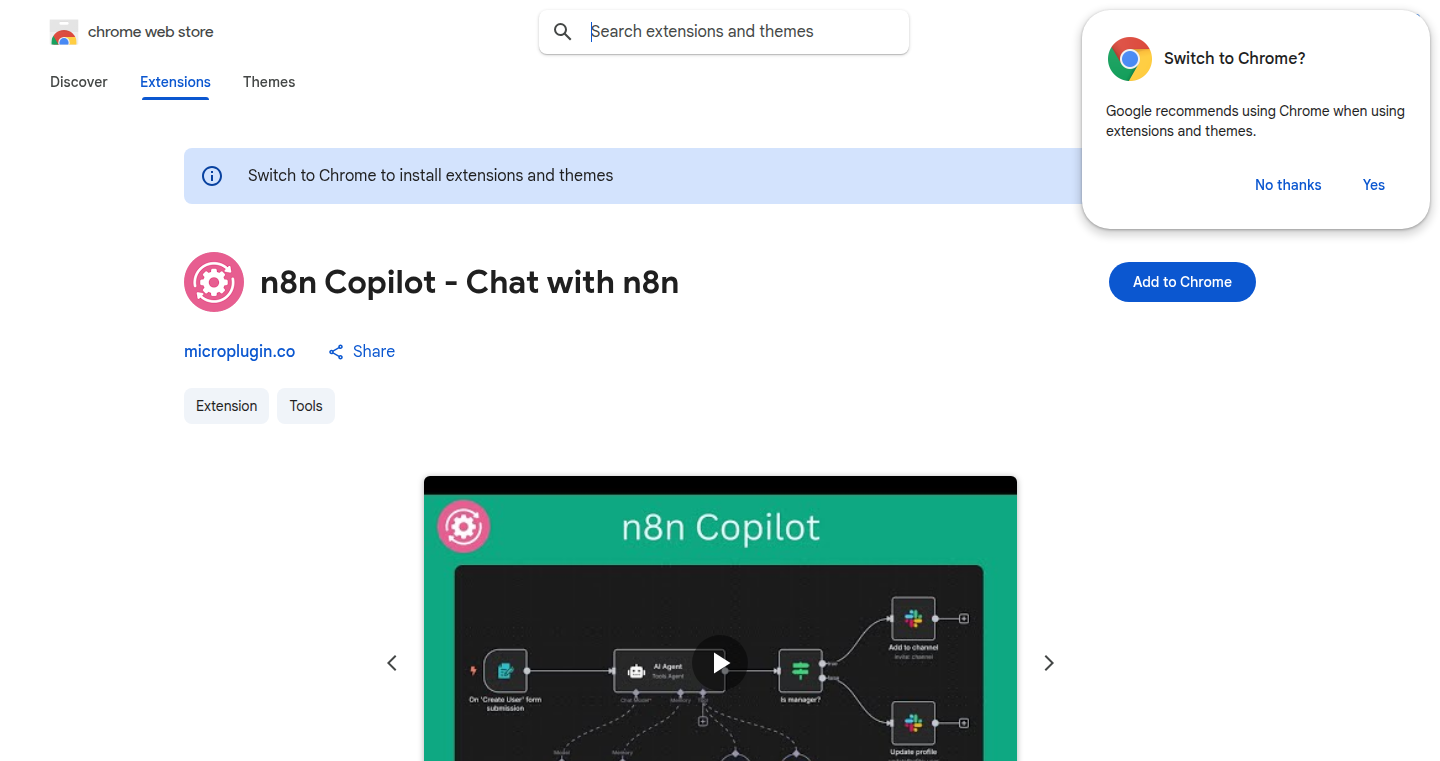
url
Author
qwikhost
Description
N8n Copilot is a Chrome extension that uses artificial intelligence (AI) to help users build, modify, and troubleshoot workflows within the n8n automation platform. It allows users to interact with the platform using natural language, simplifying the automation process and making it accessible to both beginners and experienced users. This innovative approach streamlines workflow creation, reduces the learning curve, and enhances the overall automation experience. So, this allows anyone to automate tasks without deep technical knowledge.
Popularity
Points 2
Comments 0
What is this product?
N8n Copilot is essentially an AI-powered chatbot that acts as your automation sidekick for the n8n platform. When you're building workflows, instead of clicking through a complex interface, you can simply tell the Copilot what you want to do. Behind the scenes, it uses advanced AI to understand your instructions, then translates those instructions into the steps necessary to automate your tasks within n8n. It's like having a coding expert that speaks in plain English. So, this removes the technical barriers of automation.
How to use it?
You can install the N8n Copilot as a Chrome extension and use it directly within the n8n interface. You can simply chat with the Copilot, describe what you want to automate (e.g., "Send an email when a new lead is added to my CRM"), and it will help you construct the workflow step-by-step. It can also help you debug existing workflows if they are not working correctly. So, this gives you a conversational way to build and manage your automated processes.
Product Core Function
· Natural Language Workflow Creation: Users can describe their automation goals in plain language, and the Copilot translates these descriptions into functional workflows. This drastically simplifies the process, making it easier for non-technical users to build complex automations. For example, you can ask Copilot to create a workflow to send a Slack message when a new order comes in. So, this allows you to create automation workflows without writing any code.
· Workflow Editing and Modification: The Copilot allows users to easily edit and modify existing workflows. By using natural language prompts, users can modify steps, add new features, and troubleshoot existing automation logic. This streamlined approach reduces the time needed to debug and update workflows. For example, you can tell the Copilot to "Add a filter to only send emails to VIP customers". So, this gives you a way to modify and fine tune your workflows with ease.
· Workflow Debugging and Problem Solving: When a workflow isn’t functioning as expected, the Copilot can help diagnose and resolve the issues. By analyzing the workflow logic and user inputs, it can provide suggestions, identify errors, and offer fixes. This significantly reduces the time spent troubleshooting automation issues. For example, if an automation isn't sending email, Copilot can help you locate if there is some setup issue. So, this will help to solve any errors or problems that your automations have.
· Integration with n8n: The Copilot is specifically designed to integrate with the n8n automation platform. It leverages the capabilities of n8n to automate a wide range of tasks and streamline different processes. This focus on integration ensures compatibility, reliability, and ease of use within the n8n ecosystem. For example, integrate your CRM, marketing automation tools, and any service that n8n supports with just a chat. So, this will help you use n8n more easily and effectively.
Product Usage Case
· E-commerce Automation: A small business owner can use the Copilot to create a workflow that automatically sends a welcome email to new customers, adds them to a mailing list, and updates their CRM. This eliminates the need for manual data entry and reduces time spent on repetitive tasks. So, this automates customer onboarding and improves efficiency.
· Marketing Automation: A marketing team can use the Copilot to build a workflow that automatically posts updates to social media, schedules emails, and tracks campaign performance. This automates repetitive marketing tasks and improves team efficiency. For example, when you upload a new blog post to your website, N8n Copilot can automatically publish it across various social media platforms. So, this helps streamline your marketing campaigns.
· Customer Support: A customer support team can use the Copilot to build workflows that automatically respond to common inquiries, route support tickets, and create reports. This automates manual tasks and improves team efficiency. For example, when a customer sends an email with questions, the Copilot can automatically collect the relevant details to help the service team. So, this helps provide more efficient customer support.
23
VaultGuard: Local Secrets Manager with Seamless Backup
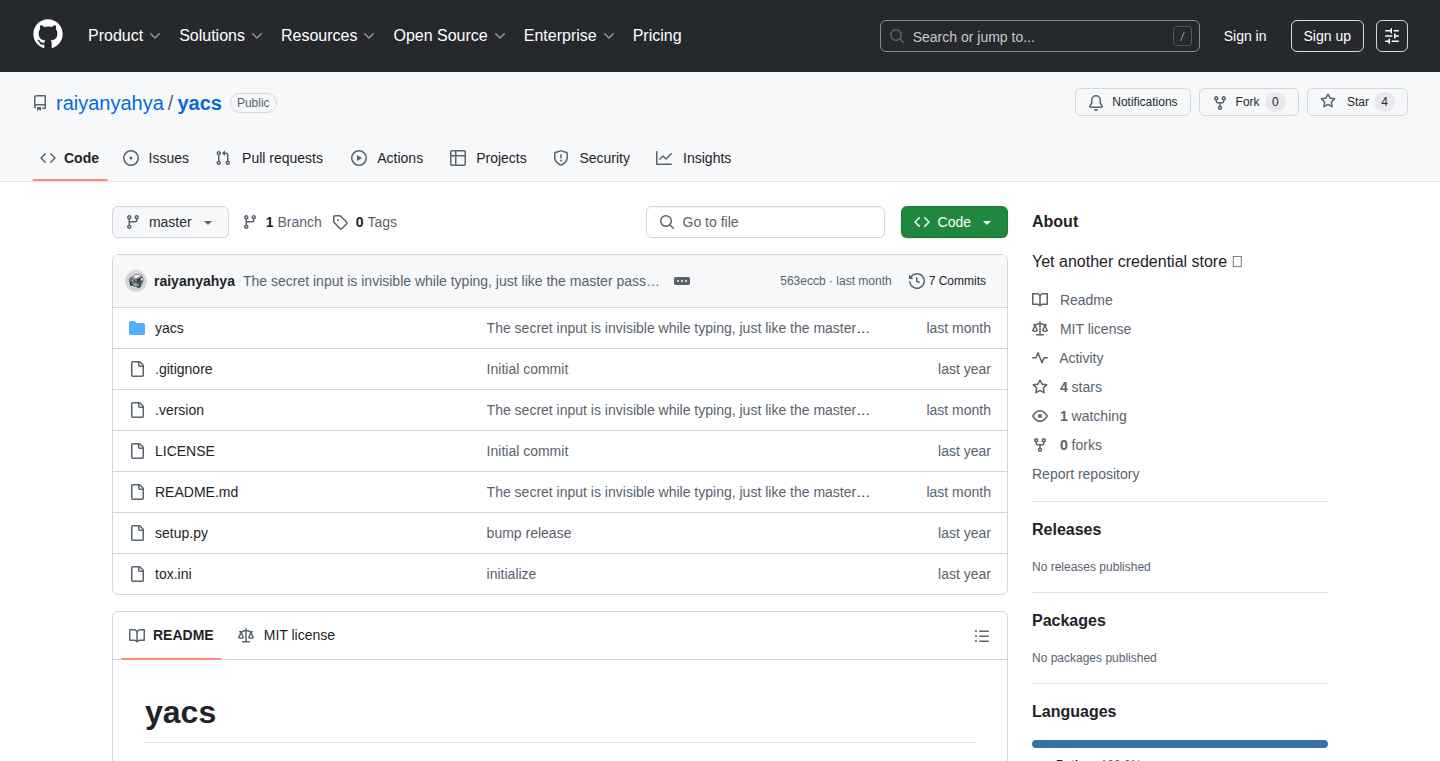
Author
RaiyanYahya
Description
VaultGuard is a local secrets manager, allowing developers to securely store and manage sensitive information like API keys and passwords on their own computers. The key innovation is the easy, encrypted backup feature, providing a safety net against data loss. It solves the problem of keeping secrets safe and accessible while preventing data breaches due to poor security practices or accidental data loss.
Popularity
Points 2
Comments 0
What is this product?
VaultGuard is like a safe for your computer's secrets. It uses strong encryption to protect your passwords, API keys, and other sensitive data. The cool part is its built-in backup feature. Think of it as a digital duplicate of your secrets, safely stored elsewhere. If your computer breaks or you accidentally delete something, you can easily restore your data. This uses a combination of cryptography (like AES encryption) and file storage to create a secure and reliable system. So, it allows you to keep your secrets safe from prying eyes and ensures you don't lose them.
How to use it?
Developers can use VaultGuard by first installing the application. Then, they add their secrets - for example, an API key for Twitter or a password for a database. VaultGuard encrypts each secret before storing it. The backup feature allows developers to create an encrypted copy of their secrets to a chosen location (like a cloud storage service or an external drive). If needed, the developer can then restore the secrets from the backup. This can be integrated in your development workflow by storing your secrets in VaultGuard and referencing them in your code. For example, you can retrieve an API key directly from VaultGuard when your application needs it, allowing you to use the same API key and ensure your application keeps working.
Product Core Function
· Secure Secret Storage: VaultGuard encrypts each piece of sensitive information using strong encryption algorithms. This ensures that even if someone gains access to the stored data, they cannot read the actual secrets. So this is useful to keep your API keys, passwords, and tokens hidden from anyone else.
· Encrypted Backup: VaultGuard creates encrypted backups of the stored secrets. These backups are stored in a safe and secure location. This protects against data loss due to hardware failure or accidental deletion. This feature is beneficial to protect you from losing everything.
· Easy Restoration: If data is lost, it provides an easy way to restore the secrets from a backup. This minimizes downtime and avoids the need to manually re-enter all secrets. So this is useful to ensure you can get back on track quickly if something goes wrong.
· User-Friendly Interface: The application likely includes a simple interface for adding, managing, and retrieving secrets, making it easy for developers to use. So it's useful because it means you can easily store and retrieve your sensitive data without a lot of technical knowledge.
Product Usage Case
· Protecting API Keys in Development: A developer is working on an application that uses several third-party APIs. Using VaultGuard, the developer can securely store their API keys and then retrieve them when needed by the application. The API keys will be safe from the prying eyes even if the device is stolen or compromised. If the developer loses their computer, they can restore the API keys from a backup, saving time and effort.
· Managing Passwords Across Multiple Projects: A developer is working on multiple projects, each with its own set of passwords and credentials. VaultGuard helps in safely storing and retrieving all the credentials for each project. If a project’s credentials get leaked or compromised, you can easily change the password without affecting the other projects. If the device is compromised or data is lost, restoration is made easy from the backup.
· Securing Configuration Data: A developer needs to store and manage sensitive configuration data for their application. By using VaultGuard, the developer can store this sensitive configuration data like database connection strings securely. This data can be stored safely and retrieved easily whenever your application needs it. The backed up data can be restored from the backup, ensuring that the application can quickly recover when data loss happens.
24
Multiplayer Minesweeper: A Synchronized Grid Experience
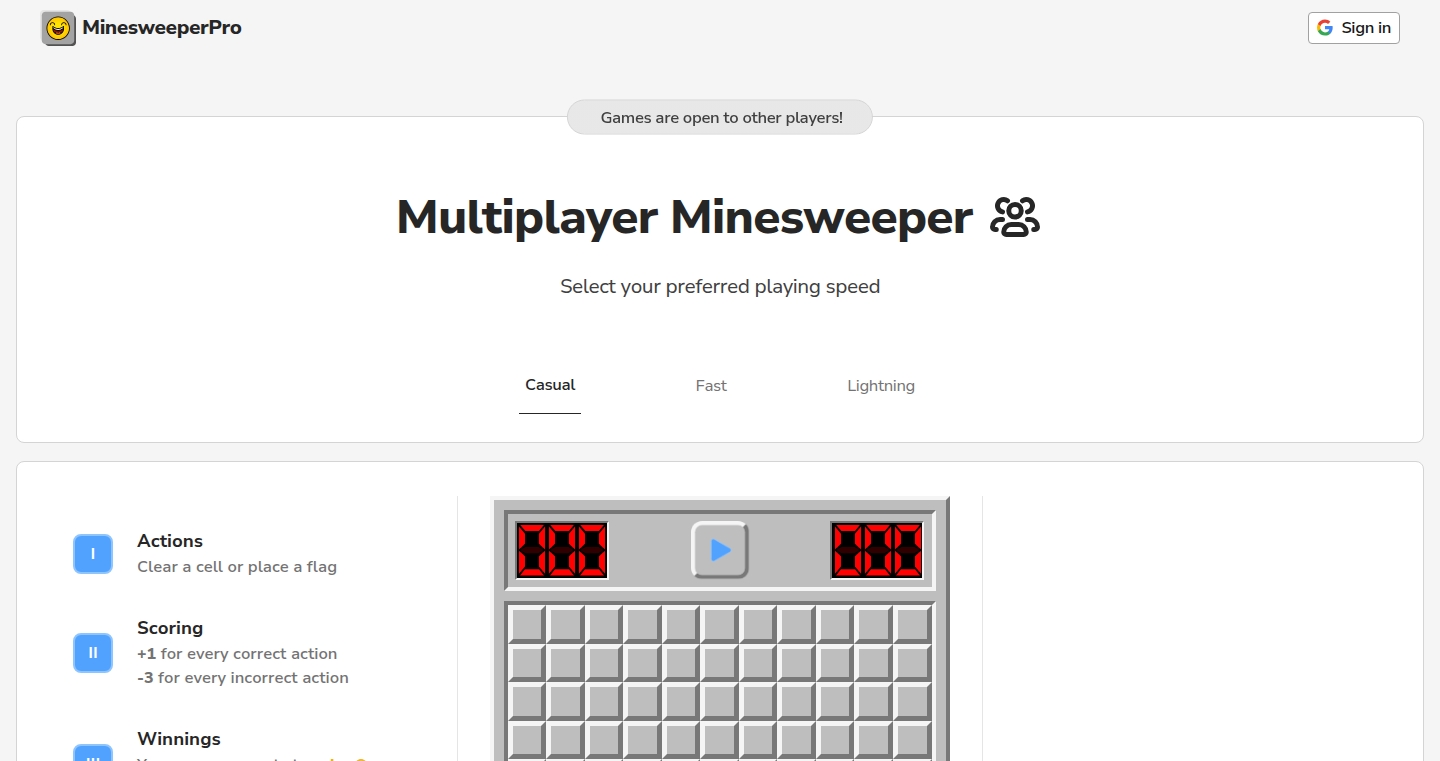
Author
bluelegacy
Description
This project reimagines the classic Minesweeper game by turning it into a multiplayer experience. The core innovation lies in its real-time synchronization of the game board across multiple players. It addresses the limitations of traditional single-player Minesweeper, fostering collaborative or competitive gameplay using a shared game state and a simple, intuitive interface. So, it allows you to play Minesweeper with friends, adding a new layer of interaction and fun to a familiar game.
Popularity
Points 1
Comments 1
What is this product?
Multiplayer Minesweeper is a web-based implementation of the classic game, but with a crucial difference: it allows multiple players to interact with the same game board simultaneously. The core technology here is likely a combination of client-side JavaScript (for the game's UI and user interaction) and a server-side component (possibly using WebSockets or similar technology) for handling the real-time synchronization of the game state. Every move – revealing a cell, placing a flag – is immediately reflected on all players' screens. This design challenges the single-player paradigm and creates a new dimension for playing the game, adding real-time interactivity. So, you're no longer alone; you're playing with friends.
How to use it?
Developers can likely integrate this Multiplayer Minesweeper into their own web applications, perhaps as a mini-game or a framework for other real-time, collaborative experiences. The project's open-source nature would potentially allow for easy customization and extension. You might be able to use it by embedding the game into your webpage or using its core logic to create a multiplayer game with similar mechanics. So, you can create your own multiplayer games with real-time synchronization.
Product Core Function
· Real-time board synchronization: The system ensures that all players see the same game board and all moves are updated in real time. Value: Provides a shared game state, enabling collaborative and competitive gameplay. Application: Creating synchronized experiences for any game.
· Grid options: Offers different grid layouts and playing speeds. Value: Provides flexibility in terms of game difficulty and style of play. Application: Tailoring the game experience for various users.
· Scoring system: Tracks correct and incorrect moves. Value: Introduces a way to measure a player's performance. Application: Adding a measure of accountability for players.
· Flagging functionality: Allows players to mark cells. Value: Facilitates strategic gameplay. Application: Allowing players to add strategy to a game.
· Chording: Enables players to click on numbered cells for efficiency. Value: Provides efficiency and a smoother gameplay experience. Application: Making the game more convenient to play.
Product Usage Case
· Integrating into a social platform: A social media platform could include this game as a fun activity for users to play with their friends in real-time. The shared board and real-time interaction elements would make it engaging. So, users would have a shared activity that they can engage in in real time.
· Education and training: The underlying real-time synchronization technology could be adapted for educational applications. Imagine a collaborative math puzzle where students solve equations together, with their progress synchronized in real-time. So, this can be used to create a collaborative learning environment for students.
· Building collaborative project management tools: The real-time synchronization concept could be expanded to task management tools, where team members see and interact with a project's progress in a shared view. So, this will allow multiple people to engage with a single project, allowing real-time collaborations.
25
NetNerve: AI-Powered Network Traffic Translator
Author
bhatshubham
Description
NetNerve is a tool that uses Artificial Intelligence (specifically, LLaMA-3) to analyze network traffic data from .pcap files and translate it into easy-to-understand, plain English explanations. It helps users understand what's happening in their network without needing to be a network expert. This project addresses the problem of complex network analysis, making it accessible to a wider audience by simplifying the process of interpreting raw network data. It's a privacy-focused solution, processing files in memory without storing them.
Popularity
Points 2
Comments 0
What is this product?
NetNerve takes .pcap files, which are essentially recordings of network traffic, and uses an AI model (LLaMA-3) to understand the data. Instead of showing you technical jargon, it gives you clear, human-readable explanations of what's going on in your network. So, instead of looking at confusing TCP flags and port numbers, you get insights like 'A suspicious connection attempt was detected from this IP address' or 'A file transfer was initiated.' The innovation lies in applying AI to automate and simplify the analysis of network data, making it easier for anyone to understand network behavior and potential security issues.
How to use it?
Developers can use NetNerve by uploading their .pcap or .cap files (up to 2MB) to the web interface. The system then processes the data and presents the analysis in plain English. This is useful for anyone who needs to analyze network traffic, such as security professionals, network administrators, or even developers trying to debug network-related issues. You could integrate it into your security workflow for quick analysis or use it to learn about network behavior. You can also use it to debug your own network-based applications.
Product Core Function
· AI-Powered Packet Analysis: It uses AI to analyze network traffic data, providing human-readable explanations. This makes network analysis accessible to non-experts, saving time and effort.
· Plain English Explanations: The tool translates complex technical data into easy-to-understand language. This helps users quickly grasp the meaning of network events without needing specialized knowledge.
· Privacy-Focused Architecture: Files are processed in memory and never stored, ensuring data privacy. This is crucial for users concerned about the security of their network data.
· Supports .pcap/.cap Files: It supports standard network capture file formats, allowing users to analyze data from various sources such as network monitoring tools and packet sniffers.
Product Usage Case
· Security Incident Investigation: A security analyst can upload a .pcap file captured during a suspected security breach. NetNerve can analyze the traffic and provide clear explanations of suspicious activities, such as unauthorized access attempts or data exfiltration, helping the analyst to quickly identify and address the problem.
· Network Troubleshooting: A network administrator can use NetNerve to analyze network traffic during a performance issue. The tool can identify bottlenecks, unusual traffic patterns, or protocol errors, helping the administrator diagnose and resolve the issue faster.
· Application Debugging: A developer can use NetNerve to analyze network traffic generated by their application during testing. This can help them identify network-related bugs, such as slow response times or incorrect data transmissions, allowing them to improve the application's performance and reliability.
26
Automated Startup Mentor: AI-Powered Advice Engine

Author
vednig
Description
This project leverages the power of AI to provide automated startup advice, specifically focusing on insights and guidance derived from Paul Graham's essays. It addresses the challenge of accessing and interpreting valuable startup wisdom efficiently, offering an intelligent, searchable, and contextually relevant resource for entrepreneurs. It’s essentially an AI-powered expert on startup advice, allowing users to get quick answers and insights from a vast repository of knowledge.
Popularity
Points 2
Comments 0
What is this product?
This project uses Natural Language Processing (NLP) and Machine Learning (ML) techniques to analyze and synthesize information from Paul Graham's essays and other relevant startup resources. The AI engine understands the context of your questions and provides tailored advice, drawing from the extensive knowledge base. It’s like having an AI-powered startup consultant that understands the nuances of business and technology. So this is useful because it saves you time by quickly giving you relevant answers.
How to use it?
Developers can interact with the AI through a web interface or potentially integrate it into their own applications via an API. You could ask questions like: "How do I find a co-founder?" or "What are the key aspects of building a Minimum Viable Product (MVP)?" The system would analyze your query and provide an answer backed by the knowledgebase. Think of it as a smart search engine for startup advice. So you can learn and build faster.
Product Core Function
· Intelligent Question Answering: The system analyzes natural language questions about startups and provides relevant advice, ensuring that the information is tailored to the user's needs. This is useful because it allows users to quickly get answers to their most pressing startup questions.
· Contextual Understanding: The AI engine understands the context of questions, allowing it to provide more accurate and relevant advice by understanding the implied meaning of the query. This is useful for avoiding misunderstandings.
· Knowledge Base Search: The system searches a curated database of startup advice to give the user the most relevant information. Useful for quickly finding answers in a sea of information.
· Automated Summarization: The engine can summarize complex concepts, providing users with concise and actionable insights. Useful for quickly getting to the core of a topic.
· Knowledge Synthesis: Combines various startup advice to create a comprehensive answer that will better serve the user. This is useful because it provides complete answers to complex problems.
Product Usage Case
· Startup Founders: A founder can use the system to gain quick insights on topics such as fundraising, product development, and team management. The AI can provide answers that help the founder make quick decisions.
· Aspiring Entrepreneurs: Individuals considering launching a startup can use the system to learn the core principles of building a successful company. This is helpful because the system breaks down complex information in an easy to understand manner.
· Incubators and Accelerators: These organizations can use the system to provide their cohort of startups with easy access to useful advice. It's useful for rapidly providing advice across many different startups.
· Product Managers: The AI can offer insights on effective product development strategies. Useful for those building new products from scratch, providing a source of best practices.
27
MethodFlow: Visual Dependency Explorer for C# and TypeScript
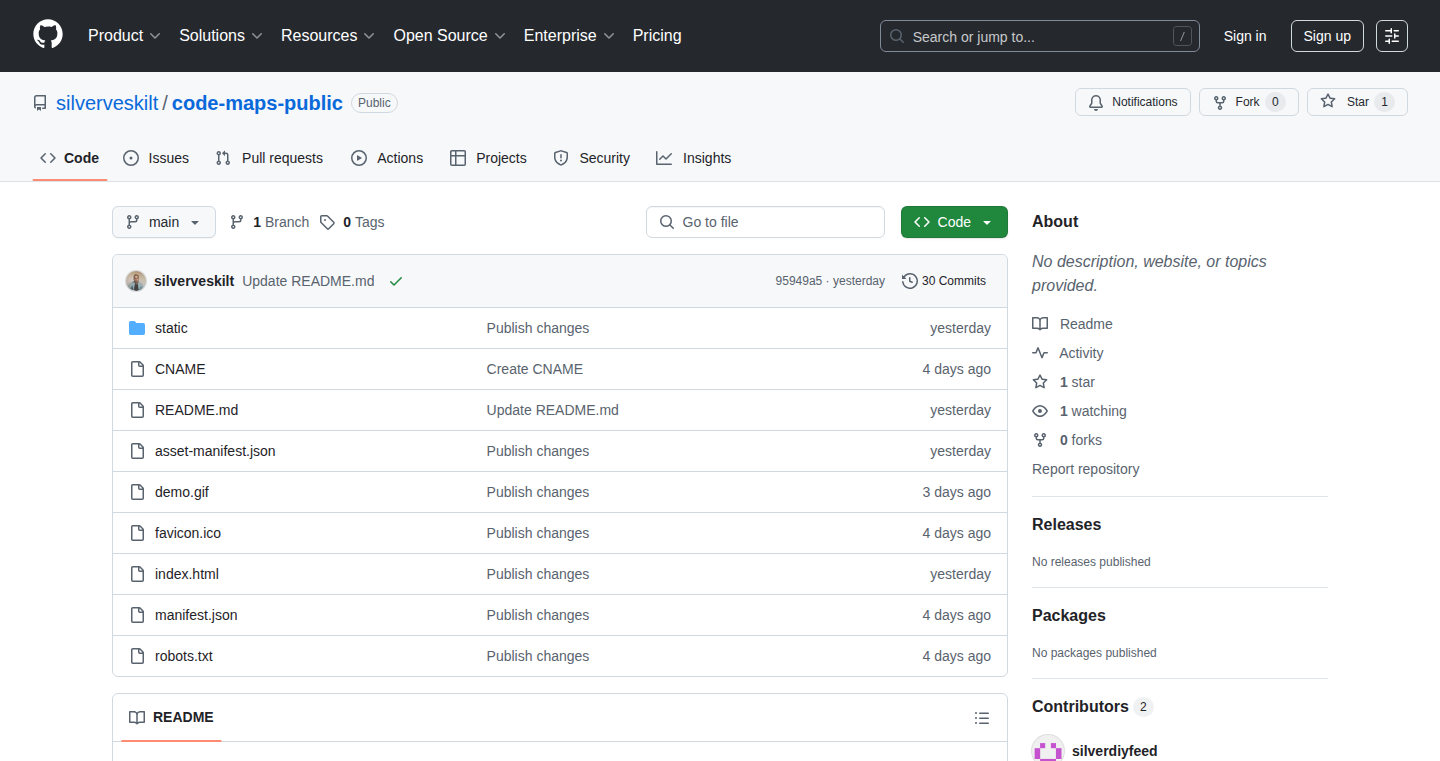
Author
silverveskilt
Description
MethodFlow is a visual tool designed to help game developers (and any developers working with C# and TypeScript) understand and manage the complex relationships between different parts of their code. It displays how methods (functions) depend on each other within classes, making it easier to debug, refactor, and understand the structure of your project. The key innovation is the visual representation of these dependencies, which is a significant improvement over trying to understand them just by reading code. It now supports both C# and TypeScript, broadening its usability.
Popularity
Points 2
Comments 0
What is this product?
MethodFlow is a tool that creates a visual map of your code's structure. Imagine a diagram showing how different parts of your game or software connect and rely on each other. It focuses on showing how methods (the actions your code performs) are linked together. This is especially helpful for projects that have a lot of code, making it much easier to see how everything fits together. By visualizing these connections, MethodFlow helps developers quickly understand how changes in one part of the code might affect other parts. This is the technical innovation, it provides clear visualization of code dependencies.
How to use it?
Developers use MethodFlow by integrating it into their workflow during development. The tool analyzes the project's C# or TypeScript code and automatically generates a visual representation. You can then explore this visualization, clicking on different methods to see their dependencies. You might use it during debugging to quickly trace how a bug is triggered, or during refactoring to ensure you don't accidentally break any existing functionality. It can be integrated as a plugin into your IDE or build process, allowing the developer to view the visual dependency graph directly in the development environment.
Product Core Function
· Dependency Visualization: This is the core feature. It generates a visual map showing how methods in your C# and TypeScript code depend on each other. This helps developers see at a glance how changes in one area might impact other parts of the code. So this means you can see how different parts of your project interact visually, avoiding hours of manual analysis.
· Class-Level Dependency Analysis: The tool specifically focuses on relationships between methods within classes. This level of detail is crucial for understanding how the internal logic of your code works. With this, you know how your classes are interacting internally, making it easier to design and maintain them.
· Language Support (C# and TypeScript): It provides support for both C# and TypeScript, offering flexibility for developers using different technologies or working on mixed-language projects. It fits with the tools you already use.
· Interactive Exploration: Users can interact with the visual map, clicking on methods to see more information and trace dependencies. This allows for deeper understanding and quicker debugging. You can directly explore the project relationships without having to read code for hours.
Product Usage Case
· Game Development (Unity): A game developer working on a large RTS/RPG game can use MethodFlow to understand the complex dependencies between different game systems (e.g., AI, combat, UI). This would help them to quickly identify the source of bugs and refactor code without unintentionally breaking existing gameplay. So you can debug a game faster and make sure changes don't have unintended side effects.
· Large Software Projects: In a large software project with a lot of interconnected components, developers can use MethodFlow to get a clear overview of how different modules interact. This can assist in identifying areas of high coupling, simplifying refactoring efforts, and improving overall code maintainability. You can understand complex projects more easily and make updates without breaking them.
· Refactoring Legacy Code: When working with older codebases, understanding dependencies can be challenging. MethodFlow helps developers visualize these dependencies, making it easier to refactor code and modernize it without introducing new issues. So you can modernize old code without fearing breaking things.
28
ai-sdk-cpp: Unified C++ API for Modern AI Models
Author
cauchyk
Description
This project is a C++ SDK that simplifies the process of integrating with modern AI models like OpenAI (GPT-4o) and Anthropic (Claude 3.5). It provides a unified API, meaning developers can interact with different AI models using the same code, making development easier. It handles streaming responses, multi-turn chat, and error handling in a clean, modern C++20 way, avoiding the messy macro-based approaches often found in other SDKs. A key feature is 'tool calling' (function-calling), allowing the AI to interact with real-world APIs and services. The project's creator is specifically seeking feedback on the challenges of automatically mapping C++ functions to JSON schemas due to C++'s lack of built-in reflection.
Popularity
Points 2
Comments 0
What is this product?
This is a C++ library that provides a clean and consistent way to access AI models like GPT-4o and Claude 3.5. It solves the problem of having to write different code for different AI providers. The library uses C++20 features like std::optional and std::variant for error handling and data management, making the code more robust and easier to understand than traditional C++ methods. A critical innovation is the support for 'tool calling,' enabling the AI to execute code and interact with other systems to perform tasks. This offers a significant improvement in terms of development speed and code quality. So this gives you a standardized and easier way to use different AI models in your C++ applications.
How to use it?
Developers can integrate ai-sdk-cpp by including the library in their C++ projects. They can then use a unified API to send requests to the supported AI models, receive streaming responses, and manage multi-turn conversations. The SDK supports synchronous and asynchronous calls to external APIs, enabling complex workflows. For example, you could use it to build a C++ application that utilizes both GPT-4o and Claude 3.5 without changing the core code. The library provides example code and documentation to help developers get started quickly. So you can easily integrate advanced AI features into your existing C++ projects.
Product Core Function
· Unified API for OpenAI and Anthropic: This provides a single interface to interact with different AI models, reducing the need for model-specific code. So, you can switch AI providers without major code changes.
· Streaming Support: Enables real-time response handling from the AI models. Useful for building interactive applications where users receive results as they are generated. So, you can create applications that feel faster and more responsive.
· Multi-turn Chat: Handles complex conversational interactions with AI models, keeping track of context across multiple exchanges. So, your applications can have sophisticated conversations.
· Error Handling: Uses modern C++ features like std::optional and std::variant for robust error management. So, it makes your code more stable and reliable.
· Tool Calling (Function Calling): Allows AI models to call external APIs and execute functions, enabling integration with real-world services. So, your AI can perform tasks and interact with other systems.
Product Usage Case
· Building a C++ application for customer support that uses GPT-4o to answer questions and Claude 3.5 to summarize conversations. The unified API allows for easy switching between models based on availability or cost. So, you can easily offer advanced support features in your applications.
· Creating a financial analysis tool that uses AI to process financial data. The tool calling feature allows the AI to automatically access and retrieve data from external APIs. So, you can build advanced applications leveraging external data.
· Developing a game where AI-powered non-player characters (NPCs) interact with the player using complex conversations and actions. The SDK simplifies the interaction with the AI. So, it's easier to create smart and engaging NPCs for your games.
29
GoSearcher: Blazing-Fast Concurrent Text Search
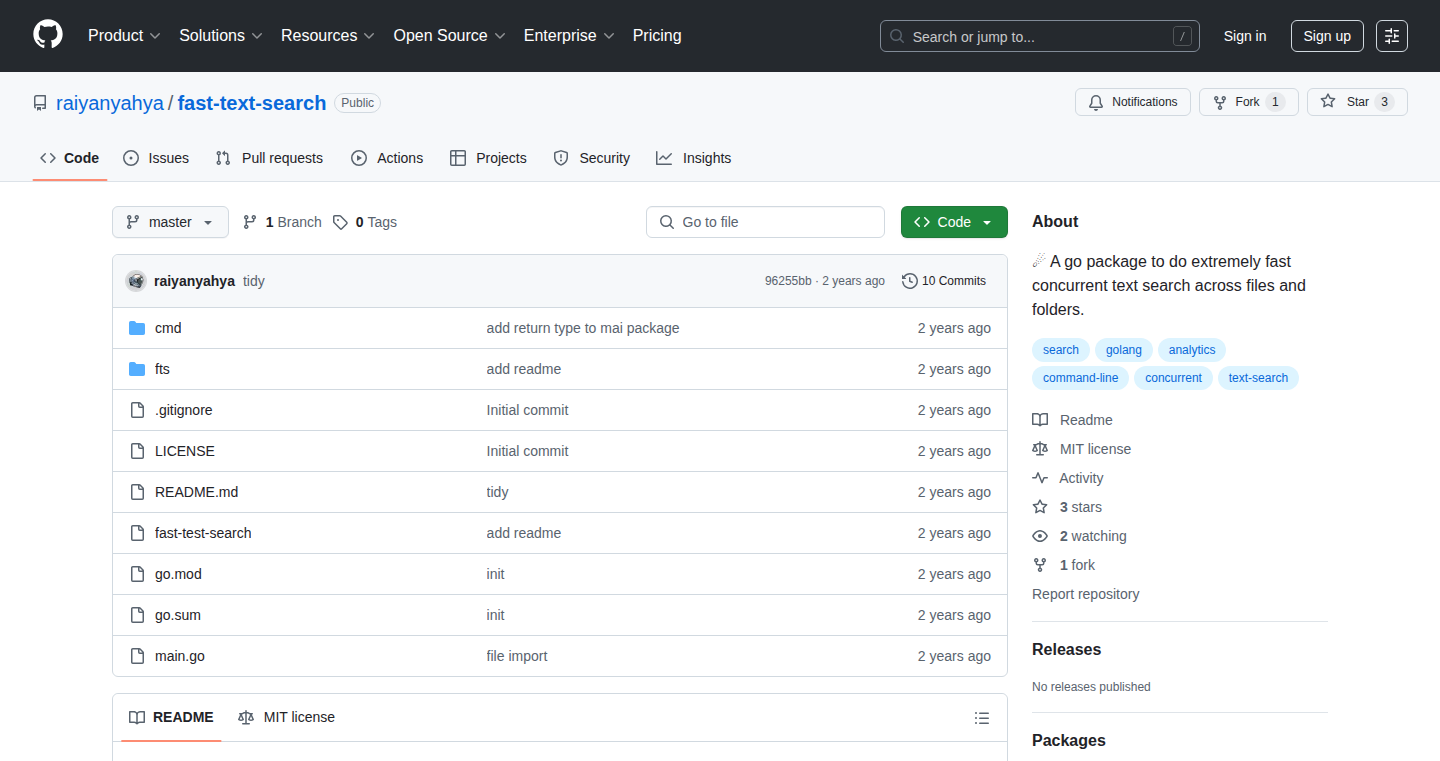
Author
RaiyanYahya
Description
GoSearcher is a tool that lets you quickly search for text within files and folders. It's built using Go, a programming language known for its speed and efficiency. The key innovation is using 'goroutines' – think of them as mini-programs that run at the same time. This allows GoSearcher to search many files simultaneously, making it much faster than traditional search tools. It also provides options to ignore certain file types and directories, allowing for more targeted searches. So, this allows developers to quickly find what they are looking for in large codebases or document collections, saving them time and boosting productivity.
Popularity
Points 2
Comments 0
What is this product?
GoSearcher is a text search tool that leverages concurrency using Go's goroutines. Instead of searching files one by one, it breaks the search task into smaller parts and runs them concurrently. This is like having multiple people working on the same task at the same time. The program efficiently utilizes multiple CPU cores to perform searches in parallel, thus drastically reducing search times, especially on large file systems. The tool also allows users to customize the search by ignoring specific file types and directories. So, the primary innovation is the use of concurrency to accelerate text search, which is efficient and user-friendly.
How to use it?
Developers can use GoSearcher in two main ways: as a command-line application or as a package that can be imported into their Go projects. For the command-line version, you simply run the program with the search term and the target directory. For example, you could type something like `gosearcher 'keyword' /path/to/your/project`. When used as a package, developers can integrate the search functionality into their applications. This is useful for creating custom search tools within existing software. For example, a code editor could use GoSearcher to power its 'find in files' feature, providing very fast search results. So, it provides a versatile, high-performance search capability that can be integrated into various tools.
Product Core Function
· Concurrent Text Search: The core functionality is the ability to search text across files and folders concurrently. This is achieved using goroutines, which enables parallel execution of search operations. This accelerates the search process, dramatically reducing search times, especially in large codebases. So this is useful for developers who need to search quickly.
· File Type and Directory Exclusion: GoSearcher allows users to specify file types and directories to ignore during the search. This is useful for focusing the search on specific files or folders. It eliminates unnecessary files from the search process. So this improves efficiency and helps to avoid irrelevant results.
· Command-Line Interface (CLI): GoSearcher provides a command-line interface, making it easy to use from the terminal. This allows developers to quickly search for text without needing to write any code. So this enables quick integration with other tools and scripts for automation.
Product Usage Case
· Codebase Search: A software developer needs to find all instances of a particular function name within a large project. By using GoSearcher, they can quickly locate all the relevant code snippets, which dramatically reduces the time spent on code analysis and debugging. So this is used to find bugs and improve code quality.
· Documentation Search: A technical writer uses GoSearcher to quickly find all instances of a specific term in a large documentation set. This facilitates the quick location of relevant information. This allows them to quickly update and correct any typos. So this helps writers to improve documentation consistency and accuracy.
· File System Analysis: A system administrator uses GoSearcher to search for specific files or patterns across a file system. This can identify specific files and gain insight into file system structure. So this is used to detect potential security threats or perform file management tasks.
30
AI-Powered Word Game Generator
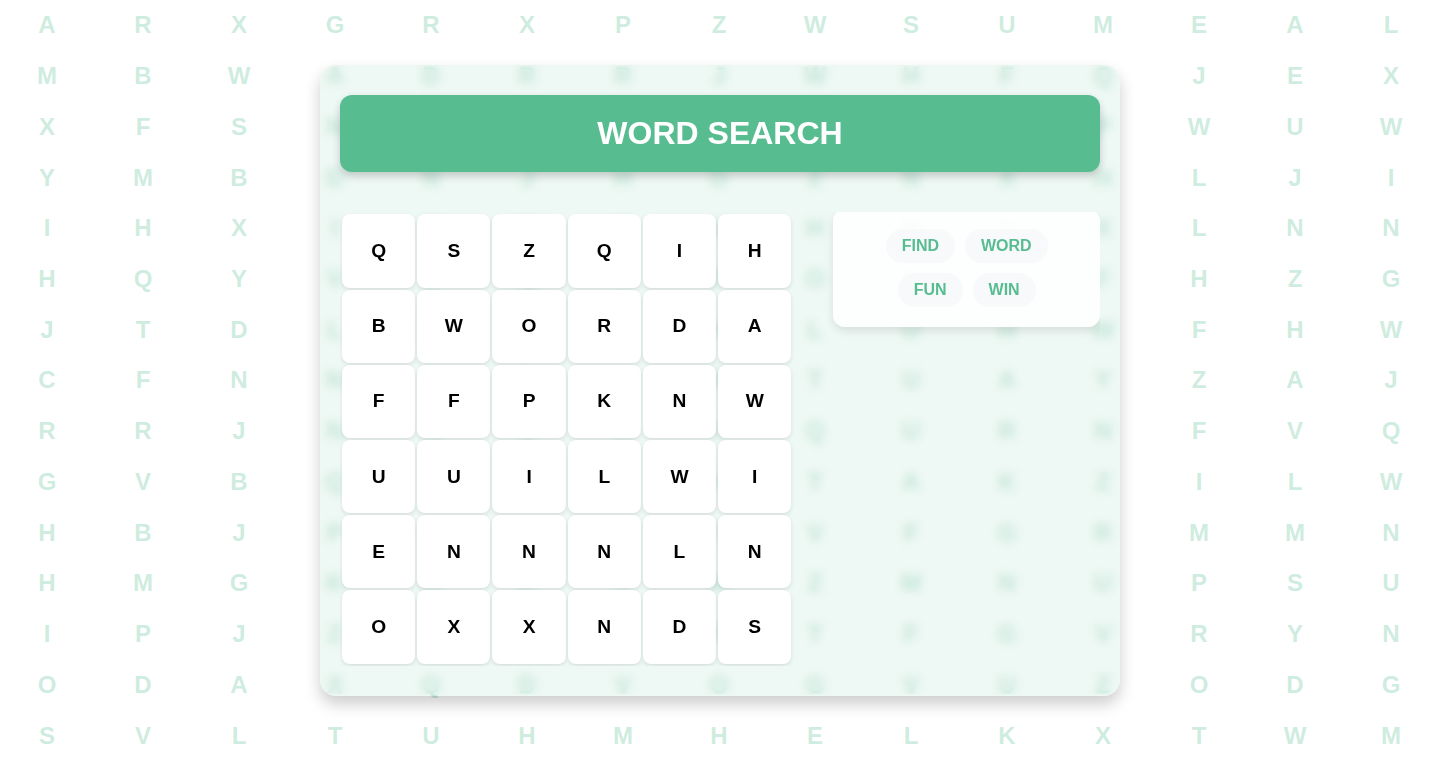
Author
gogo61
Description
This project showcases the rapid development of a popular word game using an AI coding assistant. The creator, with limited coding experience, utilized AI to generate code, test outputs, and iteratively improve the game logic. This project demonstrates a new approach to quickly prototype applications and learn coding concepts. So, it’s great for anyone wanting to quickly build a game or understand how AI can assist coding.
Popularity
Points 2
Comments 0
What is this product?
This is a word game created with the help of an AI coding assistant. Instead of writing all the code from scratch, the creator used AI to generate code snippets, test the game's behavior, and refine the game's rules and logic. This highlights the use of AI to lower the barrier to entry for software development, especially for those without extensive coding backgrounds. The AI acts like a coding partner, helping to build something useful and simple, and teaching the creator how the different parts of the code work. It’s a great example of how AI can be used to quickly build a working prototype and learn coding concepts. So, you can create a game without needing to learn all the technical details.
How to use it?
Developers can use this project as inspiration for their own AI-assisted coding projects. They can look at the interaction between the creator and the AI, the iterative process of development, and the overall project structure. It shows how to effectively leverage AI tools to prototype quickly. You could use similar techniques, feeding AI with your ideas and letting it create code, and you’ll get to iterate and improve the code. So, you can create a game or tool by asking AI for help.
Product Core Function
· AI-assisted code generation: The core function is the use of an AI to generate the game's code. The creator likely provided prompts and specifications, and the AI wrote the necessary code. This speeds up the development process significantly. So, it lets you rapidly build a game or tool.
· Iterative development: The project highlights the importance of an iterative process. The creator tested outputs and refined the logic bit by bit. This approach emphasizes the need to test, get feedback, and improve the code over time. So, you’ll learn from your mistakes as the game evolves.
· User Interface (UI) and Game Logic Integration: The project involves combining AI-generated code with the basic game mechanics and the UI (User Interface) of a word game. It handles the design of the user experience. So, you can focus on gameplay instead of spending time on technical details.
· Rapid Prototyping: The project demonstrates the feasibility of building a working prototype within a week. This showcases the efficiency and speed that AI can bring to the development process. So, you can quickly bring your game idea to life.
Product Usage Case
· Educational tool: This project provides a great example for people learning to code. They can analyze how the AI helps the creator, understand the different parts of the game, and see how all the parts connect. This simplifies the learning experience. So, if you're learning to code, you’ll find it much easier to grasp the concepts.
· Game developers: It can be a good example for game developers that want to quickly prototype new game ideas. AI can assist them in building the game. So, developers can focus on the core game mechanics and creative aspects.
· Non-coders with game ideas: It proves that people who don't know how to code can build games. AI can help them realize their vision. So, everyone can have a chance to realize their game ideas.
· Quick project startups: If you want to start a quick project like this word game project, you can use AI to get a lot of help to speed up the process and reduce the cost of starting. So, you will reduce the time needed to get things going.
31
Ketcher Docker: Web-Ready Chemical Structure Editor
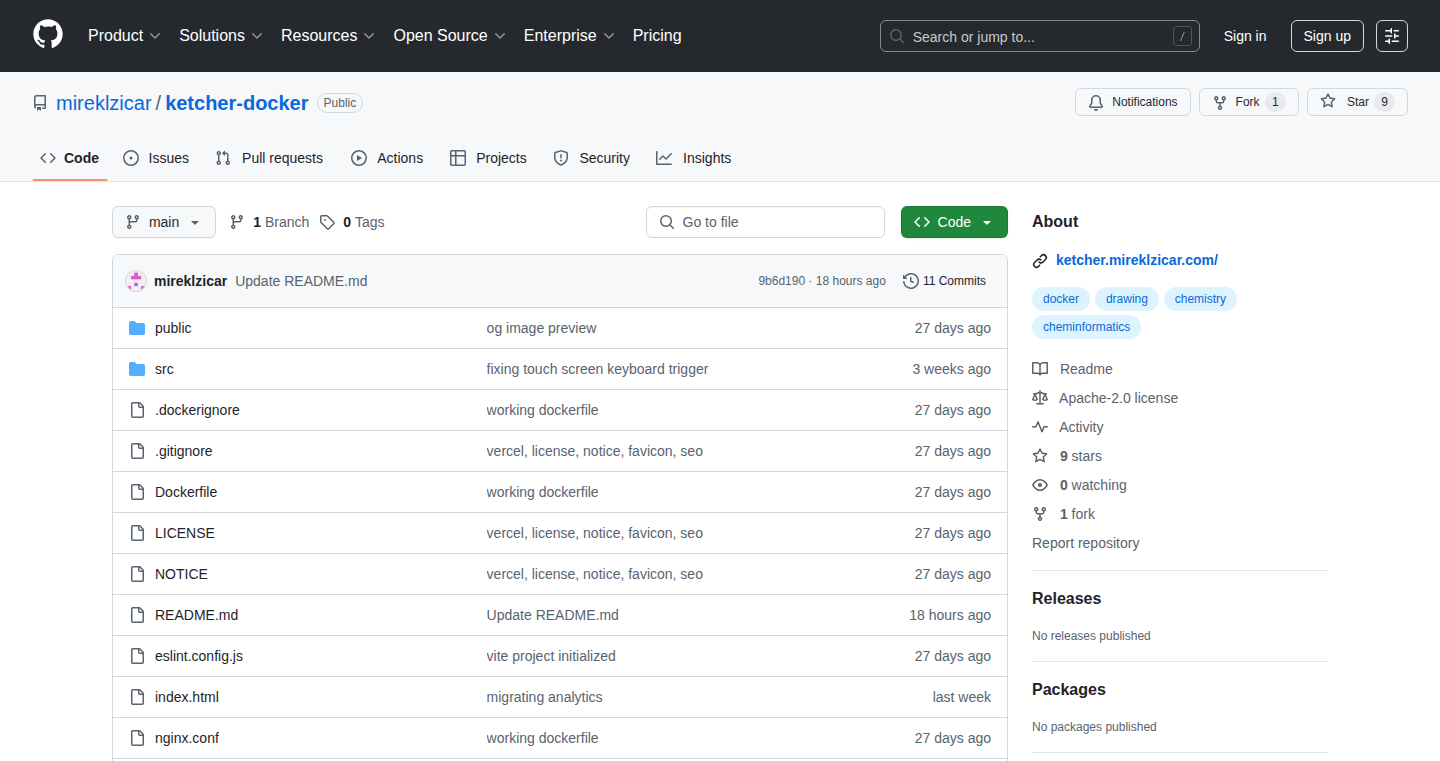
Author
mireklzicar
Description
This project packages an open-source chemical structure editor (Ketcher) into a production-ready Docker image with a React/Vite frontend. This allows developers to easily embed a full-featured molecule editor into any web application or run it standalone, without needing to write any Java/Spring code. The core innovation lies in simplifying the deployment and integration of a complex scientific tool, making it accessible to a wider audience. So, it allows you to quickly add chemical structure drawing capabilities to your website.
Popularity
Points 2
Comments 0
What is this product?
Ketcher Docker wraps the Ketcher editor, a tool for drawing and manipulating chemical structures, within a Docker container. Docker containers are like self-contained packages that include everything the software needs to run, including the operating system and all the necessary libraries. The project also provides a user interface built with React and Vite, popular web development tools, making it easy to integrate the editor into web applications. This removes the complexities of setting up and managing the dependencies of the editor, making it incredibly simple for developers to use. So, it is a straightforward way to embed a chemistry tool in your web application.
How to use it?
Developers can use this project by simply pulling the Docker image and integrating it into their web applications. This can be done by either running the editor as a standalone application or embedding it within an existing website using an iframe. The project provides clear instructions and a live demo. This approach minimizes the developer's setup time and simplifies the integration process. So, you can quickly add the editor without worrying about compatibility issues.
Product Core Function
· Chemical Structure Drawing and Editing: The core function allows users to draw, edit, and manipulate chemical structures directly within a web interface. This utilizes the features of the Ketcher editor. This is incredibly useful for creating interactive chemical databases or visualizing molecular models in educational applications. So, it provides the ability to create and display complex chemical diagrams in your web applications.
· Docker Containerization: The use of Docker means the editor and its dependencies are packaged into a single, portable unit. This ensures that the editor runs consistently across different environments (e.g., your local computer, cloud servers) without any compatibility problems. So, it ensures that the editor will function smoothly no matter where you deploy it.
· React/Vite Frontend: The front-end built with React and Vite provides a user-friendly interface and facilitates easy integration with web applications. Vite is a fast build tool, which enhances the development and deployment experience. So, it provides a fast and modern interface that integrates seamlessly into your web applications.
· Self-Hosting Capabilities: The Docker image enables self-hosting, which means the user has full control over the editor and its data. This is critical for applications that require data privacy or specific customizations. So, you have complete control over the data and access to the editor.
Product Usage Case
· Scientific Websites: Integrate the editor into a website for a scientific journal, allowing users to create and submit chemical structures as part of their research papers. This allows for the rapid inclusion of chemical structures. So, it allows for easy incorporation of chemical diagrams in any research environment.
· Educational Platforms: Use the editor in an online chemistry course, enabling students to draw and visualize molecular structures in real-time. This fosters an interactive learning experience. So, it provides an interactive teaching tool for chemistry lessons.
· Chemical Databases: Build a web application to manage a database of chemical compounds, allowing users to search, view, and edit chemical structures. This enables the creation of richer datasets. So, it creates a user-friendly way to manage and browse chemical compounds.
· Research and Development Tools: Integrate the editor into a research platform where scientists can easily draw and visualize molecular structures to experiment with. This allows for quick iteration and testing. So, it makes the research and development process more efficient.
32
StopAddict: Gamified Habit Tracker for Breaking Addictions
Author
skyzouw
Description
StopAddict is a minimalist application designed to help users quit addictions by leveraging gamification principles. It tracks streaks, rewards users with experience points (XP) for each day they stay clean, and provides progress visualization through charts. The core innovation lies in its relapse-friendly approach where streaks reset but XP remains, preventing users from feeling like they've lost all progress. It addresses the problem of generic habit trackers failing to provide the necessary motivation during difficult moments.
Popularity
Points 1
Comments 1
What is this product?
StopAddict is a personal tool, like a fitness tracker, but for breaking habits such as smoking or social media addiction. It uses gamification to make the process more engaging. It tracks how many days you've been clean and rewards you for your efforts. The key technology is in how it handles relapses. It doesn't punish you too harshly by resetting everything, so you don't lose all the progress you've made. So what? It's designed to keep you motivated, even when you slip up, because you keep the experience points (XP) you earned. This helps you stay on track to achieve your goals.
How to use it?
Developers can't directly 'use' StopAddict in the traditional sense, but they can draw inspiration from its design and approach when building similar applications or features. Imagine you are building a productivity app, you could borrow StopAddict's ideas about streaks, XP, and progress charts to motivate users to achieve tasks. You might consider this a design pattern of the UI/UX. For example, a developer building a self-improvement platform could integrate a similar habit-tracking system to help users build better habits.
Product Core Function
· Streak Tracking: Tracks the number of consecutive days the user abstains from their addiction. This provides a clear measure of progress. It provides a visible record of progress, helping users recognize their accomplishments, and it creates a sense of momentum to keep going. So what? It builds accountability and reinforces positive behavior.
· XP and Leveling: Rewards users with experience points (XP) for each clean day, allowing them to level up. This introduces an element of gamification, making the process more engaging. So what? It turns breaking an addiction into a game, making the process less daunting and more enjoyable.
· Relapse-Friendly Design: If a user relapses, the streak resets, but the XP remains. This prevents users from feeling discouraged and losing all progress. It acknowledges that setbacks are normal and avoids making users feel like they've failed. So what? It keeps users motivated, even after a setback, encouraging them to restart their efforts.
· Progress Charts: Visualizes progress over weeks and months, showing the user's journey. This allows users to see their progress and identify patterns. So what? It provides a clear and easy-to-understand view of progress and helps users to maintain motivation.
Product Usage Case
· A developer working on a health app could use StopAddict's gamification ideas. They might create a system where users earn points for completing workouts or eating healthy meals, then visually track progress, helping users build consistent routines. So what? This could significantly improve user engagement and encourage a healthier lifestyle.
· A team creating a project management tool might use a similar streak system to reward users for completing tasks or meeting deadlines. The project team can monitor their progression in a visual manner. So what? This helps project teams to be more productive by creating a more positive and motivating environment for task completion.
· A learning app developer could adopt similar mechanics to encourage regular study habits. Learners earn points for study sessions and can level up their skills. So what? This makes learning more engaging and encourages continuous practice.
33
Distapp: Universal App Distributor
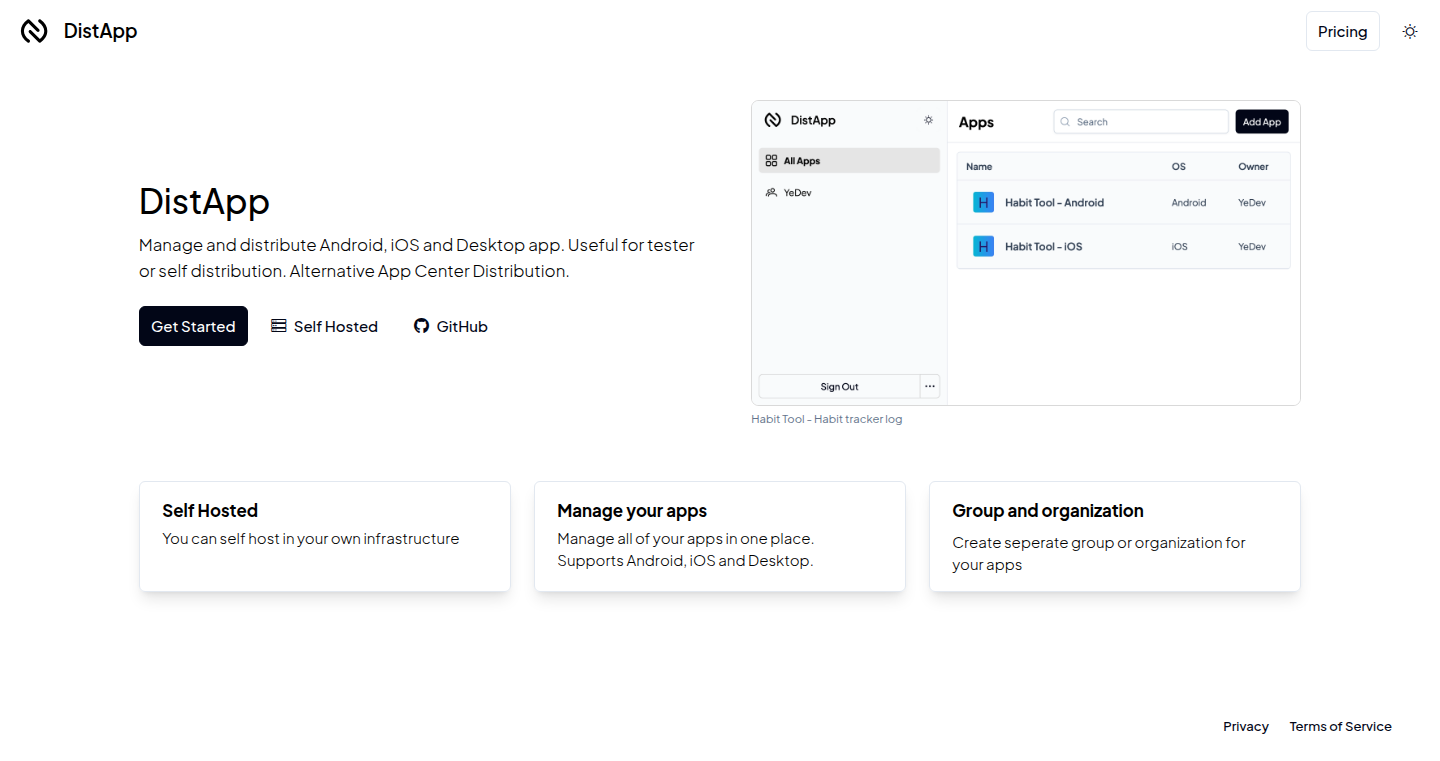
Author
yunusefendi52
Description
Distapp is a tool designed to simplify the management and distribution of applications across various platforms, including Android, iOS, and desktop environments. It streamlines the often complex process of getting apps into the hands of users. The core innovation lies in its unified approach, managing different platform-specific requirements (like signing certificates and device compatibility) from a single interface, saving developers significant time and effort. So this simplifies the app distribution process, which means you get your app to users faster.
Popularity
Points 1
Comments 1
What is this product?
Distapp acts as a central hub for managing and distributing your apps. Instead of dealing with the platform-specific complexities of Android, iOS, and desktop environments individually, you can use Distapp to handle the common tasks. It uses technologies to automate the process of preparing apps for distribution, including things like code signing (verifying the app's authenticity) and generating the correct package formats for each platform. This way Distapp offers a more streamlined, platform-agnostic approach to app distribution. So, it’s like having a project manager for your apps, making sure they are ready to go, no matter the platform.
How to use it?
Developers would use Distapp by uploading their app's build files. Distapp would then take care of all the platform-specific tasks, such as code signing or creating the proper package format (like .apk for Android, .ipa for iOS, or .exe for Windows). The developer can then distribute the app via a custom link or directly to a user's device. This is easily integrated into an existing development workflow by plugging in build artifacts. So you will spend less time on technical setup and can focus on what is more important: making and improving your app.
Product Core Function
· Cross-Platform Support: Distapp supports multiple platforms (Android, iOS, Desktop). It automatically handles the specifics, saving developers time on platform-specific configurations. So it helps get apps to more users without extra work.
· Automated Code Signing: Handles code signing, ensuring apps are trusted and can be installed on user devices. This reduces the complexity and chances of errors. So your app is secure and works reliably on your user's devices.
· Distribution Management: Provides a centralized interface to manage different versions of apps and user groups. This helps manage who gets what and when, especially for beta testing or different user segments. So you have better control over how your app is rolled out.
· Build Automation Integration: Can integrate with build automation tools (like Jenkins or similar CI/CD systems), allowing for automated distribution after builds. So it speeds up the app release cycle considerably.
· App Package Conversion: Handles app package conversions between different formats (.apk, .ipa, etc.) to fit the target platform. So it makes the app compatible with all the target platforms.
Product Usage Case
· Beta Testing: A developer can use Distapp to distribute beta versions of an Android app to a group of testers. The tool handles the necessary code signing and generates a downloadable link. So, it makes it easy to collect feedback before a wider release.
· Internal Enterprise App Distribution: A company can use Distapp to manage and distribute its internal iOS and Android apps to employees. Distapp handles the certificate and profile management, so the IT department doesn't have to deal with the manual process. So it facilitates easy deployment and updates for internal apps.
· Cross-Platform Game Development: A game developer can utilize Distapp to build and distribute its game across multiple platforms (Android, iOS, Desktop). So, it automates the platform-specific preparation tasks and allows more time for coding and gameplay design.
· Mobile App Development for Clients: An agency can use Distapp to distribute iOS apps for clients. The tool would handle all the certificate and provisioning profile management, simplifying the process and allowing the development team to focus on building great products. So you can easily deliver the final product to your clients.
34
TrashTalk.me: The Whisper-to-Web App
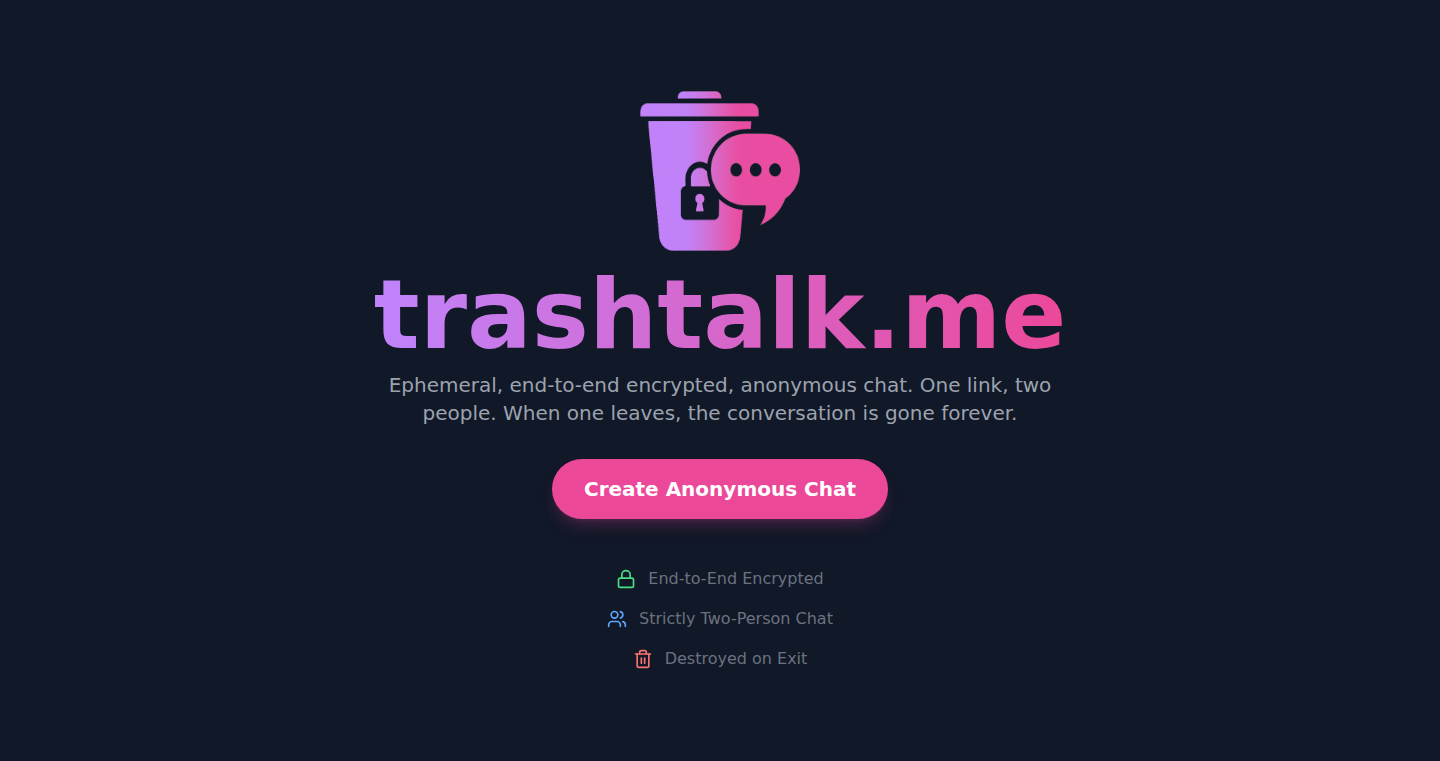
Author
ramenryoko
Description
TrashTalk.me is a web application for quick, private, and ephemeral (short-lived) conversations. It uses end-to-end encryption and peer-to-peer connections to ensure your chats disappear the moment you're done. It's like a digital whisper, designed for total privacy. It’s built with a focus on security and anonymity, making it ideal for sharing sensitive information without leaving a trace.
Popularity
Points 2
Comments 0
What is this product?
TrashTalk.me is a web-based chat tool that prioritizes privacy. It uses end-to-end encryption, meaning only you and the person you're talking to can read the messages. It also uses peer-to-peer technology, which means the data flows directly between your devices after the initial connection setup, bypassing the server. The server itself is designed to be 'stateless', meaning it doesn't store any chat history, user information, or IP addresses. Once the conversation is over, it's gone forever. So what? This means your secrets stay secret, your temporary information stays temporary, and you control your digital footprint.
How to use it?
To use TrashTalk.me, you simply click a button to generate a unique link. Share this link with the person you want to chat with. Once they open the link, you can start chatting and sharing files. When either of you closes the browser tab or clicks the trash can, the entire conversation is permanently deleted. So how can I use it? Developers can use it to securely share API keys or code snippets without worrying about data leaks. Journalists and activists can use it for private communications. Friends can use it to share secrets or gossip knowing the conversation is not being stored.
Product Core Function
· Ephemeral Messaging: The core function is to provide a chat that self-destructs. Once the window is closed or the user decides to end the conversation, all traces of the chat are removed from the system. Technical Value: This leverages the ephemeral nature of web sessions and minimizes data storage, solving the problem of long-term chat history retention. Application: Perfect for sharing sensitive information like passwords or API keys that you don't want to keep a record of.
· End-to-End Encryption (E2EE): All messages and files are encrypted and decrypted directly on the users' devices using the Web Crypto API. The content never touches the server unencrypted. Technical Value: This guarantees that even the service provider cannot read the content of your communications, dramatically enhancing privacy. Application: Securely sharing confidential information or discussing sensitive topics knowing that the data is protected.
· Peer-to-Peer (P2P) Communication: After the initial setup, the data flows directly between the users' devices using WebRTC. This makes the communication faster and more private. Technical Value: Reduces reliance on central servers and improves performance while minimizing data logging. Application: Faster communication and reduced server costs. This is especially useful when sharing large files or having real-time discussions.
· Stateless Server: The backend server doesn't store any logs or chat history. Its only job is to match two browsers. Technical Value: Minimizes the attack surface and data exposure risk, improving privacy. Application: Gives users peace of mind knowing their communications aren't being tracked or stored, essential for privacy-focused discussions.
Product Usage Case
· Secure Code Snippet Sharing: A developer needs to share an API key with a colleague quickly. Using TrashTalk.me, they share the key securely knowing that the chat and key will disappear after the session. Benefit: This prevents the API key from being accidentally leaked in a persistent chat or email.
· Confidential Discussions for Journalists: A journalist needs to communicate with a source about sensitive information. TrashTalk.me allows them to have a secure, private conversation without worrying about the conversation being intercepted or stored. Benefit: Enables secure communication for investigative journalism without compromising the sources' privacy.
· Temporary Data Sharing: Two friends are planning a surprise party and need to share secret details. They use TrashTalk.me to exchange plans, knowing that the details will be permanently erased once they're done. Benefit: Ensures that sensitive information remains private and does not leave a digital footprint.
35
CSPaper: AI-Powered Paper Reviewer
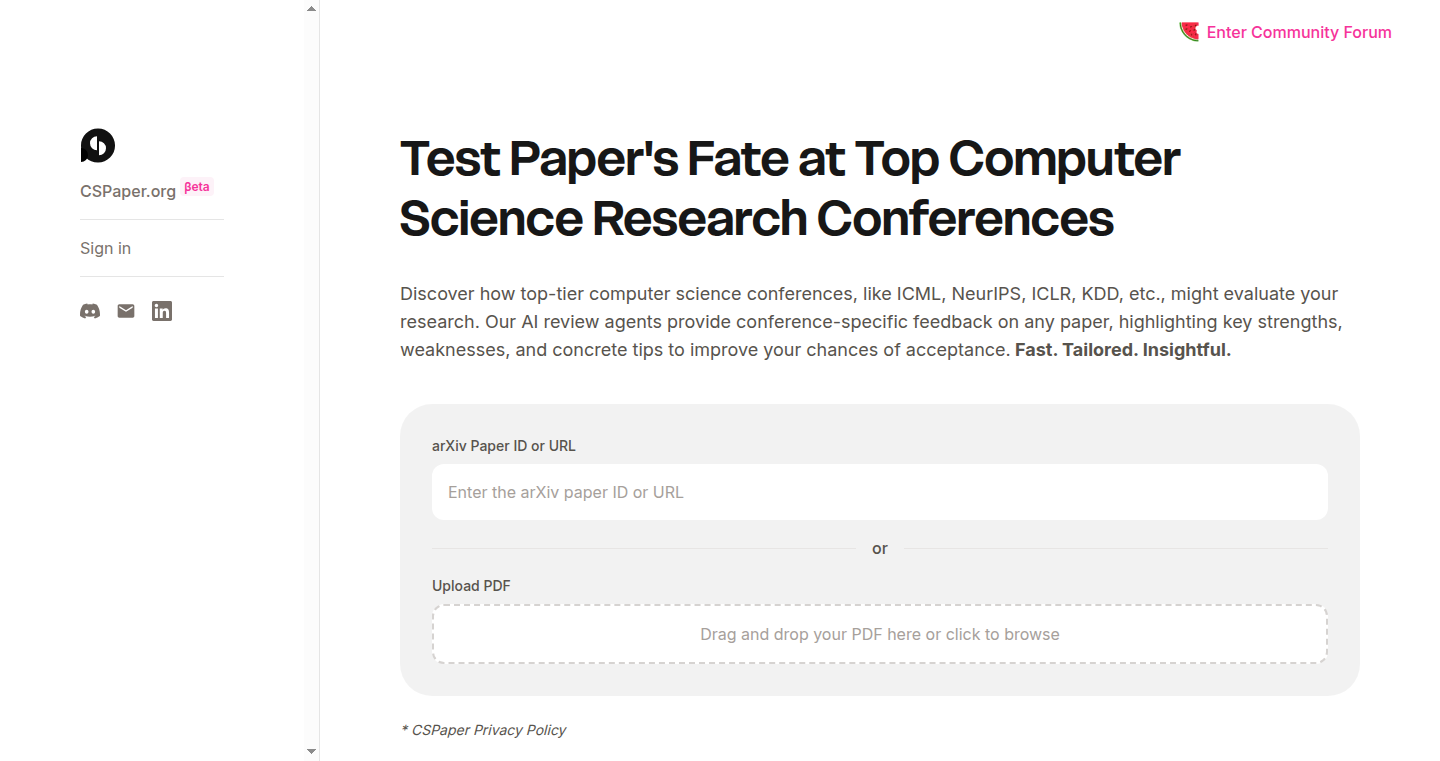
Author
philCS
Description
CSPaper is an AI tool designed to generate conference-style feedback for computer science papers. It takes a draft (like an arXiv link or PDF) and, based on a chosen conference's style (e.g., ICML, NeurIPS), produces structured feedback akin to a real review within a minute. This helps researchers identify weaknesses and improve their papers before submitting them. The core innovation lies in using AI to automate the peer-review process, offering quick and objective assessments, which is especially valuable given the high volume of submissions in the field. So this helps you quickly improve your paper quality and increase the chance of acceptance.
Popularity
Points 2
Comments 0
What is this product?
CSPaper uses artificial intelligence to simulate the peer-review process for computer science papers. You feed it your paper, specify a target conference, and the AI generates a review based on typical conference review criteria. The AI analyzes your paper, identifies potential weaknesses (e.g., clarity, novelty, methodology), and provides feedback. The technology is built on large language models (LLMs), which are trained on a vast amount of text data, including research papers and reviews. So you get a quick way to see where your paper needs improvement.
How to use it?
Researchers upload their paper (PDF or arXiv link) to CSPaper, select a target conference, and the AI processes the paper and generates feedback. The feedback is structured in a way that is similar to a real conference review, so you can easily see the areas that need attention. This feedback can be used to revise and improve the paper before submission. You can integrate this tool in your paper writing workflow to get early feedback and improve paper quality.
Product Core Function
· AI-Generated Feedback: CSPaper provides automated, AI-generated feedback on research papers.
· Conference-Specific Review Styles: Allows users to select a specific conference style (e.g., ICML, NeurIPS) to tailor the feedback to the expected criteria.
· Rapid Turnaround: Feedback is generated within approximately one minute, providing quick assessments to authors.
· Structured Feedback: The output is formatted like a conference review, including comments on clarity, novelty, and methodology. So you will see the feedback in a way that is easy to understand and act upon.
· Iterative Improvement: Helps researchers identify and address weaknesses in their paper drafts before submitting them to real conferences.
Product Usage Case
· Pre-Submission Review: A researcher working on a machine learning paper can use CSPaper to get feedback before submitting to NeurIPS. This feedback can help identify gaps in the experimental results or areas where the paper's writing can be improved.
· Early Draft Assessment: A Ph.D. student can use CSPaper to get quick feedback on an early draft of their paper. This can save time by identifying potential issues early in the writing process, so that the student does not spend too much time on issues that the paper will not pass on.
· Reviewer Assistance: In the future, if tools like CSPaper become more advanced, they might assist reviewers by providing an initial assessment of a paper, helping them focus on the most critical aspects. So it is possible to streamline the review process for both authors and reviewers, leading to more efficient and effective peer review.
36
WebLearner: Your Website's AI Q&A Companion
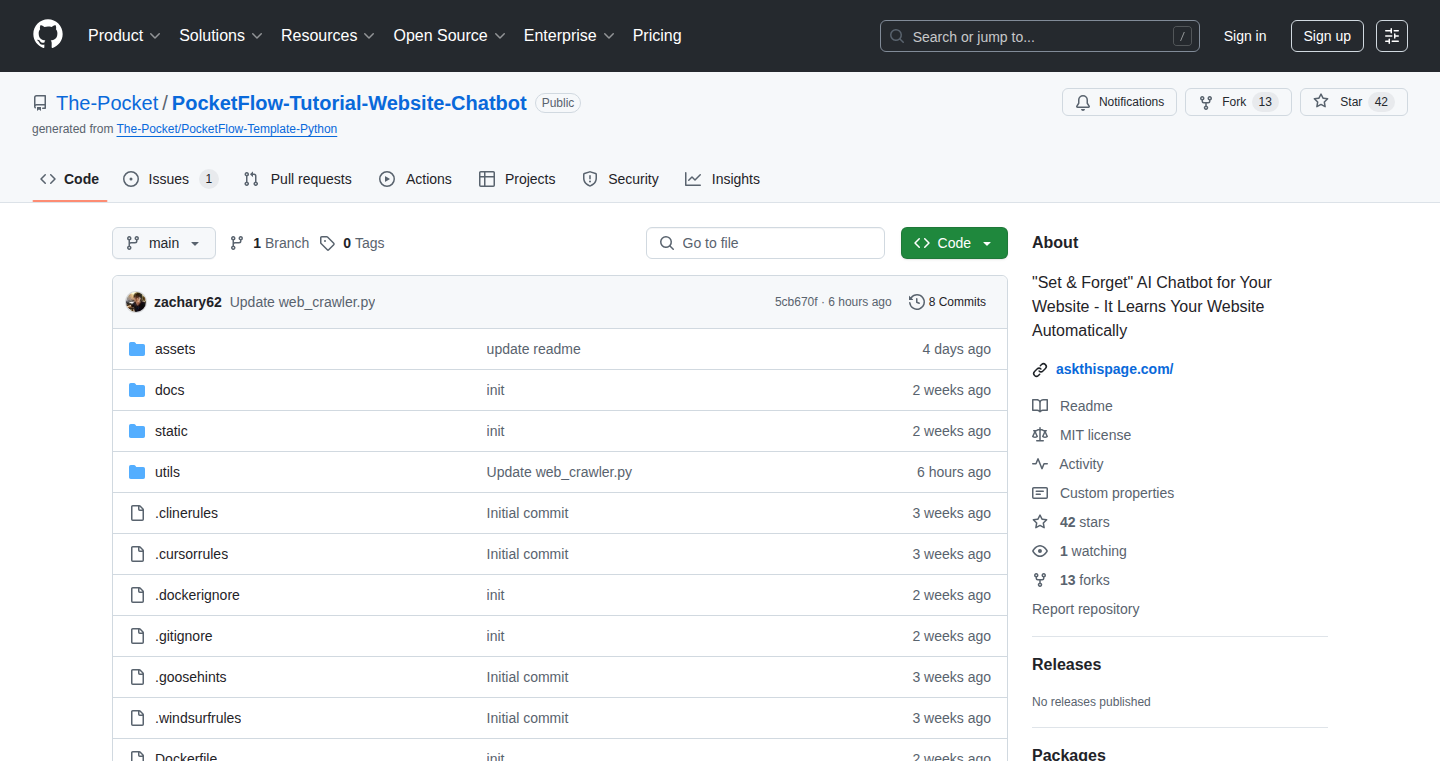
Author
zh2408
Description
WebLearner is an AI chatbot that learns from your website's content to answer user questions. It's a solution to automatically provide instant answers to common questions about your website, without needing to manually create a FAQ section or train a complex chatbot from scratch. The core innovation lies in its ability to quickly and accurately digest website content and generate relevant responses.
Popularity
Points 2
Comments 0
What is this product?
WebLearner uses Artificial Intelligence, specifically Natural Language Processing (NLP) and Machine Learning, to understand your website's information. Think of it as a smart reader that extracts key facts and relationships from your webpages. It then uses this understanding to answer questions. The magic happens when users ask a question. WebLearner uses a retrieval-augmented generation (RAG) approach: it finds the most relevant information on your website related to the question and then generates a concise, helpful answer. This differs from simply searching your website. It actually *understands* the context and meaning, providing better, more relevant results. So what's the big deal? It's a quick way to have an always-on, intelligent assistant for your website that improves user experience, freeing up you and your team from answering repetitive questions.
How to use it?
Developers can integrate WebLearner into their websites by using a simple API or embedding a chat widget. You just point the system to your website's URL, and the AI does the rest. You can customize the appearance and behavior of the chatbot to match your website's design. You provide the data, the AI does the heavy lifting. For example, if you have an e-commerce site, WebLearner could answer questions about shipping, returns, or product specifications automatically. If you're a developer, imagine providing instant answers to your users about your project's API or documentation. You integrate it, you let it learn, and it answers the questions, improving user satisfaction.
Product Core Function
· Website Crawling and Content Extraction: This is the process by which WebLearner accesses and gathers information from your website. The value? It automatically collects the data needed for the AI to learn. Application: Simplifying the onboarding process so you don't need to manually feed information.
· Semantic Understanding with NLP: It leverages Natural Language Processing to analyze the meaning and context of text on your website. The value? The AI better understands the intent of questions and provides more accurate answers. Application: Provides more accurate and contextual answers, like understanding the difference between "What are your return policies?" and "Can I return this item?"
· RAG-Based Answer Generation: It uses Retrieval-Augmented Generation, a process that retrieves relevant information from the website and then uses that information to create a response. The value? Provides concise and informed answers specific to your website's content. Application: Users get quick, precise responses tailored to the website's specific details, for example, answering a question about the shipping fee.
· Customization and Integration: WebLearner can be tailored to fit the look and feel of your website and can be easily integrated through APIs. The value? Easy integration and a seamless user experience. Application: Adding a chatbot in seconds to a website, making it feel like a native component.
Product Usage Case
· E-commerce Website: A clothing store integrates WebLearner to answer customer questions about sizing, shipping, and returns, reducing the number of support inquiries and improving customer satisfaction.
· Documentation Site for a Software Project: A developer uses WebLearner to create an interactive Q&A for their API documentation, allowing users to quickly find answers to their technical questions.
· Educational Website: An online learning platform uses WebLearner to provide instant answers to students' questions about course content and assignments, increasing student engagement.
· Company FAQ section automation: You can replace the traditional FAQ section. WebLearner provides an always-on resource that answers questions without requiring manual updates.
37
Ciara - Your Zero-Config Deployment Companion
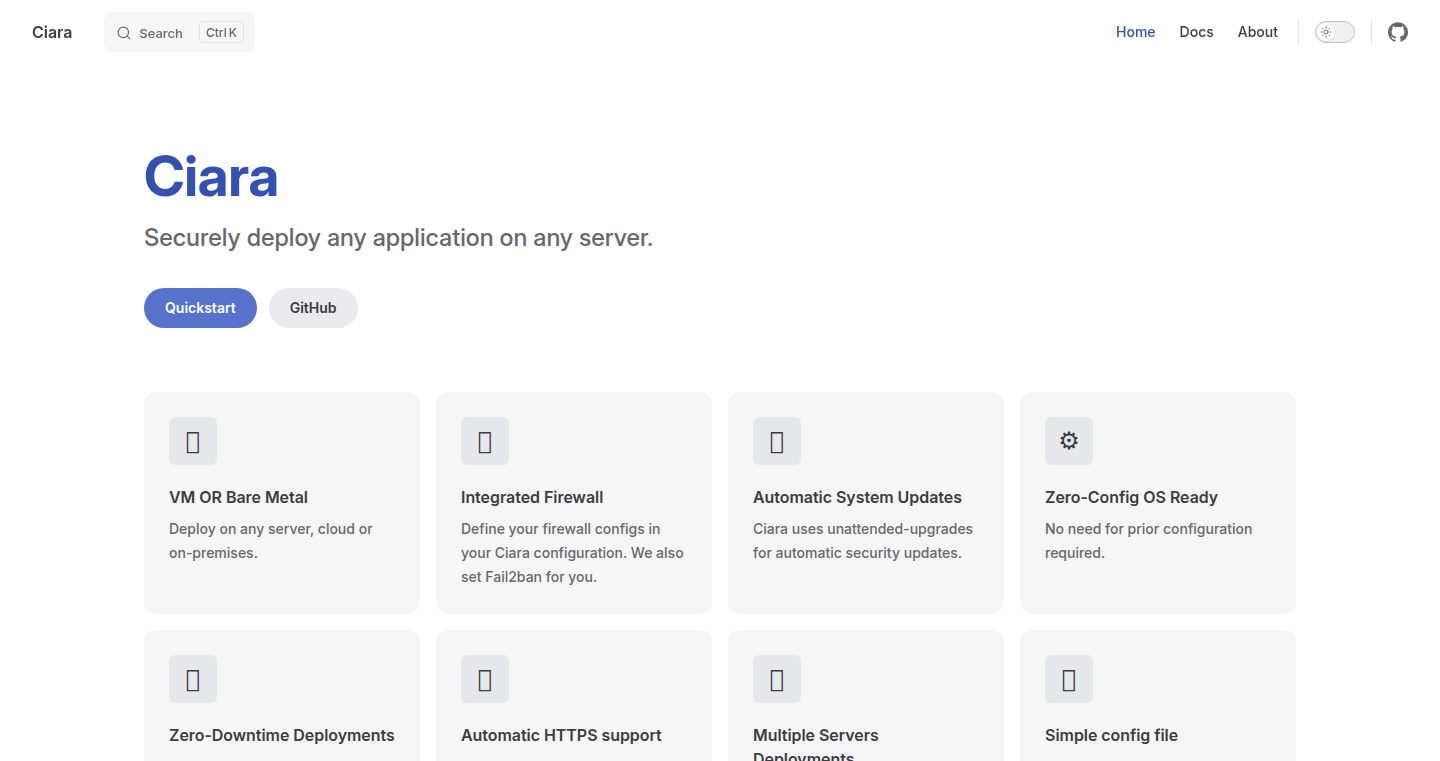
Author
andresribeiro
Description
Ciara is a tool that simplifies deploying applications onto servers, addressing the common headaches of manual configuration. It tackles issues like setting up firewalls, enabling automatic updates, and securing your server with HTTPS. The core innovation lies in its single configuration file approach, making deployment across multiple servers much easier and more reliable. So this is useful because it saves you from the tedious work of configuring servers individually, making the whole process faster and less error-prone.
Popularity
Points 2
Comments 0
What is this product?
Ciara is a deployment tool that automates many server-side tasks. It takes a single configuration file as input and handles firewall setup, system updates, and HTTPS certificate management. Instead of manually configuring each server, you define your desired state in one place, and Ciara takes care of the rest. This streamlines the deployment process. So, it automates repetitive and error-prone server configuration tasks. It simplifies managing multiple servers and ensures consistency across deployments.
How to use it?
Developers use Ciara by writing a configuration file describing their application and the target servers. They would then use Ciara's commands to deploy the application. This tool can be integrated into a CI/CD pipeline to fully automate the deployment process. So, you can automate your deployment pipeline, ensuring your code updates are seamlessly published.
Product Core Function
· Integrated Firewall: Ciara automatically sets up and configures firewalls on your servers. This protects your applications from unauthorized access. So this keeps your application secure by automatically configuring security rules.
· Automatic System Updates: It enables unattended upgrades, ensuring your servers stay up-to-date with security patches and bug fixes. So this keeps your servers safe from known vulnerabilities, reducing security risks.
· Zero-Config OS Ready: Ciara can prepare servers with a minimal OS install so that applications can be deployed immediately after OS installation. So, this reduces deployment time, as you don't need to perform manual OS configuration.
· Zero-Downtime Deployments: Ciara supports zero-downtime deployments, meaning your application stays available while updates are in progress. So, your users experience no interruption during updates.
· Automatic HTTPS support: Ciara can automatically obtain and install HTTPS certificates. So, securing your applications with HTTPS becomes simple, enhancing security.
· Multiple Servers Deployments: Ciara supports deploying your application across multiple servers easily. So you can deploy and manage multiple instances of your application, increasing scalability and availability.
Product Usage Case
· A developer needs to deploy a web application to multiple servers. Using Ciara, they can define their application's configuration, including dependencies, environment variables, and deployment settings, in a single file. Ciara handles the server setup, firewall configuration, and application deployment on each server, ensuring a consistent and secure deployment across all instances. So, it allows for deploying applications quickly and consistently across multiple servers, saving time and effort.
· A team wants to automate the deployment process. They integrate Ciara into their CI/CD pipeline. Every time code is pushed, Ciara automatically builds the application, configures the servers, and deploys the new version, all with zero downtime. So, this enables continuous deployment and improves development cycles.
· A developer wishes to secure their website by automatically installing SSL certificates. Ciara can be configured to automatically obtain and configure HTTPS certificates from Let's Encrypt. So this ensures that your website is automatically secured with HTTPS without manual intervention, saving time and improving security.
38
Chisel: Cloud GPU Kernel Profiling with One Command
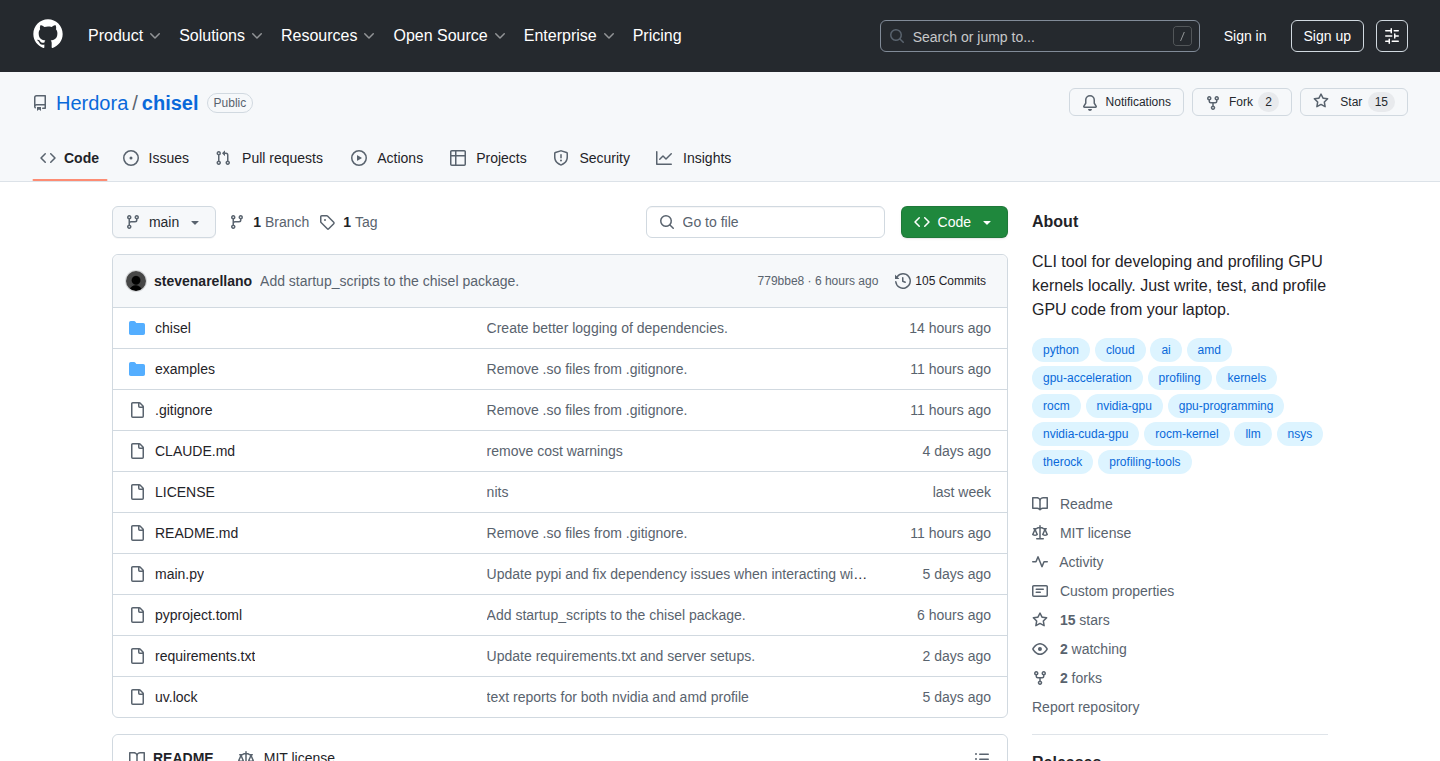
Author
technoabsurdist
Description
Chisel simplifies the process of profiling GPU kernels (small programs that run on a GPU) in the cloud. It solves the common problem of developers spending more time managing cloud infrastructure (setting up servers, uploading code, downloading results) than actually optimizing their GPU code. Chisel automates the entire workflow: it spins up a cloud instance, synchronizes your code, runs profiling, and automatically retrieves the results. This allows developers to iterate faster and focus on improving GPU performance without needing a local GPU or complex setup.
Popularity
Points 2
Comments 0
What is this product?
Chisel is a command-line tool that uses the power of the cloud to profile GPU kernels. Think of it as a smart assistant for GPU developers. When you run a single command, Chisel does the following: It starts a virtual computer (cloud instance) that has a GPU. It copies your GPU code to that virtual computer. It then runs a special program (profiler) on your code to measure how fast it runs and identifies any bottlenecks (places where your code is slow). Finally, it brings back the results so you can see how to improve your code. This eliminates the need for you to have a powerful (and expensive) GPU on your desk, or to constantly copy and paste your code and results manually. So this is useful for anyone working on GPU optimization.
How to use it?
Developers use Chisel through a simple command-line interface (CLI). After installing it (using `pip install chisel-cli`), you would typically provide Chisel with your GPU code and a few options about how to profile it. Chisel then takes over, handling the cloud setup, code execution, and result retrieval automatically. For example, if you're using Python with PyTorch, you can integrate Chisel into your workflow to profile your model training process. This helps you understand which parts of your code are using the GPU the most and if there is room for optimization. So this enables GPU developers to quickly test and improve their code, no matter their hardware situation.
Product Core Function
· Cloud Instance Management: Chisel automates the creation and management of cloud instances with GPUs. This includes selecting the appropriate cloud provider (e.g., AWS, Google Cloud, Azure) and instance type based on the user's needs. Value: Eliminates the need for manual cloud setup and configuration, saving developers time and effort. Application: Quickly testing and optimizing GPU code without having to interact with a cloud provider's interface directly. So this saves you time by removing the complex setup needed to use the cloud.
· Code Synchronization: Chisel securely copies your GPU code (e.g., CUDA kernels, Python scripts using TensorFlow/PyTorch) to the cloud instance. Value: Simplifies the process of transferring code for profiling, removing the need for manual file transfers via SSH or other methods. Application: Quickly test different versions of your code on a cloud GPU. So this lets you run the same code you have locally in the cloud so you can test it and profile it much easier.
· GPU Profiling: Chisel runs the profiler (e.g., `rocprofv3` for AMD GPUs) on your code, collecting performance metrics. Value: Provides detailed insights into the performance of your GPU kernels, including execution time, memory usage, and potential bottlenecks. Application: Identifying performance issues in your GPU code, enabling targeted optimization efforts. So this helps you pinpoint which parts of your code are running slow.
· Result Retrieval: Chisel automatically downloads the profiling results from the cloud instance. Value: Simplifies the process of getting the profiling data, removing the need for manual download and processing. Application: Reviewing the profiling results and making data-driven decisions about code optimization. So this makes it easy to get and analyze the results of your profiling runs.
Product Usage Case
· Deep Learning Model Training Optimization: A developer working on training a deep learning model using PyTorch can use Chisel to profile their code. Chisel would automatically set up a cloud GPU instance, run the training process, and collect performance data. The developer can then analyze the results to find bottlenecks in the model training process, such as slow matrix multiplications or inefficient data transfer operations. So this helps improve training speed and efficiency.
· Scientific Simulation Profiling: A researcher writing GPU-accelerated code for a scientific simulation can use Chisel to test and optimize their kernels. Chisel would simplify the workflow by handling the cloud setup and result retrieval, allowing the researcher to focus on improving the simulation's performance. So this enables faster experimentation and iteration, reducing the time it takes to get results.
· Game Development Shader Optimization: A game developer can use Chisel to profile their shaders (small programs that run on the GPU and create visuals). Chisel simplifies the process of uploading, running, and downloading shader profiling results from the cloud, helping the developer to quickly identify areas of the shader that are slow or inefficient. So this allows for faster optimization of the game's graphics.
· AMD GPU Exploration: A developer who is exploring AMD GPUs as an alternative to NVIDIA can use Chisel's support for `rocprofv3` (AMD's profiler). They can quickly test their GPU kernels on AMD hardware in the cloud, gathering performance data and identifying any optimization opportunities. So this lowers the barriers to using a different kind of GPU.
39
camd: The AMD Compute Instance Explorer
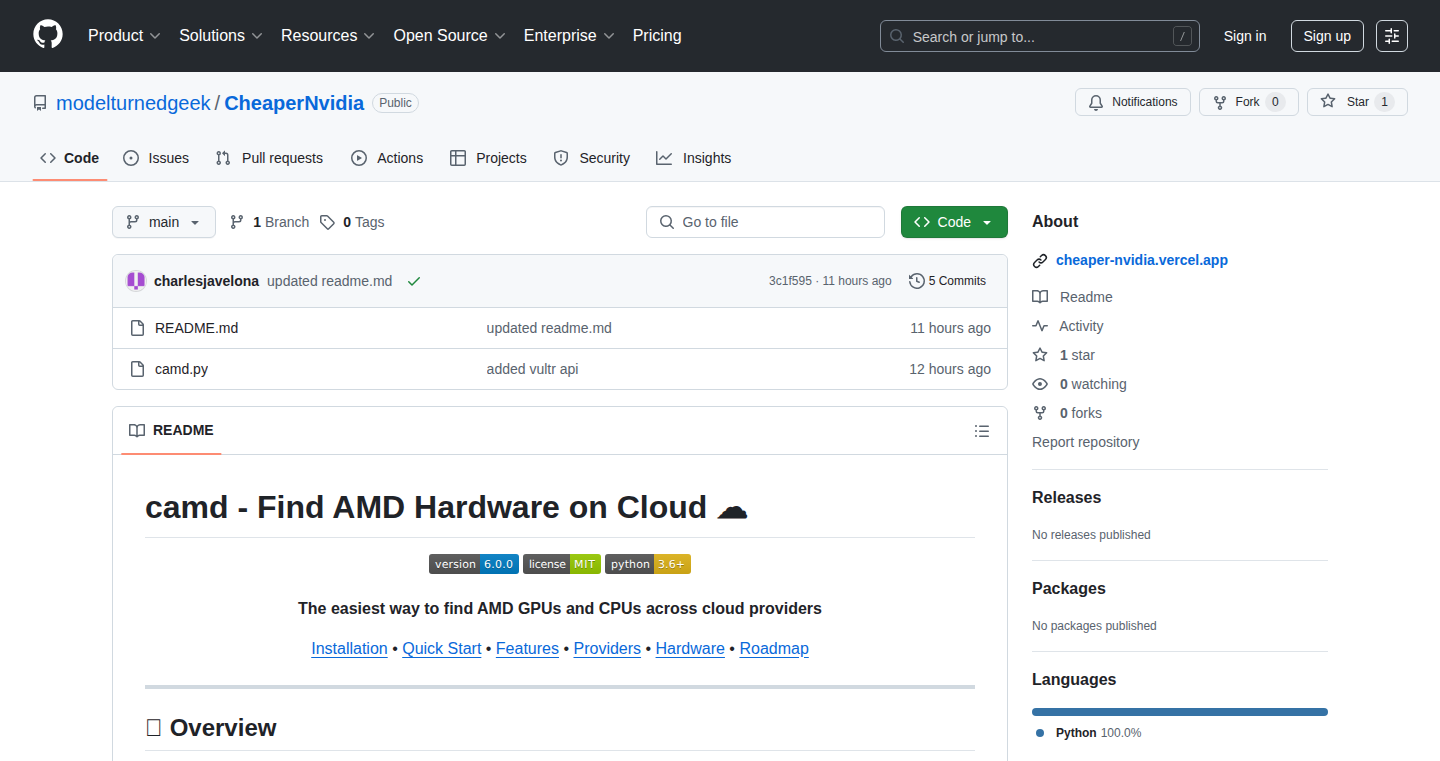
Author
cjavelona
Description
camd is a command-line tool that helps developers quickly find and access available AMD compute instances (CPUs and GPUs) across different cloud providers. It solves the problem of fragmented AMD hardware availability by aggregating pricing, specifications, and real-time availability information into a single, easy-to-use interface. The tool uses public APIs to gather information, removing the need to manually search across multiple provider dashboards. So this simplifies the process of discovering and deploying applications on AMD hardware.
Popularity
Points 2
Comments 0
What is this product?
camd is like a 'whereami' tool, but specifically for AMD hardware in the cloud. It's a command-line interface that searches across various cloud providers to show you what AMD compute instances are available, including both CPUs (like EPYC) and GPUs (like MI series and Radeon). It shows you the price, specifications, and if the instance is currently available, all in one place. The innovation here is in simplifying the process of finding and comparing AMD hardware across different cloud services. The tool uses public APIs to gather this information, so you don't have to go through individual provider dashboards. So this saves you time and hassle when searching for the right hardware for your projects.
How to use it?
Developers can use camd by downloading and running the command-line tool. You would type commands like 'camd list' to see a list of available AMD instances. It provides direct links to provision instances, which you can then use to deploy your applications. You can integrate this tool into your development workflow to quickly identify the best AMD hardware options for your needs, based on price and availability. So, imagine you're working on a machine learning project and need powerful GPU resources. With camd, you can quickly find the available AMD GPUs across various cloud providers, compare their pricing and specifications, and then directly provision the one that best fits your needs. This saves you the time and effort of manually searching each provider's platform.
Product Core Function
· Aggregating AMD Hardware Availability: The tool gathers information about AMD CPUs and GPUs from multiple cloud providers in one place. This includes details about the specific processor types (like EPYC, Ryzen, MI series, Radeon). This is useful because it gives you a single source of truth when it comes to the available AMD hardware. So this means you spend less time searching across different platforms and more time developing.
· Real-time Pricing and Specification Display: camd shows you the prices, specifications, and availability of the instances in real time. So you know exactly what you're getting and how much it will cost. This helps you compare different instances and make informed decisions about which hardware is the best fit for your project.
· Direct Provisioning Links: The tool provides direct links to provision instances. This means, once you find the instance you want, you can instantly access the instance. This significantly speeds up the deployment process. So, you can bypass the tedious process of searching on different cloud provider's interfaces.
· Unified View of the AMD Compute Landscape: It provides a single interface for the entire AMD compute landscape across different cloud providers, so you can easily find and compare different AMD instances without jumping from one provider to another. This makes the process of finding the right hardware more efficient. So this is useful because it eliminates the frustration of navigating separate dashboards and comparing options across multiple providers.
Product Usage Case
· Machine Learning Development: A data scientist needs a powerful GPU for training a machine learning model. They can use camd to quickly find available AMD GPUs (like MI300X) across different cloud providers, compare their prices and specifications, and directly provision the one that suits their needs. So, instead of spending hours searching through various cloud dashboards, they can get the information they need instantly and focus on developing their model.
· Software Testing and Development: A software developer needs to test their application on various AMD CPU instances. With camd, they can easily identify the available EPYC or Ryzen instances across different providers. They can quickly spin up the needed instances to test their applications. So this speeds up their testing process and helps them ensure their application is compatible with different AMD hardware.
· High-Performance Computing (HPC) Projects: Researchers or engineers working on computationally intensive projects can use camd to find the most suitable AMD compute resources for their workloads. They can use the tool to find and compare instances with specific specifications like CPU cores, memory, and GPU capabilities. So, they can make informed decisions about the best hardware to optimize their performance and cost.
40
AI Thumbnail Clarity Grader
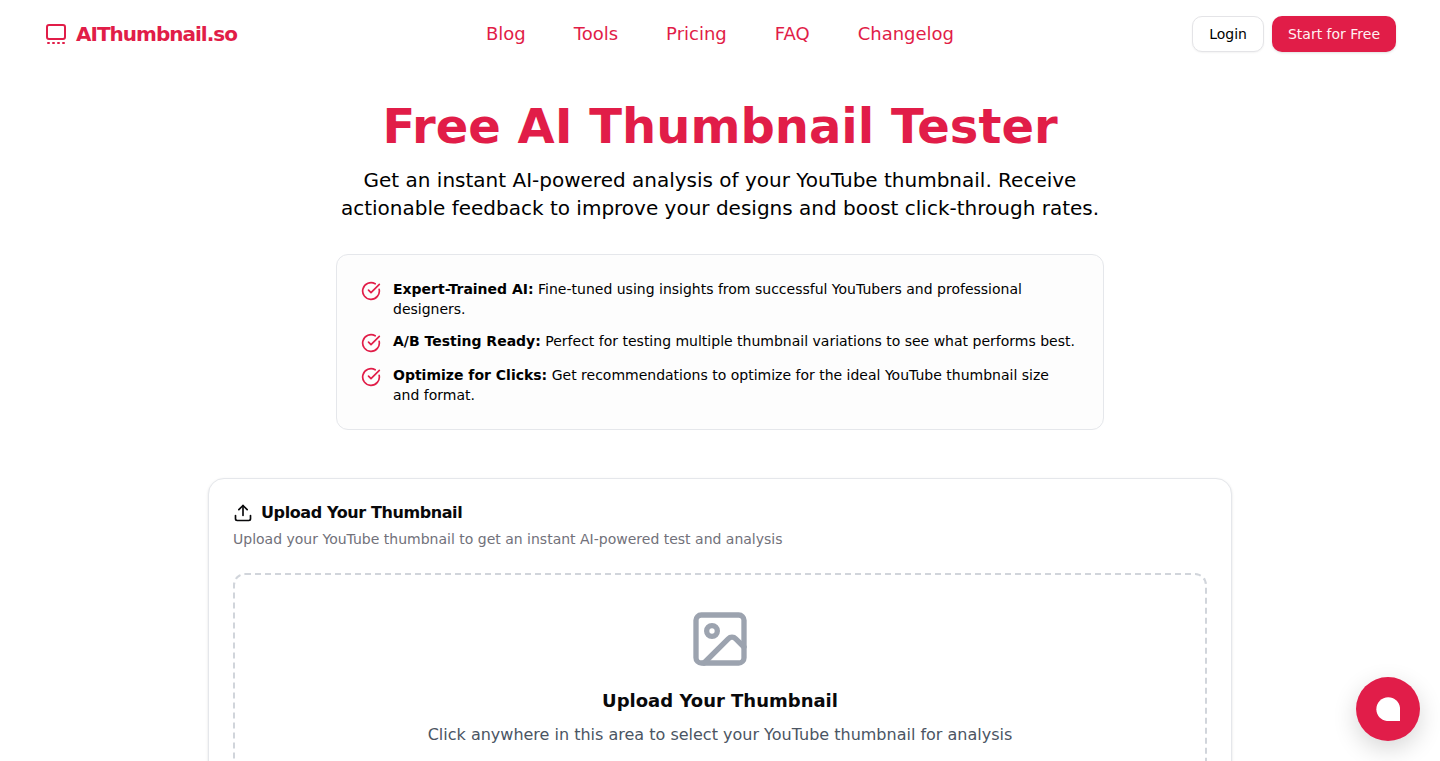
Author
sachou
Description
This project is a free AI-powered tool that analyzes YouTube thumbnails to assess their effectiveness. It uses an AI-driven checklist derived from real YouTube data to grade thumbnails on clarity, contrast, text readability, and visual hierarchy. It solves the common problem of creating effective thumbnails that grab viewers' attention and drive clicks, offering data-backed insights into visual design choices. So this is useful because it helps creators optimize thumbnails for better performance on YouTube.
Popularity
Points 2
Comments 0
What is this product?
This project leverages artificial intelligence to evaluate YouTube thumbnails based on established design principles and real-world performance data. It works by analyzing various visual aspects of a thumbnail, such as contrast, text legibility, and the overall visual hierarchy. The AI identifies potential issues and provides feedback, enabling creators to make data-driven improvements. It essentially helps you understand what makes a thumbnail visually appealing and click-worthy, without guesswork. So this is useful because it removes the guesswork from thumbnail design and helps you create thumbnails that are more likely to get clicked on.
How to use it?
Developers can use this tool by simply uploading their thumbnail images. The AI then provides a detailed analysis and grading based on the established checklist. The analysis can be integrated into the creators' workflow to get feedback on their design choices. The tool provides actionable insights which enable developers to make iterative improvements to thumbnail design. So this is useful because it can be easily integrated into your workflow and makes it easier to get data-driven feedback on your design choices.
Product Core Function
· Automated Analysis: The core function is an automated assessment of thumbnail images. The AI scans and analyses the images without any human interaction. The output is a clear score based on the design principles. So this is useful because it automates the thumbnail evaluation process, saving time and providing consistent feedback.
· Clarity Grading: The AI determines how easy it is for a viewer to quickly understand the content of the thumbnail. It focuses on the key visual elements to highlight the focal points of the image. So this is useful because it ensures the thumbnail accurately and effectively communicates the video's content.
· Contrast Evaluation: The tool analyzes the contrast levels within the thumbnail to ensure important elements are easily distinguishable. This helps prevent visual clutter and ensures that elements stand out. So this is useful because it improves the visibility of key visual elements.
· Text Readability Check: It identifies if the text used in the thumbnail is easy to read. The AI checks for font choice, size, and color to ensure the text is readable on various devices and screen sizes. So this is useful because it boosts user engagement and allows your title to be read by a larger number of viewers.
· Visual Hierarchy Assessment: The AI assesses how well the thumbnail draws the viewer's attention. It checks the use of elements like colors, sizes and the overall arrangement to guide a viewer's eye to the most important parts of the thumbnail. So this is useful because it ensures that the most crucial elements of the thumbnail are noticed first.
· Actionable Feedback: Provides a detailed report that highlights areas for improvement. This feedback is tailored to help creators make specific design changes. So this is useful because it gives creators direct guidance on how to enhance their thumbnails.
Product Usage Case
· YouTube Creators: YouTube content creators can use this tool to A/B test different thumbnail designs. They can generate multiple versions, analyze them using the AI tool, and compare the scores to see which performs best. This helps them make the best design choice. So this is useful because it enables you to see which thumbnails perform best and helps you make data-driven choices.
· Video Marketers: Video marketing agencies and professionals can use this to enhance their clients' video thumbnails. The tool provides a quick and effective way to analyze and optimize thumbnails, increasing their videos' click-through rates. So this is useful because it improves the click-through rates of the videos.
· Graphic Designers: Graphic designers specializing in video content can integrate this tool into their workflow. They can use it as a starting point for designing and refining thumbnails. So this is useful because it gives you a data-driven advantage during the designing process and assists you with decision making.
· Education: The tool can be used in educational settings to teach design principles to new designers. So this is useful because it enables people to learn about design principles and gives them immediate feedback.
41
Ape - F# Powered Minimalistic Text Editor

Author
gabrosh
Description
Ape is a barebones text editor built using F#, a functional programming language. It aims to provide a simple and fast text editing experience, focusing on core functionalities without the bloat of advanced features. The innovation lies in its use of F# for a performant, concise implementation, demonstrating the power of functional programming for UI development. It tackles the problem of needing a lightweight and quickly loadable text editor for focused writing tasks.
Popularity
Points 1
Comments 0
What is this product?
Ape is a very basic text editor. Think of it as Notepad, but created using F#, which is like a smarter, more efficient way of writing code. The main idea is to keep things simple and fast, so you can open it instantly and start writing without any distractions. The innovative part is using F# to make it work well. F# is good at this kind of job because it's designed to be fast and clear.
How to use it?
Developers can use Ape for quick note-taking, code snippet editing, or even as a starting point to understand UI development with F#. You can run it from the command line or integrate it into scripts. The core idea is to get a basic text editor that starts quickly, which is very useful when you need to quickly jot down some notes or edit a configuration file. So, if you are a developer and need a really fast and focused editor, Ape is a good option.
Product Core Function
· Text Input and Editing: Enables users to type and modify text within the editor. The value is its simplicity - no fancy features, just the basics working efficiently. Useful when you just want to write without distractions. So this is useful for writing notes, small code snippets, or configuration files.
· File Handling (Load/Save): Allows users to open existing text files and save their edits. The value is in its fundamental support for text-based workflows. This feature is essential for anyone working with text documents or code.
· Minimalistic UI: Provides a clean and uncluttered user interface. The value is it reduces distractions and enhances focus on the text. Useful for writers or programmers who value simplicity and speed.
Product Usage Case
· Quick Note-Taking: Use it to quickly jot down ideas or meeting notes without waiting for a large editor to load. This solves the problem of needing a fast and lightweight tool for capturing information.
· Code Snippet Editing: Convenient for quickly editing small code fragments or config files. This solves the problem of needing a simple tool for minor edits without opening a full-fledged IDE.
· Exploring Functional Programming: Developers can study the Ape source code to understand how UI elements are created using F#. So if you are curious about how functional programming can be used to create UIs, this is a good place to start.
42
EmojiChat: A Pure Emoji Communication Platform
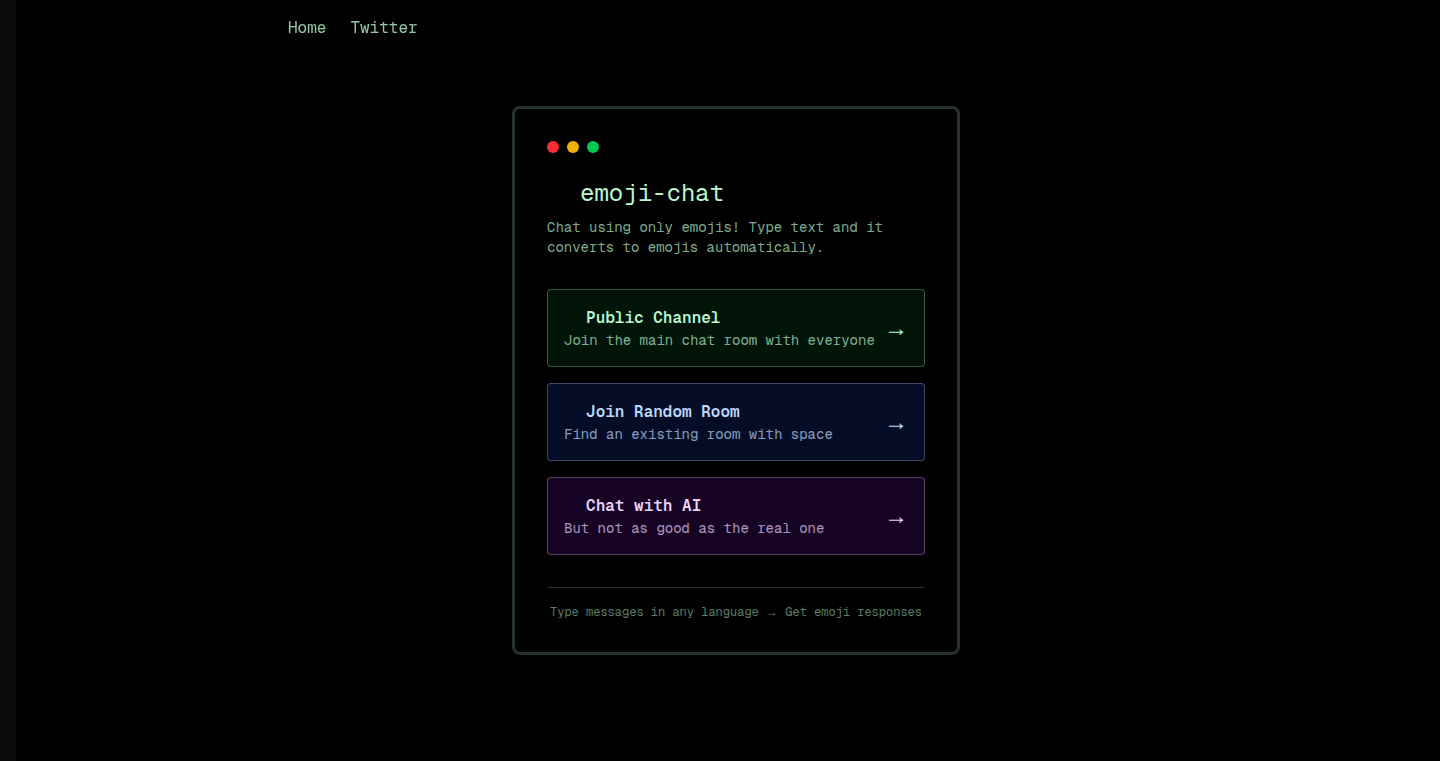
Author
MichaelYuhe
Description
This project is a chatroom built entirely on emojis. It allows users to communicate and share ideas solely using emojis. It's a playful experiment that explores the potential of non-verbal communication, creating a unique and visual chat experience. It demonstrates the power of using emojis to express complex ideas and emotions, addressing the challenge of communication without words, thus allowing for rapid and universally understood expression.
Popularity
Points 1
Comments 0
What is this product?
This project is a chatroom where every message is composed of emojis. The technical innovation lies in the custom logic that translates user input (emoji selections) into a persistent and shareable chat history. It focuses on using emojis as the only means of communication, pushing the boundaries of how we use them and demonstrating how they can convey meaning. It bypasses the need for text-based communication, allowing users to communicate across language barriers and in situations where typing is difficult or undesirable. This is built using a web-based platform, enabling accessibility from any device with an internet connection.
How to use it?
Developers can integrate this project into their applications or use it as inspiration for building their own emoji-based communication tools. You can embed the chatroom into your website to offer a unique way to communicate with your users. The integration involves simply including the necessary HTML, CSS, and JavaScript code into your web page, and can be customized easily to fit different design requirements. This demonstrates how to handle user input, manage chat histories, and display them. Its open-source nature encourages modification and remixing, letting developers expand its capabilities or tailor them to specific needs.
Product Core Function
· Emoji-Only Messaging: The core function is the ability to send and receive messages using only emojis. This showcases the power of emojis to convey information and emotions without the need for text. This has applications in scenarios where speed of communication is critical or in multilingual environments.
· Real-time Chat Functionality: The system supports real-time communication, meaning messages appear instantly for all participants. This ensures an engaging experience, similar to traditional text-based chatrooms.
· Persistent Message History: The chatroom stores the history of messages. This allows users to review past conversations and ensures that the communication is easily accessible and trackable.
· User Interface for Emoji Selection: An easy-to-use interface to select and send emojis. This feature offers a smooth user experience, allowing fast and intuitive emoji selection.
· Customization: It allows for customization of the chatroom's appearance, enabling developers to tailor it to their specific needs. This is valuable for branding and integrating the chat into different web designs.
Product Usage Case
· In-App Communication: A social media application can embed the emoji chatroom as a way for users to communicate and react to content using emojis. This enhances user interaction and engagement by enabling immediate emotional expression without requiring typing.
· Multilingual Support: Companies can use the emoji chatroom on their website as a way for their international customer support to avoid language barriers. Users from all over the world can communicate with support teams via emojis and reduce communication challenges.
· Accessibility Tool: Developers can integrate the emoji chat into tools used by people with disabilities or for users who are unable to type. This provides a non-verbal means of communication.
· Fun and Engaging Communication: Using it as an internal communication tool for team members, providing a lighthearted way to boost communication. This can improve team cohesion by promoting a casual and expressive dialogue environment.
43
EZMonitor: Solar Panel Output Visualizer for KDE Plasma
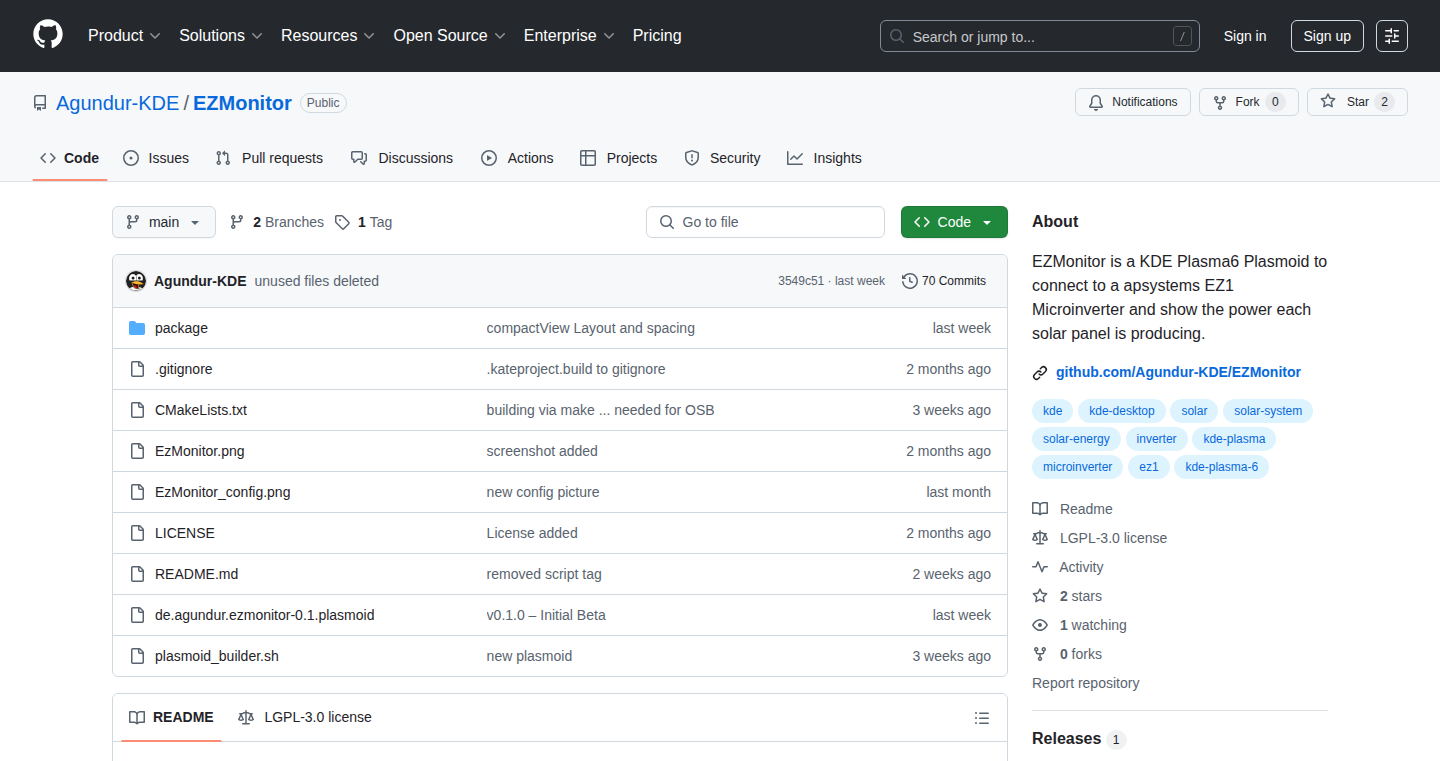
Author
Agundur
Description
EZMonitor is a KDE Plasma 6 Plasmoid that connects to an APSystems EZ1 Microinverter and displays the power output of each individual solar panel. This project tackles the problem of lack of real-time, granular data visualization for solar panel performance. It leverages the microinverter's ability to provide per-panel data, offering a deeper understanding of energy generation. This is an experimental project, demonstrating the power of custom-built monitoring solutions for specific hardware.
Popularity
Points 1
Comments 0
What is this product?
EZMonitor is essentially a custom-built widget for your KDE Plasma desktop environment. It communicates with your APSystems EZ1 microinverter (a device that converts DC power from solar panels to AC power) and graphically displays the power output from each individual solar panel. The innovation lies in the specific data extraction and presentation. Instead of just showing overall system output, it provides a breakdown for each panel, enabling you to easily identify underperforming panels or potential issues. So this gives me detailed insight into my solar power system's performance, helping me to optimize energy generation and identify potential problems early.
How to use it?
To use EZMonitor, you'll need a KDE Plasma 6 desktop and an APSystems EZ1 microinverter. You install the plasmoid on your desktop. Then, you configure it to connect to your microinverter, usually by providing the IP address or other necessary connection details. The plasmoid then starts displaying real-time data, showing how much power each panel is generating. This lets you easily monitor your solar panel's performance and identify potential problems. So, as a user, I can easily monitor my solar panel's performance directly on my desktop without needing a dedicated app or web interface.
Product Core Function
· Real-time data acquisition from the APSystems EZ1 microinverter: The plasmoid actively retrieves power output data from the microinverter. This data is the foundation for all other functions. The value is a constant stream of current performance data from your solar panels.
· Per-panel power output visualization: The plasmoid displays the power output for each solar panel individually, providing a granular view of the system's performance. This visualization enables users to quickly identify underperforming panels or potential issues such as shading or panel degradation. Therefore, you get an easy-to-understand visual representation of your solar panel's performance.
· User-friendly interface within KDE Plasma: The plasmoid integrates seamlessly into the KDE Plasma desktop environment, making it easy to access and use. So, it's easily accessible and part of your daily computing environment.
· Customization options (likely): The user can probably customize the display to fit their needs. So you can tailor the display to fit your specific solar panel setup and preferences.
Product Usage Case
· Troubleshooting: A homeowner notices one panel consistently producing less power than others. Using EZMonitor, they can quickly identify the underperforming panel and investigate the cause (e.g., shading, debris). So, I can quickly diagnose a problem with my solar panels and prevent energy loss.
· Performance Monitoring: A solar panel owner wants to keep track of their system's performance over time. EZMonitor provides a real-time, easy-to-read display of panel outputs, allowing them to assess the overall health of their system. So, I can monitor my solar panels in real time to ensure they are working optimally.
· Energy Optimization: A user is considering trimming some trees that are shading their panels. By using EZMonitor, they can evaluate how the shading affects panel output before and after the tree trimming. So, I can determine the impact of environmental factors on energy generation and make informed decisions.
· Early Problem Detection: If a panel starts producing significantly less power than normal, EZMonitor can quickly highlight this issue. This allows the user to address the problem before it leads to substantial energy loss or damage. So, I can detect problems quickly and minimize the loss of generated power.
44
Jengax: One-Click Block Structure Sketching

Author
taganz
Description
Jengax is a sketching tool that lets you build block structures by clicking. It simplifies the process of visualizing and designing structures, focusing on ease of use and rapid prototyping. The innovation lies in its intuitive, click-based interface, allowing users to quickly create 3D models without complex CAD software. It solves the problem of time-consuming and intricate model design, enabling faster exploration of structural concepts.
Popularity
Points 1
Comments 0
What is this product?
Jengax is a tool for quickly sketching 3D block structures. Instead of traditional CAD programs with steep learning curves, you create models by simply clicking to add blocks. It's built to rapidly prototype ideas and visualize designs. The innovation is the streamlined interface: it simplifies the process, removing the complexity typically associated with 3D modeling. So this allows you to quickly try out structural ideas without getting bogged down in technical details.
How to use it?
Developers can use Jengax to design structures for games, architectural models, or any project involving block-based elements. Integration is straightforward: you use a web interface to build your structure, and then export it (file format not specified, but it’s likely something like a 3D model format). This model can then be imported into your development environment. This allows rapid concept validation before committing to more complex design workflows.
Product Core Function
· One-click block placement: Quickly add blocks to the structure with a simple click. This dramatically reduces the time required to build basic structures and allows for fast experimentation. The practical application is speeding up the early stages of a 3D project, letting you test ideas without the overhead of detailed modeling. So this allows you to rapidly prototype and visualize block-based structures.
· Intuitive interface: Designed with a user-friendly interface, it requires no prior knowledge of 3D modeling software. This lowers the barrier to entry for developers who may not be skilled in complex CAD programs. So this means anyone can quickly create 3D models, regardless of their technical background.
· Rapid prototyping capabilities: Facilitates the quick creation and modification of block-based designs. So this helps accelerate the design and iteration process for 3D models.
· Potential export options (assumed): The ability to export the created models for use in other applications like game engines or 3D printing. So this enables you to integrate your designs seamlessly into a broader workflow.
· Focus on structural visualization: Emphasis on the quick and easy creation of 3D models, providing an efficient method for visualizing block structures. So this helps in quickly exploring design possibilities and understanding the 3D layout of structures.
Product Usage Case
· Game developers can use Jengax to rapidly prototype game levels and block-based environments, such as Minecraft-style worlds, before investing in more complex 3D modeling. This reduces the time spent on initial design phases and allows for quick iterations. So this is useful for quickly building and testing level designs.
· Architectural visualization: Use Jengax to create simple architectural models to visualize the basic structure of a building, like its floor plan and shape. This allows for quick explorations of different design options. So this lets you quickly visualize architectural concepts without learning complex CAD software.
· 3D printing prototyping: Quickly generate 3D models to be printed, especially useful for prototypes where the precise details aren't crucial. So this means you can design and create 3D printed objects quickly.
· Educational purposes: Teachers or students can use the tool to explain 3D concepts and experiment with 3D modeling without requiring high-end software. So this allows easier exploration of 3D design for education.
45
Rotta-rs: Simplified Deep Learning in Rust
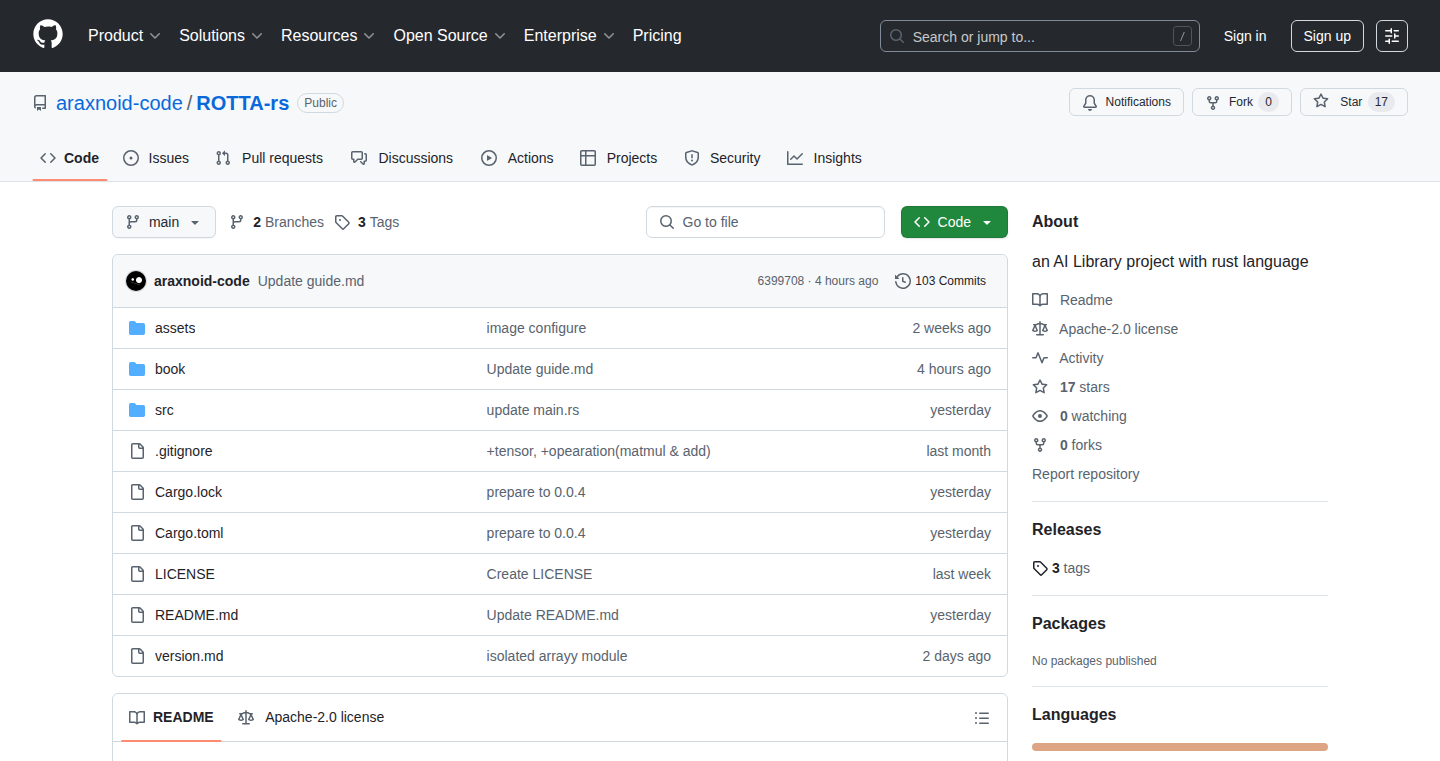
Author
araxnoid
Description
Rotta-rs is a deep learning library written in Rust, a programming language known for its speed and safety. This project focuses on making deep learning easier to use by abstracting away some of the complexities. Version 0.0.4 introduces improvements to basic operations, bug fixes, and new features like creating more flexible data structures (tensors) and adding optimization algorithms (SGD + Momentum and AdaGrad). This allows developers to build and train AI models more efficiently. So, this helps you build and experiment with AI models without getting bogged down in the low-level details.
Popularity
Points 1
Comments 0
What is this product?
Rotta-rs is a deep learning library. Imagine it like a toolbox that helps you build intelligent systems, like the ones that recognize images or translate languages. It uses the Rust programming language, which is very efficient and helps the library run fast. The innovation is in its focus on simplicity. It aims to make the complex math and coding involved in deep learning more manageable for developers. It includes improvements to how the system works, fixes bugs, and adds new tools like better ways to handle data and optimization algorithms to improve the learning process. So, it simplifies the complex world of deep learning.
How to use it?
Developers can use Rotta-rs to build and train deep learning models. You would integrate it into your Rust projects. For example, if you're working on an image recognition system, you could use Rotta-rs to define the structure of your AI model, feed it image data, and train it to recognize different objects. You might also use it to build a model to analyze text data, or create a recommendation system. So, it provides building blocks for your AI projects.
Product Core Function
· Tensor Creation and Manipulation: Allows creating and managing the fundamental data structures (tensors) used in deep learning. Value: Provides the basic building blocks for defining and manipulating data in the model. Applications: Essential for representing data and calculations in any deep learning project.
· Basic Operations: Provides optimized implementations of mathematical operations like addition, multiplication, etc. on tensors. Value: Ensures calculations are done efficiently and quickly, which is critical for training complex models. Applications: Used in every deep learning model to perform the underlying computations.
· SGD + Momentum and AdaGrad Optimizers: Implements algorithms to optimize the learning process of the model. Value: Helps the model learn effectively and converge to accurate results. Applications: Used in training the model to find the optimal parameters.
Product Usage Case
· Image Recognition: A developer could use Rotta-rs to build a model that can recognize objects in images. They would define the model architecture, feed it image data, and train it using the optimization algorithms provided. So, this lets you automatically identify objects like cars, cats, or trees.
· Natural Language Processing (NLP): A developer could use Rotta-rs to build a model to analyze and understand text. This could be used to classify documents, translate languages, or create chatbots. The developer would train the model on text data, allowing it to learn patterns and relationships in the text. So, you can build tools that understand and process human language.
· Recommendation Systems: Use Rotta-rs to create a system that recommends items to users, like movies, products, etc. You would train the model on user data and item data to predict user preferences. So, you can build personalized recommendation engines to provide a great user experience.
46
ccstat: Claude Code Session Timeline Visualizer
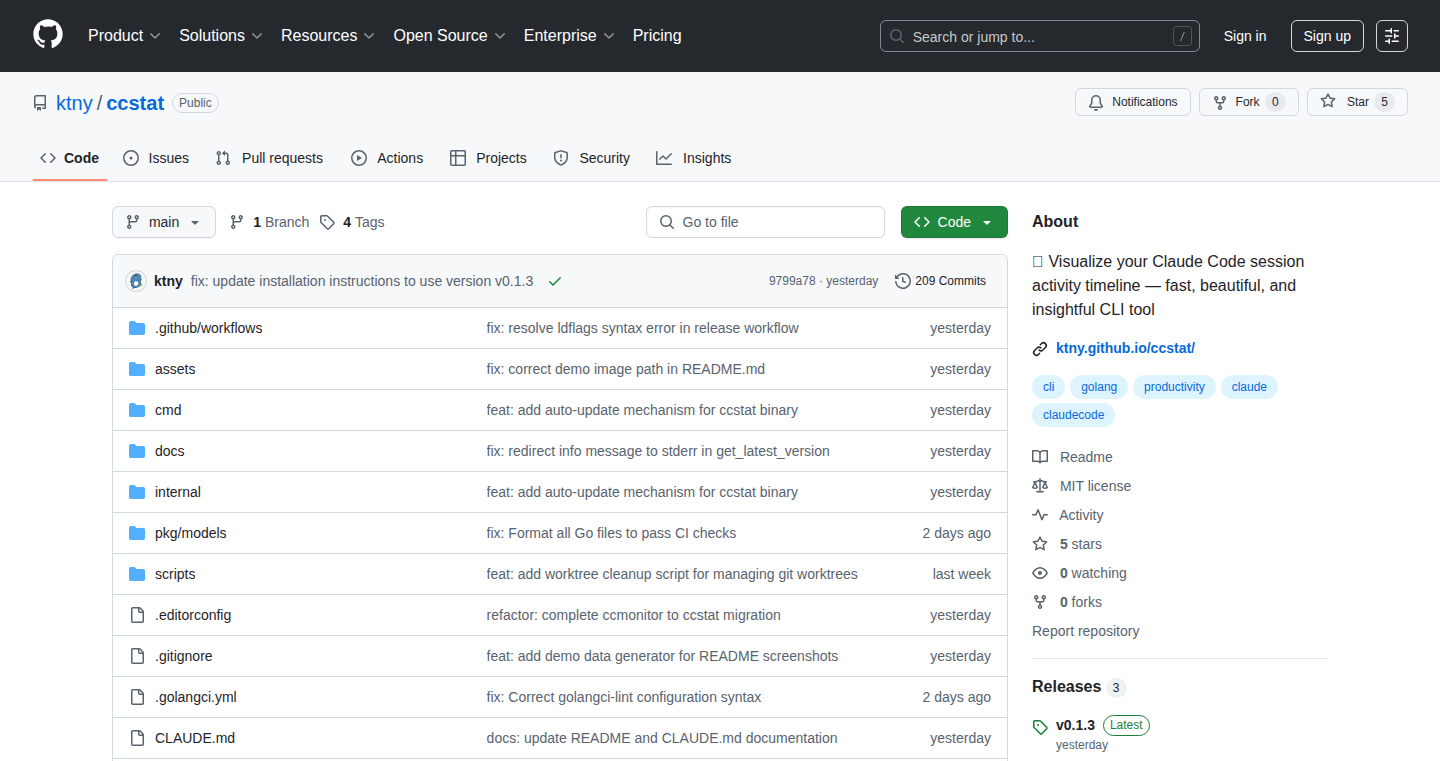
Author
ktny
Description
ccstat is a command-line tool that analyzes your conversation history with Claude Code (a coding assistant by Anthropic) and generates a timeline visualization. It transforms raw conversation data into an easily understandable format, helping you track your coding progress, identify patterns, and understand how you use Claude Code. The innovation lies in its ability to automatically parse and visualize complex session data, offering insights into your coding workflow.
Popularity
Points 1
Comments 0
What is this product?
ccstat takes your Claude Code session history and turns it into a visual timeline. Think of it as a way to see the 'movie' of your coding sessions. It analyzes the raw text of your conversations, identifies key events (like code submissions, error messages, and Claude's responses), and then organizes them chronologically in a graphical display. The innovative part is that it automates this process, making it easy to understand complex session data without manually sifting through text.
How to use it?
Developers use ccstat by running it in their terminal, pointing it towards their Claude Code session history files. It then generates an interactive timeline, often displayed directly in the terminal or as an HTML file. The tool is designed to be integrated into a developer's workflow. For example, you could analyze a debugging session to understand where you spent the most time, or review a feature implementation to see how your code evolved over time. So you can quickly get a sense of your coding patterns and identify areas for improvement.
Product Core Function
· Session History Parsing: This function reads your Claude Code conversation logs. The value here is that it can convert messy, raw text data into structured information.
· Timeline Generation: This core function creates the visual timeline. So you can easily follow the evolution of your coding session and quickly jump to specific parts of the session.
· Activity Identification: ccstat identifies key actions within the conversations, like code input, output, error messages, and Claude's suggestions. This function enhances readability by highlighting significant events.
· Interactive Visualization: The tool allows users to interact with the timeline, zooming in and out, and clicking on events for more details. So you can dive deeper into the details of your coding interactions.
· Performance Analysis: It identifies the time spent on different coding tasks and areas of conversation. So you can spot bottlenecks in your coding process or optimize your interactions with the coding assistant.
Product Usage Case
· Debugging Sessions: A developer struggling with a complex bug can use ccstat to analyze their debugging conversation with Claude Code. By visualizing the timeline, they can quickly identify the error messages, failed attempts, and successful solutions. So this saves time and effort in understanding how the issue was resolved.
· Feature Implementation: When implementing a new feature, developers can use ccstat to track the evolution of their code. They can see when they started, which parts were changed, and how Claude Code helped them. So this makes it easier to understand the design choices and the reasoning behind the code.
· Code Review: By sharing the visualization with others, developers can explain their coding choices and show the process. So this makes it easier to present the context to someone looking at a code review, promoting better code quality and collaboration.
· Learning and Improvement: By reviewing their past interactions, developers can analyze their interactions with Claude Code and identify areas where they can improve their prompts or problem-solving skills. So this helps developers to learn from their past mistakes and refine their coding skills.
47
Jotai-Powered Recoil Demo Replication
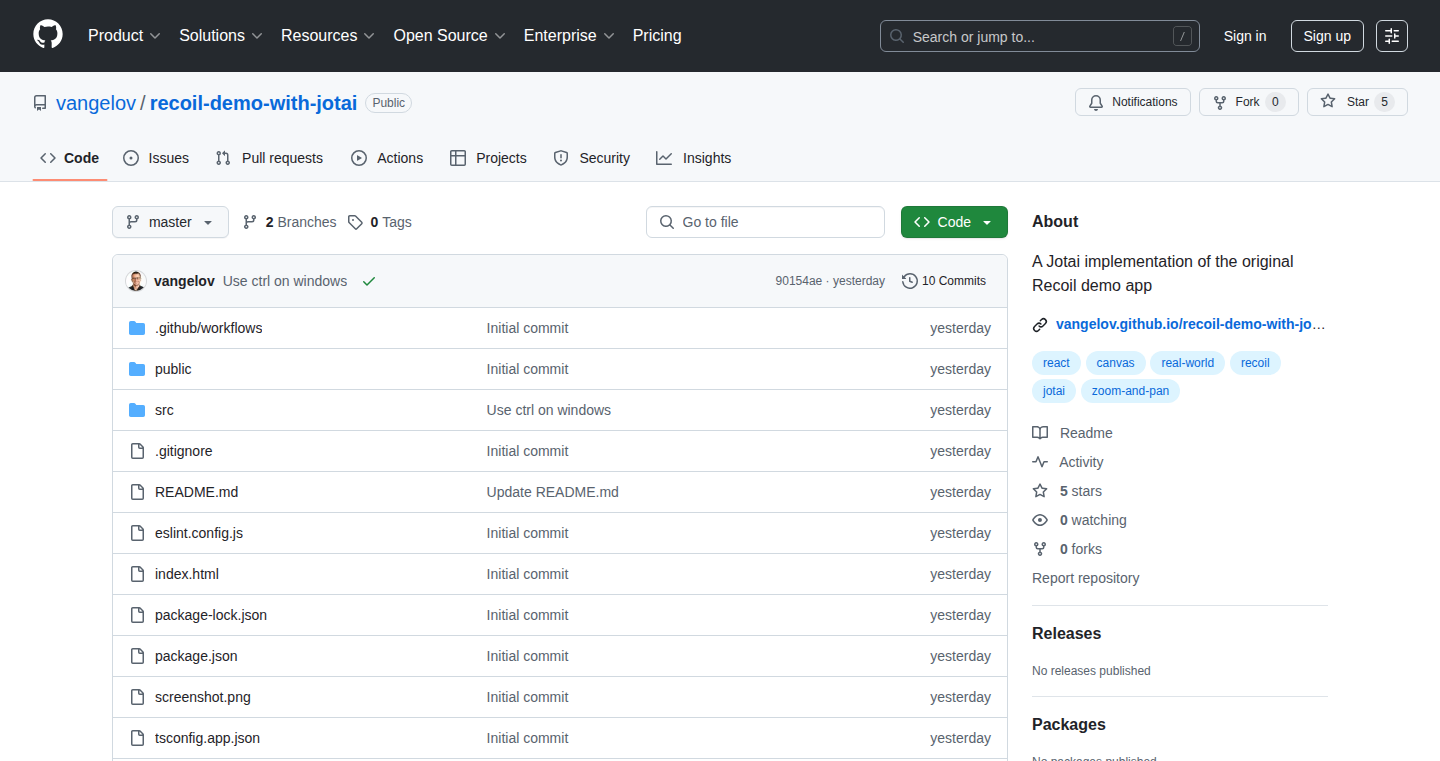
Author
vlad_angelov
Description
This project recreates the original Recoil demo app, a showcase for React's state management capabilities, using Jotai. It's a technical experiment to compare how Jotai, another state management library, performs in a complex application with many independent components and real-time state updates. It highlights the technical approaches to efficiently manage and update state in a React application.
Popularity
Points 1
Comments 0
What is this product?
This project is a direct reimplementation of a demo designed to showcase Recoil, a state management library for React, but this time using Jotai. Jotai is a library that helps manage application state more efficiently. The original demo features many interactive widgets, each managing its own state, simulating real-time interactions. This project allows developers to compare the performance of Jotai against other state management solutions, understanding the intricacies of fine-grained re-rendering and subscription models. So this gives developers an alternative way to manage state in their React applications.
How to use it?
Developers can use this project as a reference implementation to understand how Jotai handles complex state management scenarios. They can examine the codebase to learn how to structure state, manage updates, and optimize re-renders in their own React applications. It is directly comparable to the original Recoil demo, offering a different perspective on state management in React. Developers can integrate Jotai in their React projects by installing it via npm or yarn and then creating 'atoms' (state containers) and 'hooks' (functions to access and modify state) and use the atom for state manage. So, developers can learn a new state management solution and also learn how to improve their React applications.
Product Core Function
· State Management with Atoms: Jotai utilizes 'atoms' to manage state. An atom is a single unit of state, much like a variable. Developers can create multiple atoms to store different pieces of information within their application. This structured approach makes it easier to understand and maintain application state. This helps organize application state making it easier to maintain.
· Fine-Grained Updates and Re-renders: The project showcases how Jotai efficiently handles updates. When a state changes, only the components that depend on that specific state are re-rendered, minimizing unnecessary computations and improving performance. This improves application performance, especially in complex user interfaces with frequent updates.
· Real-Time Interaction Simulation: The demo simulates real-time interactions. This allows developers to see how Jotai manages frequent state changes and updates in response to user actions. It demonstrates Jotai's ability to efficiently handle dynamic data updates. So developers can understand how to efficiently manage real-time updates.
· Component Independence: The demo app is built with many independent components, each managing its own piece of state. This isolates state management to individual components, reducing interdependencies and making it easier to understand and maintain. This makes applications easier to maintain and debug.
Product Usage Case
· Interactive Dashboards: When building interactive dashboards with real-time data updates, Jotai can be used to manage the state of various widgets, ensuring efficient re-rendering when data changes. This makes dashboards responsive and reduces load times.
· E-commerce Platforms: In e-commerce platforms, Jotai can be used to manage shopping carts, user profiles, and product details, where state changes frequently. By only re-rendering the necessary components when the cart updates, the user experience is significantly improved.
· Real-Time Collaboration Tools: In collaborative applications like online document editors or project management tools, Jotai's ability to manage real-time updates can be utilized. State changes from other users can be reflected quickly and efficiently without re-rendering the entire application.
· Complex Form Management: When developing complex forms with multiple fields and real-time validation, Jotai can efficiently manage form data and ensure that only the necessary parts of the form are updated when a user interacts with it. This makes forms responsive and reduces the need to recalculate the whole form.
48
Domain Addicts Anonymous: A Web Intervention for Domain Hoarders
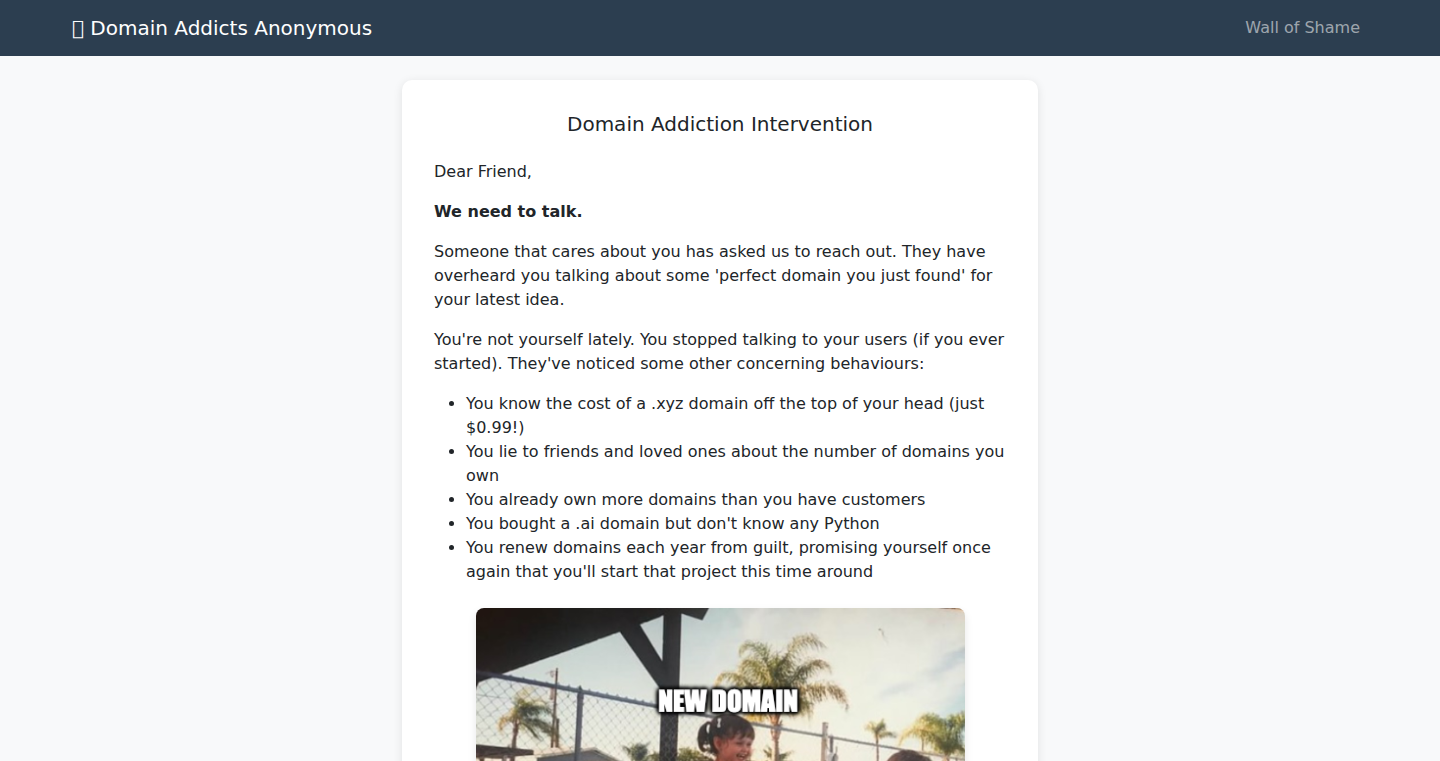
Author
mattdotam
Description
This project is a tongue-in-cheek website designed to help developers who spend more time buying domain names than actually building and shipping their projects. It provides a funny intervention letter and a 'Wall of Shame' to verify domain collections, aiming to remind developers to focus on building products rather than collecting domain names. The innovative aspect lies in its humorous approach to a common developer problem: procrastination fueled by domain acquisition. So, this helps developers focus on what matters most: building and launching projects.
Popularity
Points 1
Comments 0
What is this product?
This is a website that acts as a humorous intervention for developers obsessed with buying domain names. It uses a lighthearted approach, offering a personalized intervention letter and a publicly verifiable 'Wall of Shame' where users can share and verify their domain collections. The technical implementation is likely a simple web application, probably using HTML, CSS, and JavaScript on the front-end, with a backend to manage the domain verification database. The innovation is in the creative use of this technology to address a very specific developer problem, showcasing a clever blend of web technologies and psychological insight. So, it gives developers a self-aware tool to tackle procrastination.
How to use it?
Developers can visit the website, personalize an intervention letter, and even add their domain collection to the 'Wall of Shame' for verification. It's a simple website. The backend likely verifies domains via TXT records, which are a standard way to verify domain ownership. So, developers can get a lighthearted reality check about their domain acquisition habits.
Product Core Function
· Personalized Intervention Letter: The website generates a customized letter addressing the developer's domain acquisition habits. This feature uses basic web form input and text generation to create the letter. So, it creates a humorous intervention to address the problem.
· Domain Verification and 'Wall of Shame': The site allows users to verify their domain holdings via TXT records and display them on a public page. This involves parsing domain records and database management. So, it publicly showcases the scale of domain hoarding and encourages self-reflection.
Product Usage Case
· A developer struggling to launch their main project and constantly buying domains can use this tool as a reality check, to remind themselves to prioritize project building over domain hunting. This helps them stop the vicious cycle. So, it combats procrastination.
· A development team can use this website internally as a shared joke, reminding team members to focus on project completion. This can foster a culture of accountability. So, it promotes team productivity.
49
Autodev-codebase: Local Code Embedding Indexing Service
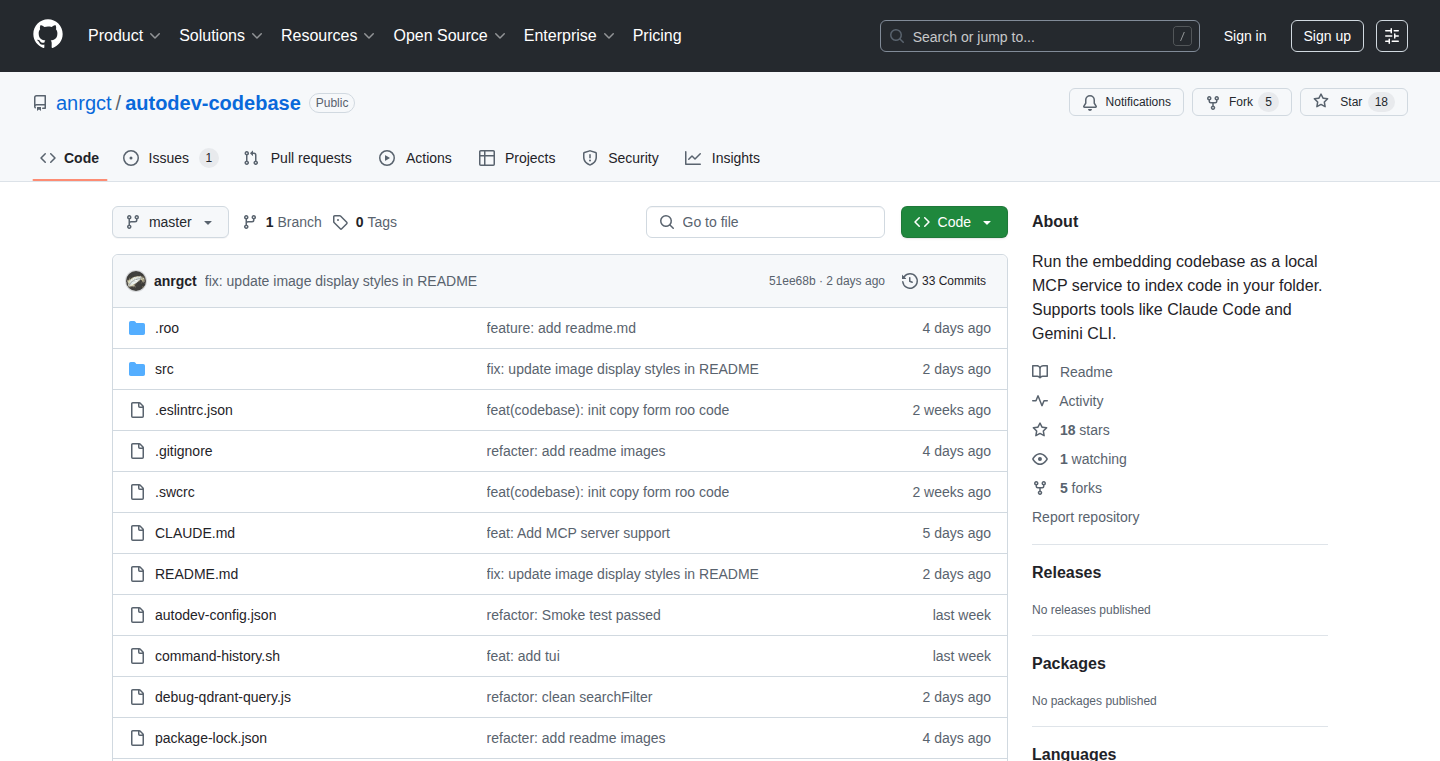
Author
anrgct
Description
This project introduces a local service that helps you understand and navigate your codebase using code embeddings. It builds an index of your code's meaning (represented as vectors) and allows you to search and retrieve relevant code snippets based on semantic similarity. This is an innovative approach to code search, moving beyond simple keyword matching to understand the intent and context of your code. Think of it as a personalized knowledge graph for your project, making it easier to understand and maintain your codebase.
Popularity
Points 1
Comments 0
What is this product?
Autodev-codebase creates a semantic index of your source code. It uses a technique called 'code embedding' to convert your code into numerical representations (vectors). These vectors capture the meaning of your code. When you search, it compares the vector of your search query with the vectors of your code and returns the most relevant code snippets. So, instead of searching by keywords, you're searching by meaning. This is a big deal because it allows you to find code related to the concept you are trying to implement, even if it doesn't explicitly mention the same keywords. This is particularly useful in large codebases where understanding the overall architecture is difficult.
How to use it?
Developers can use this service locally. You typically run the service, point it to your codebase, and it will build the index. Then, you can interact with it through an API, for example, with a code editor plugin. You can provide a natural language query, and the service will return the relevant code snippets. The integration is done through a simple API call, making it easy to incorporate into existing development workflows. For example, it could be used to find code examples that are similar to the code you are currently writing, or to understand how a certain function is implemented in other parts of the project.
Product Core Function
· Code Indexing: This is the core of the service. It analyzes your source code and converts it into numerical vectors, capturing the semantic meaning of code. This is useful because it enables a deeper understanding of the code's function beyond just looking at keywords. So this gives a better understanding of what the code actually *does*. This allows developers to quickly understand the role of various components and functions.
· Semantic Search: This function enables searching the code index using natural language queries. This is very useful because it allows you to find code snippets related to your query, even if they don't contain the exact keywords. It understands the intent behind the query. This feature helps developers quickly locate the code they need, regardless of the exact wording used to describe it.
· Local Execution: The service runs locally. This is very useful for protecting the privacy of the code and avoiding any latency issues associated with cloud-based services. This is especially crucial for projects with sensitive intellectual property, it keeps your code data safe.
· API Access: This allows easy integration with code editors or other development tools. This is useful because it allows you to directly access the service from your coding environment. This means that developers can search and browse your code's meaning, all inside the code editor, improving productivity.
Product Usage Case
· Understanding a New Project: Imagine you're joining a new project. Autodev-codebase can help you quickly understand the code. By searching with questions like 'how to handle user authentication' or 'how to connect to the database', you can find related code snippets. This significantly reduces the learning curve and accelerates onboarding.
· Refactoring Code: When refactoring, you often need to find all the code that uses a specific function or variable. Instead of manually searching for every instance, you can use Autodev-codebase to find code that's semantically similar. This helps ensure you don't miss any dependencies and helps maintain the integrity of the code.
· Code Reuse: If you are looking for examples on how to use a library or perform a certain action, you can query the system with natural language terms, which will return very relevant snippets from your codebase. This speeds up the process of building features by avoiding redundant code and enhancing development speed.
50
VibeSleep: Rapid Sleep Cycle Calculator
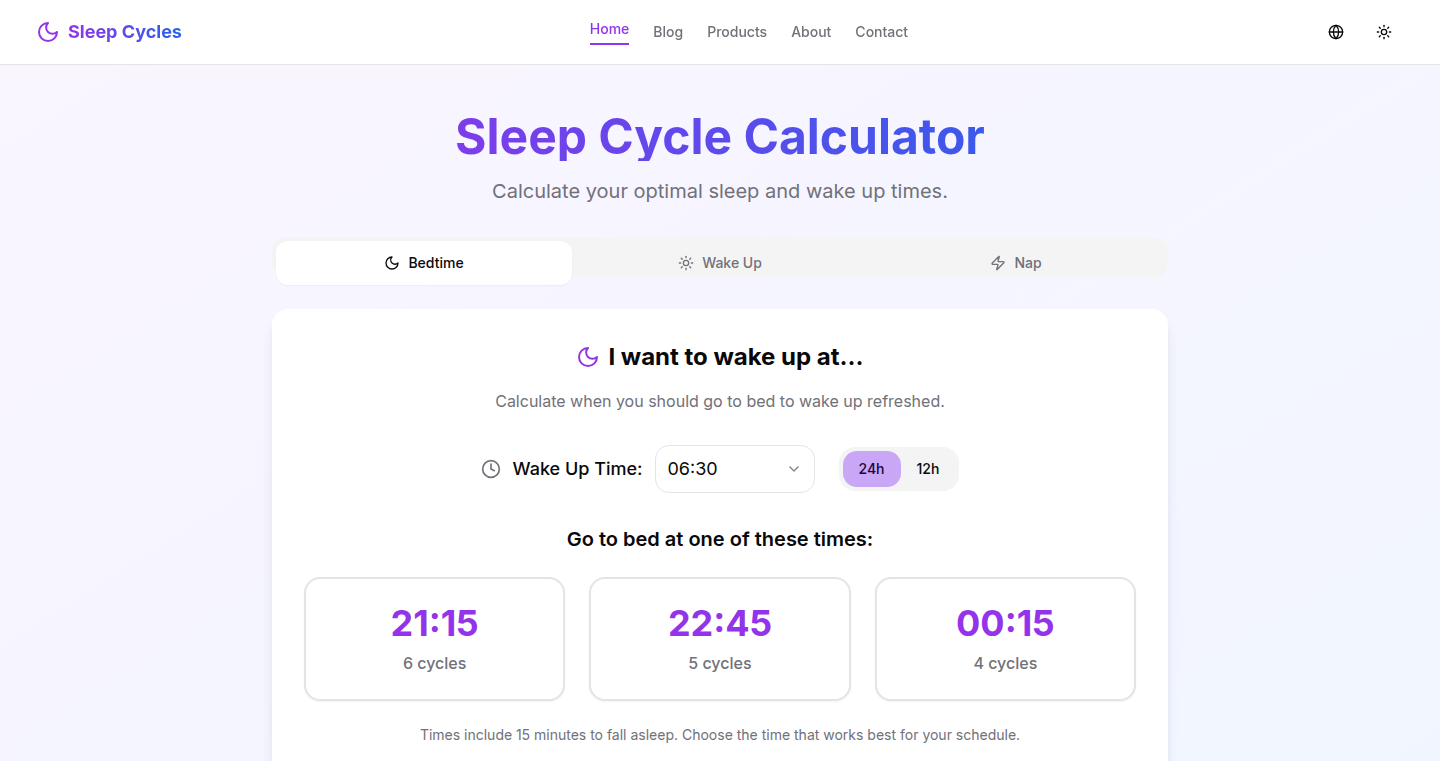
Author
achahoud
Description
VibeSleep is a quick and dirty sleep cycle calculator built in under 12 hours. It allows users to determine optimal wake-up times based on their sleep cycles, aiming to help them feel more refreshed. The technical innovation lies in its quick development cycle and the practical application of a well-understood concept (sleep cycles) using efficient coding practices, offering a simple yet valuable tool for anyone interested in optimizing their sleep.
Popularity
Points 1
Comments 0
What is this product?
This is a simple web application that calculates the best times for you to wake up, based on your body's natural sleep cycles. It's built very quickly – showing that complex problems can be approached with fast and effective coding. It focuses on calculating sleep cycles by considering the length of each cycle (around 90 minutes) and helping you determine the number of cycles to get a good night's rest. It’s an example of taking a known principle (sleep cycles) and turning it into a practical tool.
How to use it?
You'd use it by inputting when you want to go to bed and it will suggest ideal wake-up times, calculated to help you wake up feeling refreshed. Think of it as a smart alarm clock assistant. You can integrate this concept into other applications or scripts focused on time management or health monitoring.
Product Core Function
· Sleep Cycle Calculation: The core function is calculating sleep cycles. It determines the optimal wake-up times based on the time you go to sleep and the duration of each sleep cycle (around 90 minutes). This allows you to wake up at the end of a sleep cycle, potentially avoiding grogginess. So this allows you to wake up feeling more refreshed.
· User-Friendly Interface: It likely has a simple and easy-to-use interface. The key here is ease of use – making the complex topic of sleep cycles accessible to everyone, regardless of their technical expertise. So this makes it simple to use.
· Quick Development: The fact that it was coded in under 12 hours demonstrates the power of rapid prototyping and efficient coding. This highlights the ability to swiftly create functional tools. So this shows how fast things can be built.
Product Usage Case
· Personal Sleep Optimization: Use it as a personal tool to calculate wake-up times, helping you improve your sleep quality and feel more rested. This helps you feel better and more productive.
· Integration with Other Apps: Developers could integrate the sleep cycle calculation into their own apps, such as health trackers or time management tools. This could improve the apps and enhance the users' experience.
· Learning and Experimentation: For developers, it serves as a practical example of how to quickly build a useful application, demonstrating rapid prototyping techniques and problem-solving in a very short time. This gives developers the skills to build other helpful things.
51
ContextMapper: A Privacy-Focused LLM Context Mapping Tool
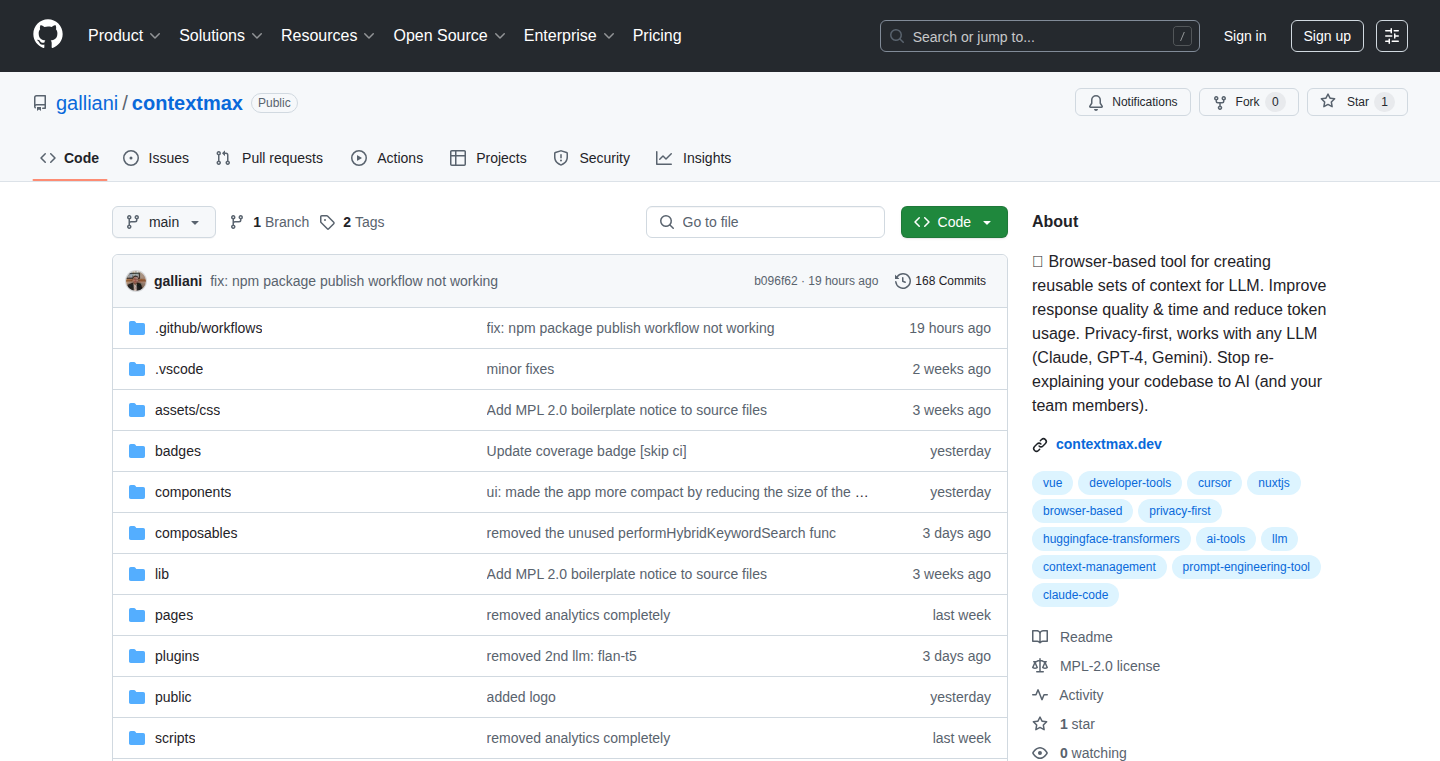
Author
uchigatana
Description
ContextMapper is an open-source tool designed to help you understand and organize the information provided to large language models (LLMs). It focuses on maintaining your privacy by working locally. The key innovation is its ability to map the relationships between different pieces of information (contexts) you feed an LLM, allowing you to see how the model interprets and connects these pieces. This helps to clarify the model's reasoning and improve your control over the information it uses, all while keeping your data secure on your device.
Popularity
Points 1
Comments 0
What is this product?
ContextMapper is a local, open-source tool for visualizing the contexts you provide to LLMs. Imagine giving an LLM a bunch of different documents, and wanting to understand how the LLM is actually using those documents. This tool creates a map showing how these pieces of information relate to each other, revealing potential connections or overlaps in the LLM's understanding. It does this by analyzing the text and building a graphical representation of the relationships between different context elements. Because it's local, your data never leaves your device, giving you complete privacy. So, what's the benefit? You can improve the quality of the answers you get from the LLM, understand the LLM's behavior better, and protect your sensitive information. This is a game-changer because you are not limited by the LLM's knowledge or understanding of the documents you provide.
How to use it?
Developers use ContextMapper by feeding it their context data (like text documents, code snippets, or any textual information) that they intend to use with an LLM. The tool then analyzes this data, generates a visual map showing the relationships and connections, and you can see how the LLM will perceive the data provided. This allows developers to refine the context for better results, troubleshoot unexpected behavior, and gain deeper insights into the model's workings. For example, you can use it to ensure an LLM gets the right information, and use it with specific tools and LLMs (like OpenAI, or any LLM with local access).
Product Core Function
· Context Mapping: It analyzes your input data (e.g., text documents, code snippets) and creates a visual map showing the relationships between different context elements. Value: Helps developers understand how an LLM interprets and connects information. Application: Debugging the reasoning of an LLM, ensuring the right context is used for specific tasks.
· Local Processing: All data processing occurs locally on your device. Value: Ensures user privacy by preventing sensitive information from being sent to external servers. Application: Working with confidential documents or code, building privacy-focused LLM applications.
· Open-Source: The code is publicly available for anyone to use, modify, and contribute to. Value: Promotes transparency, community collaboration, and allows developers to customize the tool to their specific needs. Application: Building customized LLM tools, integrating with existing software, and contributing to the project's development.
· Relationship Visualization: Presents the context connections in a visually intuitive way. Value: Enables quick identification of key concepts, overlaps, and potential knowledge gaps in the context data. Application: Improving the accuracy and relevance of the LLM's output, understanding how it interprets and processes information.
Product Usage Case
· Legal Document Analysis: A lawyer uses ContextMapper to analyze a collection of legal documents they're feeding to an LLM for summarization. The tool visualizes the connections between different clauses and sections, helping the lawyer identify potential contradictions or inconsistencies in the documents before the LLM summarizes them, saving time and reducing errors.
· Code Documentation Exploration: A developer uses ContextMapper to understand the relationships between various classes, functions, and documentation files within a large software project when instructing an LLM to create a code-writing model. The map helps the developer understand how the LLM processes the code, allowing them to improve code generation. This can lead to a deeper understanding of the codebase.
· Research Paper Organization: A researcher employs ContextMapper to organize and analyze a collection of research papers they feed to an LLM for a literature review. The tool visualizes the relationships between concepts and findings across papers, helping the researcher identify key themes and gaps in the existing literature. This will then help speed up the research progress.
52
LiveAsset: Real-time Asset Tracking with Kafka and Flink
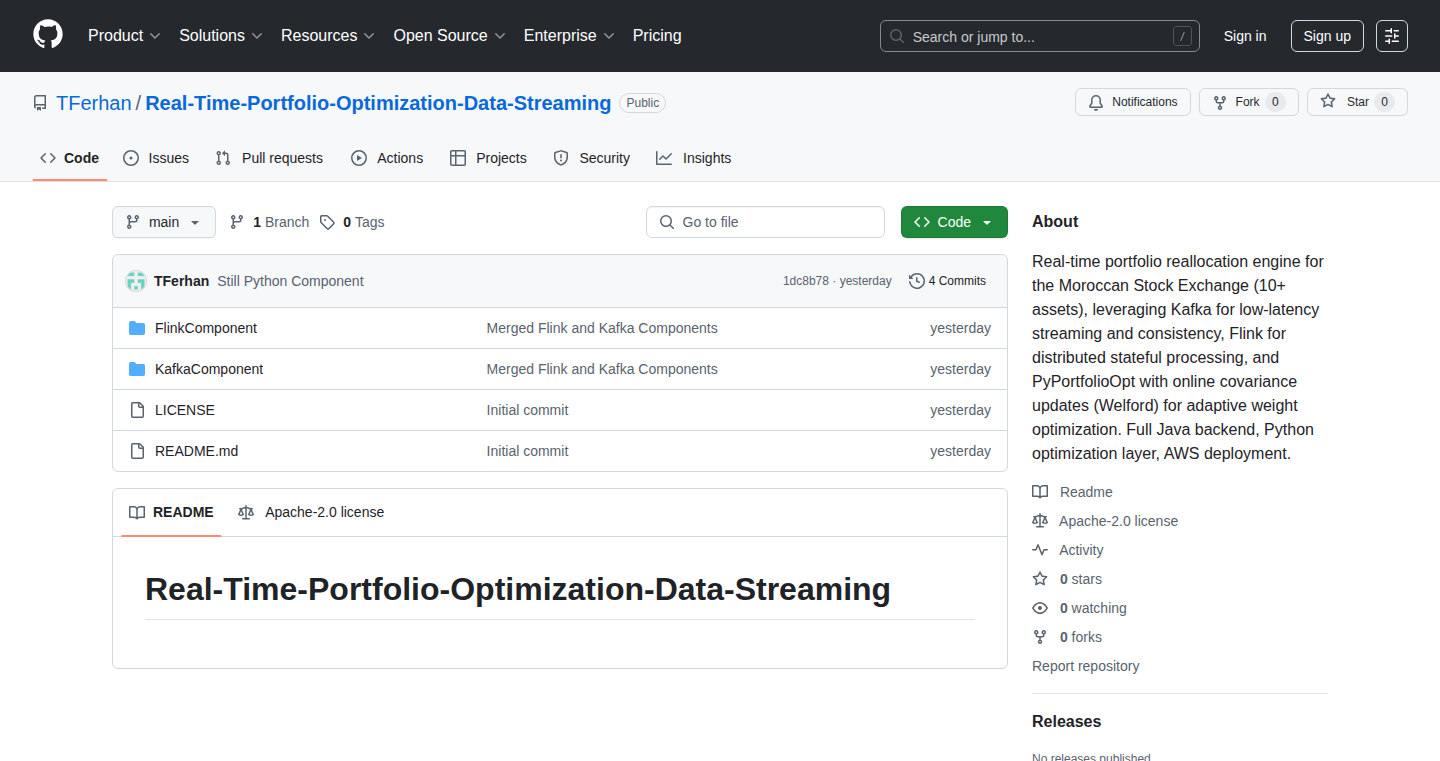
Author
pirimi
Description
LiveAsset is a system for managing assets (think anything from stock prices to sensor readings) in real-time using Kafka (a message streaming platform) and Flink (a stream processing engine). It addresses the problem of needing up-to-the-second information, enabling immediate responses to changes in data. The innovation lies in its ability to process massive data streams and deliver insights almost instantly.
Popularity
Points 1
Comments 0
What is this product?
LiveAsset uses Kafka to collect a constant flow of information, like a high-speed data pipeline. This data is then processed by Flink, which analyzes the data as it arrives. The key innovation is its ability to provide real-time insights, allowing for immediate reactions to changing data. This is much faster than traditional methods that process data in batches.
How to use it?
Developers can use LiveAsset to build applications that require instant data analysis. You can integrate it by setting up Kafka to receive your data streams and configuring Flink to perform the necessary calculations and analysis. This enables you to monitor real-time events, track metrics, and trigger automated actions based on incoming data. So this tool is beneficial if you want your system to react instantly to data changes.
Product Core Function
· Real-time Data Ingestion: Using Kafka to collect and store data streams. This allows for continuous and rapid data input, ensuring all information is captured. This means you can feed data from various sources continuously.
· Stream Processing with Flink: Flink processes the data streams in real-time, analyzing it as it arrives. It performs calculations, transformations, and aggregations to derive insights, allowing instant reactions to changes. It helps developers gain immediate insights.
· Real-time Monitoring and Alerts: LiveAsset can be configured to trigger alerts based on specific conditions in the data. For instance, if a stock price suddenly drops, an alert is sent. This helps you react quickly to important events.
· Data Transformation and Enrichment: Developers can transform and enrich the raw data streams to create more meaningful information. For example, adding context to sensor data, or combining financial data with external market data.
· Scalable Data Processing: LiveAsset is built for handling large volumes of data. Kafka and Flink are designed to scale horizontally, so you can handle increasing amounts of data without slowing down. It allows developers to process huge datasets.
Product Usage Case
· Financial Trading: A trading firm uses LiveAsset to analyze real-time stock prices and detect anomalies. When a stock's price suddenly drops, LiveAsset immediately alerts the traders, allowing them to react before the price goes down further. This helps in making quick decisions and reducing financial losses.
· IoT Sensor Monitoring: An industrial company uses LiveAsset to monitor sensors on its machinery. If a sensor detects a sudden change in temperature or pressure, LiveAsset triggers an alert to the maintenance team. It prevents equipment failures and enables proactive maintenance.
· Fraud Detection: An e-commerce platform uses LiveAsset to analyze real-time transaction data. If a suspicious transaction is detected, like a large purchase from an unusual location, LiveAsset alerts the fraud prevention team to take immediate action, protecting the platform from financial losses.
· Supply Chain Management: A logistics company utilizes LiveAsset to track the movement of goods in real time. When a shipment is delayed or deviates from its planned route, LiveAsset sends immediate notifications, enabling the company to address problems promptly and keep the supply chain on schedule. It facilitates real-time visibility and control over the delivery of goods.
53
Vidduo: AI-Powered Video Generation from Images and Prompts

Author
yorkyarn
Description
Vidduo is an AI agent that rapidly converts images or text prompts into 1080p videos, typically within 10-30 seconds. This project leverages advanced AI models to create videos, incorporating image generation capabilities, and offering diverse style options, precise camera control, and multi-shot storytelling. The core innovation lies in its speed, cost-effectiveness, and the automated selection of the optimal AI model to balance quality, speed, and cost. So, it offers a simple way to generate professional-quality videos without complex editing skills.
Popularity
Points 1
Comments 0
What is this product?
Vidduo is an AI-powered platform using sophisticated machine learning to generate videos. It begins with either an image or a text description (a 'prompt'). The AI then interprets this input and generates a video, often incorporating animation and movement. The system intelligently chooses the best AI model available to optimize for speed, cost, and video quality. It also provides features like multi-shot storytelling and diverse style options. So, this is like having an instant video production studio at your fingertips.
How to use it?
Developers can integrate Vidduo into their workflows or applications via an API or by using it directly through the website. They can use the API to automatically create videos based on user-generated content, customer interactions, or any data they have. For example, developers of e-commerce platforms could instantly create product videos from product images and descriptions. So, it's an excellent tool for automating video creation and enhancing user experiences.
Product Core Function
· AI-Powered Video Generation: Transforms images or text prompts into videos. This is valuable because it automates video creation, making it accessible to anyone, regardless of technical expertise.
· Image Generation: The built-in image generation allows users to create images and then immediately turn them into videos. This is beneficial for generating custom content, allowing for more creative control from start to finish.
· Fast Processing: Videos are generated in 10-30 seconds. This fast turnaround time allows for rapid content creation and experimentation, saving significant time compared to traditional video editing.
· Cost-Effective: Priced from $0.10 per video. This affordability makes video creation accessible to even small businesses and individual creators, democratizing the power of video marketing.
· Model Selection: Automatically selects the best AI model for quality, speed, and cost. This optimizes the video generation process, providing the best results without requiring users to understand the complexities of AI models.
· Multi-Shot Storytelling: Allows for creating videos with multiple scenes or shots. This enables the creation of more complex and engaging content, useful for storytelling or tutorials.
· Diverse Style Options: Provides different visual styles for videos. This gives users creative control and the ability to tailor videos to match a specific brand or aesthetic.
Product Usage Case
· E-commerce: An online store can use Vidduo to automatically generate product demonstration videos from product photos and descriptions. This enhances the customer experience, potentially increasing sales and improving product understanding.
· Social Media Content: Social media managers can use Vidduo to quickly create engaging video content for various platforms, like short promotional clips or animated posts, from existing images and ideas. This helps maintain a consistent content stream and capture audience attention.
· Educational Content: Educators or online course creators can use the tool to create explainer videos or visual aids for their lessons. This can make learning more engaging and easier to understand, leading to improved learning outcomes.
· Marketing Material: Marketing teams can generate videos for advertisements, social media, or websites without the need for professional video editing. This provides more control over the creative process and quick iteration.
54
EmojiCode: The VS Code Extension That Brings Your Code to Life (Without Breaking It)
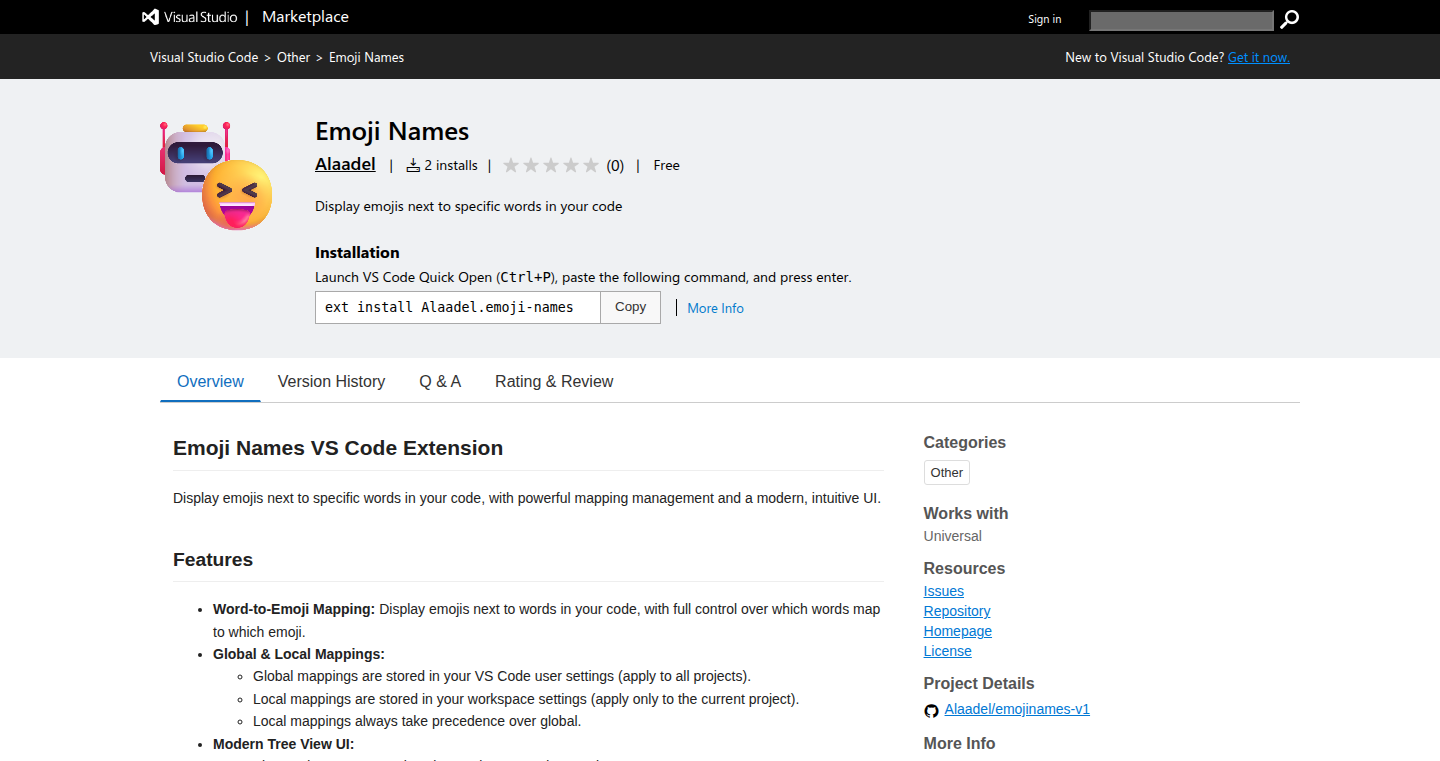
Author
xalaa
Description
EmojiCode is a VS Code extension that spices up your code with emojis. It adds visual cues to your code, making it easier to scan and understand at a glance, especially when navigating complex projects. The clever part? It achieves this without modifying your actual code, meaning no worries about breaking your syntax or causing compilation issues. This solves the problem of tedious scrolling through long lines of code and type definitions by providing a lightweight, non-intrusive way to visually organize and personalize your codebase.
Popularity
Points 1
Comments 0
What is this product?
EmojiCode is like adding sticky notes to your code, but instead of text, you get emojis! The extension scans your code and attaches emojis to certain elements, like class names or function types. The cool part is, it doesn't change your code itself. It uses VS Code's capabilities to add visual decorations on top of your existing code, making it more readable and fun. So, instead of staring at endless text, you get visual hints, which helps you quickly grasp what's going on. The innovation lies in its non-intrusive approach, keeping your code clean and avoiding any potential conflicts with your existing setup. So this is useful because it offers a way to quickly understand different parts of the code without modifying the actual code itself.
How to use it?
Developers install EmojiCode through the VS Code Marketplace. Once installed, the extension automatically starts decorating your code. You can customize which code elements get emojis and choose which emojis to use. For instance, you can map a specific emoji to all classes or function declarations. This makes code review faster and easier by quickly identifying components. The extension is best used when working on large projects or when collaborating with others. You can also use it to visually distinguish between different types of classes, functions, or components. So, you can use it to personalize your development experience and improve readability, especially for complex codebases.
Product Core Function
· Emoji Decoration: The core feature of the extension is the ability to decorate your code with emojis based on code element types (classes, functions, etc.). This makes it easier to scan through the code and understand its structure quickly. So, this function is useful because it helps you quickly grasp what different parts of the code do, particularly in large and complex projects.
· Customization Options: Developers can customize which elements receive emojis and which emojis are used. This provides flexibility to personalize the visual representation according to their preferences and needs. So, you can use this function to make the code more readable for yourself and your team by using emojis that you find most intuitive and descriptive.
· Non-Intrusive Integration: The extension doesn't alter the original code. It uses VS Code's decoration API to overlay emojis on top of your existing text, ensuring no compilation issues or syntax highlighting problems. So this is useful because it ensures that your code stays clean and maintainable, without causing compatibility issues.
· Easy Installation and Use: The extension is easily installable from the VS Code Marketplace and starts working automatically after installation. The ease of use encourages adoption. So this function is useful because it simplifies the whole process of improving readability and allows the user to quickly set up and start using the features.
Product Usage Case
· Code Review: Imagine you are reviewing a pull request, and the class names are all decorated with specific emojis representing their function, such as 🛠 for a utility class or 📦 for a component. The emojis make it immediately clear what each part of the code does, saving time and effort. So you can use this in code reviews so you can quickly understand the code and provide insightful feedback without spending too much time on simply deciphering the code.
· Project Navigation: If you are working on a large project with many classes and components, quickly finding a specific class can be time-consuming. Using EmojiCode, you can assign emojis to different types of classes, for example, a ⚙ for settings classes or 🚀 for application classes. You can then easily identify and navigate to these classes using these visual cues. So, this is useful because it allows you to quickly move around the codebase and get stuff done, especially in bigger and more complex projects.
· Team Collaboration: When working in a team, using consistent emojis can help standardize the visual representation of the code, making it easier for all team members to understand and collaborate on the code. If everyone knows that a particular emoji represents a specific code element, it can improve communication and reduce misunderstandings. So you can use this function to boost the team's productivity as well as to help everyone work as a unit on a project.
55
LLM-Native Site Builder
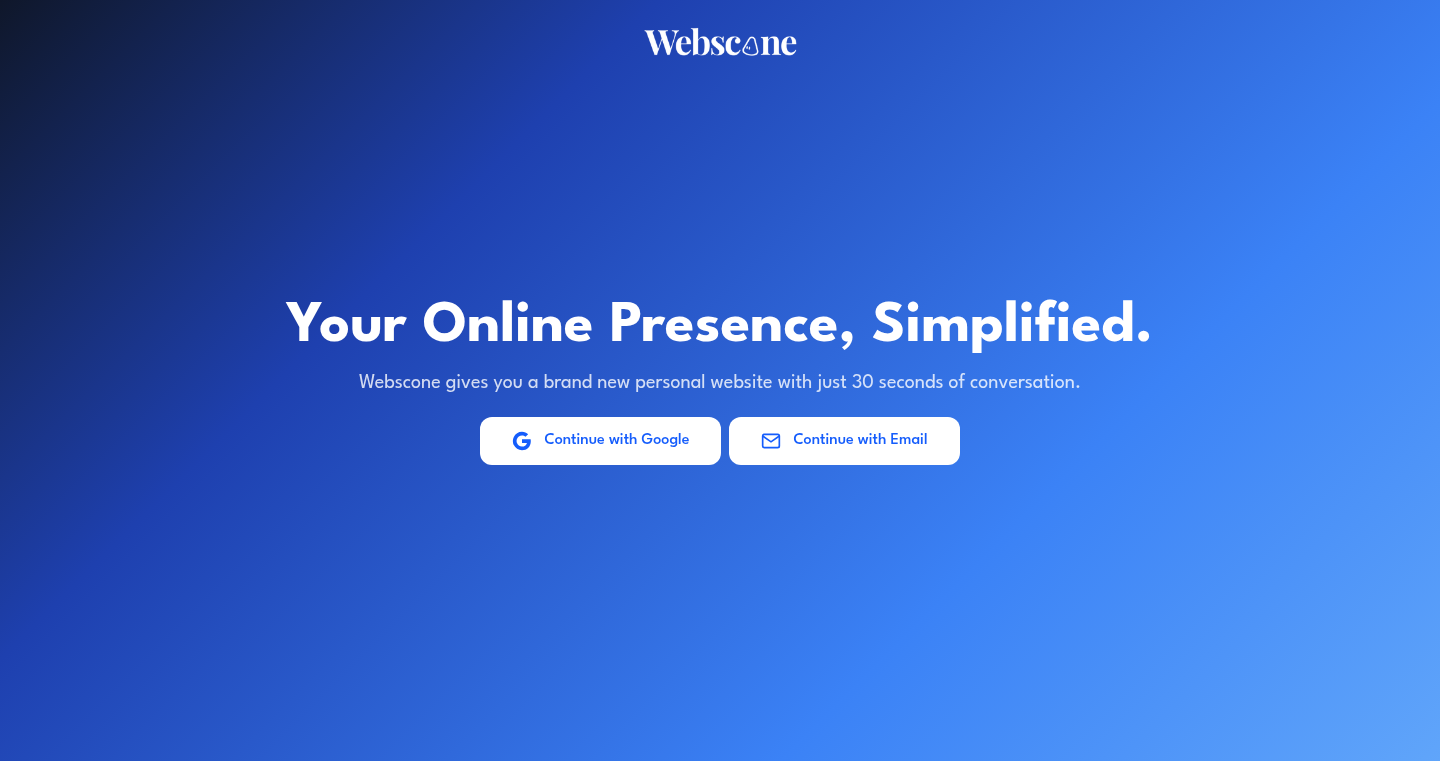
Author
ennisord
Description
This project is a website builder that's designed to be completely editable by Large Language Models (LLMs). It allows users to easily modify their entire website using natural language commands, making website management much more intuitive and less code-dependent. The core innovation lies in its tight integration with LLMs, simplifying website updates and content creation. So what's the benefit? It makes building and updating websites much easier, especially for those who aren't technical experts.
Popularity
Points 1
Comments 0
What is this product?
This website builder leverages LLMs to understand and execute commands related to website design and content. Imagine telling the website, "Change the heading to 'New Product Launch'" or "Add a bullet point describing the benefits of the product." The LLM processes these instructions and automatically updates the website's code and content. The core technology is how the site is structured and the APIs that link to the LLM, allowing direct manipulation of the website's underlying structure. This is a significant step towards no-code website management. So what's the benefit? It drastically simplifies website updates, making the process faster and accessible to everyone.
How to use it?
Developers can use this site builder by integrating the provided API (Application Programming Interface) or leveraging its core logic directly into their projects. For example, imagine creating a CMS (Content Management System) where content managers can make real-time changes to a website using natural language. Or building a dynamic landing page generator that updates itself based on keywords and user engagement. This simplifies development by decoupling the website's design and content from the underlying code, allowing for agile updates and personalized user experiences. So what's the benefit? It allows developers to create more user-friendly and dynamic website experiences, reducing the need for manual code modifications.
Product Core Function
· Natural Language Content Editing: Allows users to modify text and content on the website using everyday language commands. The value is simplifying the process of content updates, allowing non-technical users to manage their website content easily. For example, a marketing team can update product descriptions without needing to involve a developer.
· Dynamic Layout Adjustment: Allows the website builder to adjust the layout, such as position of elements, based on LLM commands. The value lies in creating highly responsive and flexible website designs, enabling websites to automatically adapt to different devices and user preferences. Consider automatically adjusting a mobile layout.
· Automated Content Generation: LLMs can generate new content, such as blog posts or product descriptions, directly within the website. The value is that this saves time and effort, especially when creating new content. You can generate a blog post from a simple prompt like "Write an article about the benefits of using AI in business."
Product Usage Case
· E-commerce Website Management: Automatically updating product descriptions, pricing, and promotional banners using natural language commands. This saves time and effort for e-commerce website managers, allowing them to focus on other aspects of their business. So what's the benefit? Quickly updating the site during sales seasons.
· Personalized Landing Pages: Creating landing pages tailored to specific user segments or campaigns, with the content dynamically generated or modified based on user interactions or campaign parameters. So what's the benefit? Improving user engagement and conversion rates through customized experiences.
· Content Management System (CMS) Integration: Enabling content creators to easily update website content through a conversational interface, reducing the need for technical skills and streamlining the content creation process. So what's the benefit? Allowing content creators to make instant changes without code.
56
MERN Stack SaaS Starter Kit: Turbocharge Your Web App Development
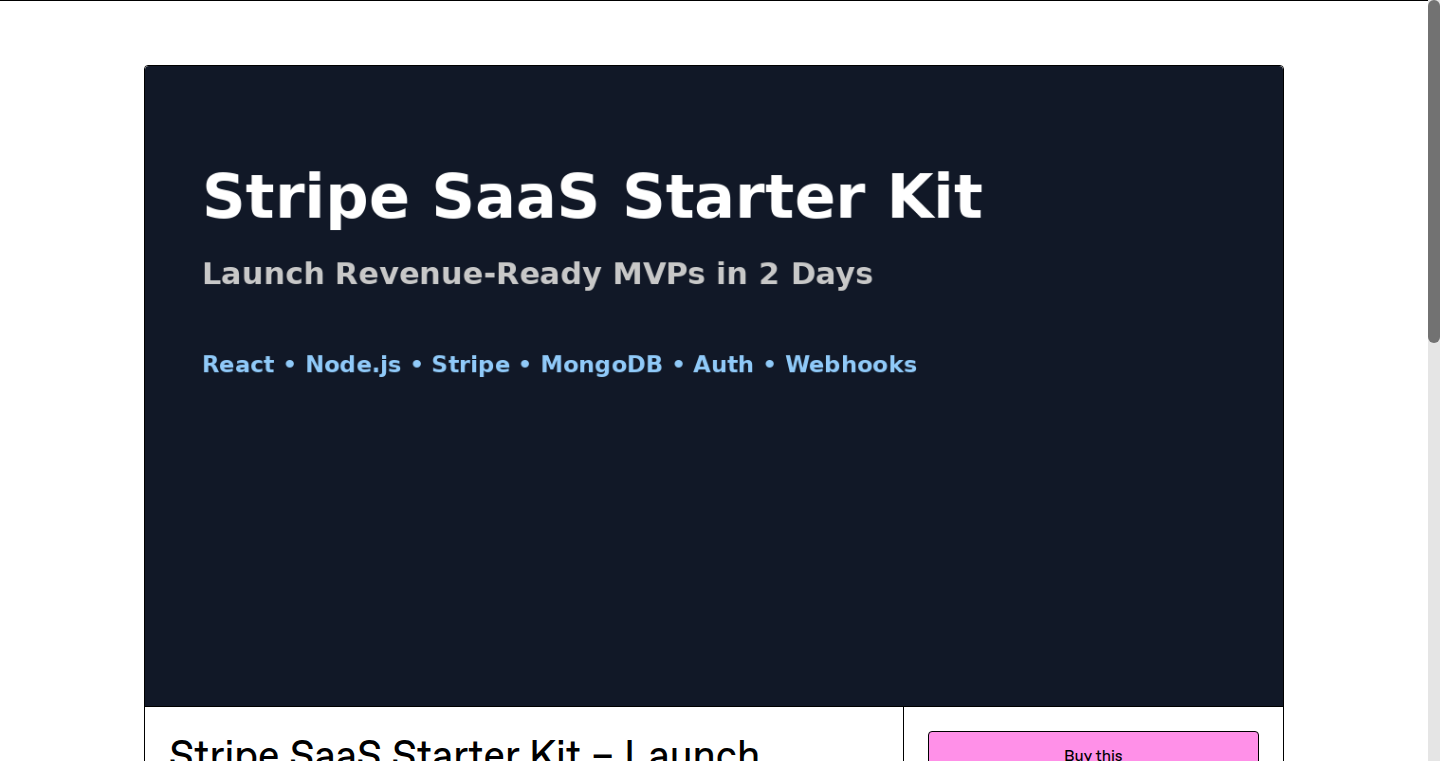
Author
falakthkr
Description
This project is a pre-built foundation for SaaS (Software as a Service) applications. It provides a ready-to-use setup with essential features like user authentication, payment processing via Stripe, and an administrative panel, all built on the MERN stack (MongoDB, Express.js, React, Node.js). The key innovation lies in significantly reducing the initial development effort by offering a complete, pre-configured solution for common SaaS requirements. So, it saves you time and money, letting you focus on your application's core features.
Popularity
Points 1
Comments 0
What is this product?
It's a template, or a starting point, for building web applications that offer services for a subscription or other payment models. It's built with the MERN stack, which means it uses MongoDB for storing data, Express.js to handle the server side, React for the user interface, and Node.js to run everything. The project integrates Stripe for processing payments and includes a built-in administrative panel for managing users and other application settings. This is innovative because it takes away the tedious tasks of setting up authentication, payment processing, and admin interfaces, letting developers focus on the unique features of their applications. So, you don't have to start from scratch.
How to use it?
Developers can clone or download this kit, and then customize it to fit their specific needs. They can add their own business logic, design their own user interfaces, and integrate it with their existing infrastructure. The key is the plug-and-play nature of pre-configured components like authentication and payment processing. You can integrate it by modifying the pre-built code, adding your features and business rules, and deploying it to a server. So, you can rapidly prototype and launch your ideas.
Product Core Function
· User Authentication: Provides a secure system for users to register, log in, and manage their accounts. This is crucial for any application where user data is sensitive or requires personalized access. So, you don't have to build this yourself.
· Payment Processing (Stripe Integration): Handles the complex process of accepting and processing payments using Stripe, a popular payment gateway. This allows developers to easily incorporate subscription models, one-time purchases, and other payment options. So, you can monetize your application quickly.
· Admin Panel: A user-friendly interface for managing users, subscriptions, and other critical application settings. This simplifies tasks like user management, monitoring app usage, and debugging issues. So, you can easily manage your application.
· MERN Stack Foundation: Built on a well-known and widely used technology stack (MongoDB, Express.js, React, Node.js). This enables developers familiar with these technologies to readily understand, customize, and extend the provided functionalities. So, you can use familiar tools and a large community.
Product Usage Case
· A developer wants to build a project management tool that allows users to pay for different features. They can use this starter kit, modify the UI to their liking, add features like task assignments and file sharing, and be able to launch their product in a fraction of the time. So, you can launch your SaaS faster.
· A startup wants to create a platform for online courses. By using this starter kit, they can add course content management, user progress tracking, and customize the look and feel. The integrated Stripe setup helps them to accept payments and create a paid subscription for access to premium content. So, you can validate your business model with less effort.
· An independent developer wants to build a web app to automate invoice generation for freelancers. They can use the kit to implement user authentication, billing and add their invoice features. The Stripe integration allows them to receive payments seamlessly. So, you can focus on your core features, not the basics.
57
Formo: Onchain Analytics Platform
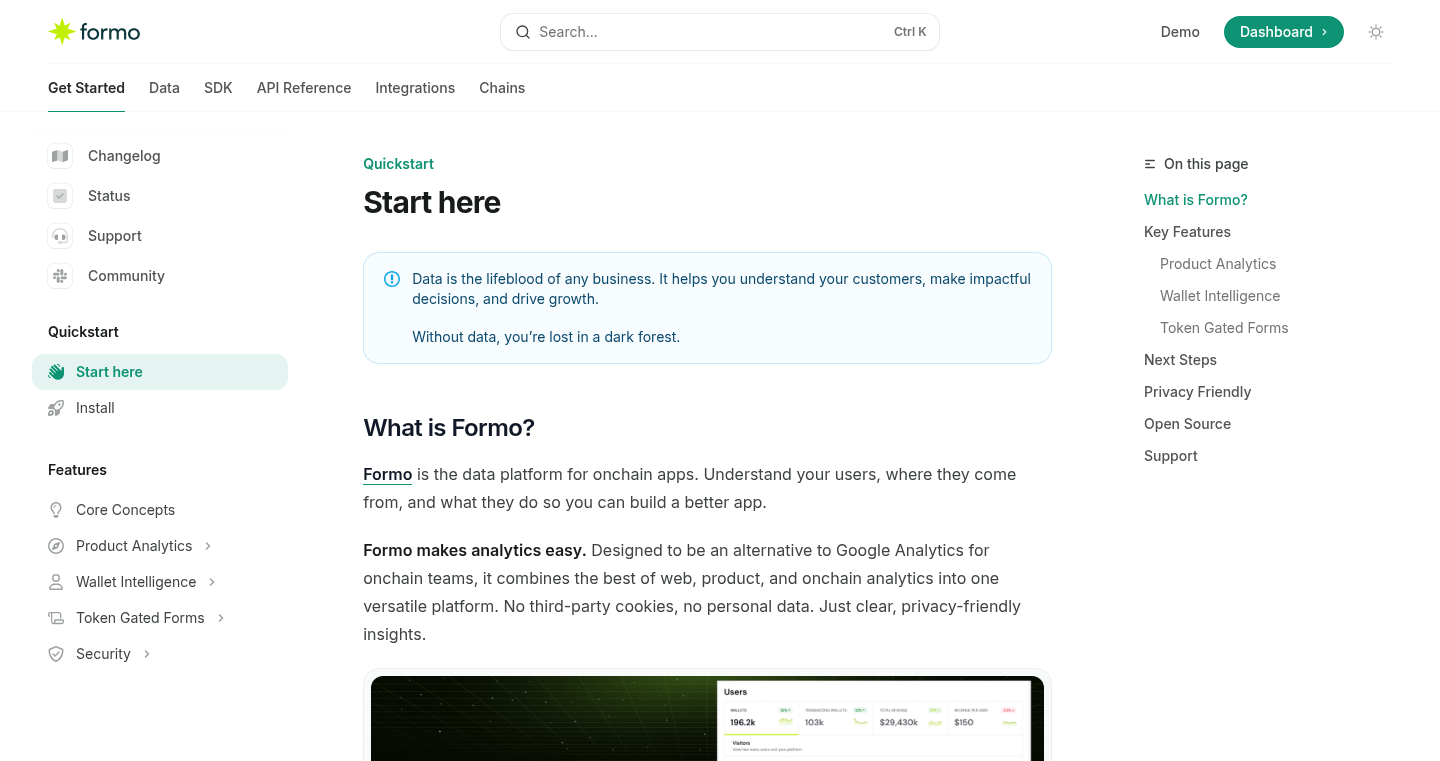
Author
leventhan
Description
Formo is a data platform designed specifically for applications built on blockchain. It tackles the challenge of understanding user behavior and activity within these decentralized systems, offering insights similar to Google Analytics but tailored for the unique characteristics of onchain interactions. It avoids third-party cookies and personal data, providing a privacy-focused approach to understanding user behavior, which is a significant advancement in the field of onchain analytics.
Popularity
Points 1
Comments 0
What is this product?
Formo is a platform that provides analytics for decentralized applications (dApps). It works by collecting and analyzing data from blockchain transactions and user interactions within your dApp. The innovation lies in its focus on onchain data, offering a privacy-friendly alternative to traditional web analytics. It provides insights into user journeys, popular features, and overall dApp performance, all while respecting user privacy. So this helps you understand your users better and improve your dApp.
How to use it?
Developers integrate Formo into their dApps by including a simple JavaScript snippet. Once integrated, Formo automatically tracks various user actions, such as transactions, feature usage, and time spent within the dApp. Developers can then access a dashboard to visualize these insights. This allows developers to track key metrics like user acquisition, retention, and engagement, and identify areas for improvement. So you can easily get user data and improve your dApp.
Product Core Function
· User Behavior Analysis: Tracks user interactions within the dApp, identifying popular features, and understanding user journeys. This helps developers optimize the user experience and improve engagement. For example, if many users are abandoning a specific feature, developers can investigate and fix it.
· Onchain Transaction Tracking: Monitors blockchain transactions related to the dApp, such as token transfers and smart contract interactions. This provides insights into the financial performance of the dApp and the usage of its core functionalities. For instance, you can see which features drive the most transactions and revenue.
· Cohort Analysis: Groups users based on their initial interaction with the dApp, allowing developers to track how different groups of users behave over time. This is useful for understanding user retention and identifying factors that lead to user churn. For example, you can analyze the behavior of users acquired through different marketing campaigns to see which ones perform best.
· Privacy-Focused Data Collection: Avoids the use of third-party cookies and personal data, ensuring user privacy while still providing valuable analytics. This promotes transparency and builds trust with users. For example, a dApp that values user privacy will benefit from using Formo.
Product Usage Case
· A decentralized exchange (DEX) uses Formo to track the volume of trades on different trading pairs. The DEX can then analyze which pairs are most popular and adjust its liquidity pools accordingly, improving the user experience and trading efficiency.
· A blockchain game uses Formo to monitor the number of players engaging with different game modes. The developers can then focus their resources on the most popular modes and make adjustments to those modes that may be struggling.
· A DeFi lending protocol employs Formo to understand how users are interacting with different loan products. The protocol can then use this data to optimize its interest rates, collateral requirements, and other parameters to better serve its users and maximize its profitability.
58
FeedFlow: Unified Bookmarks & Notes Stream
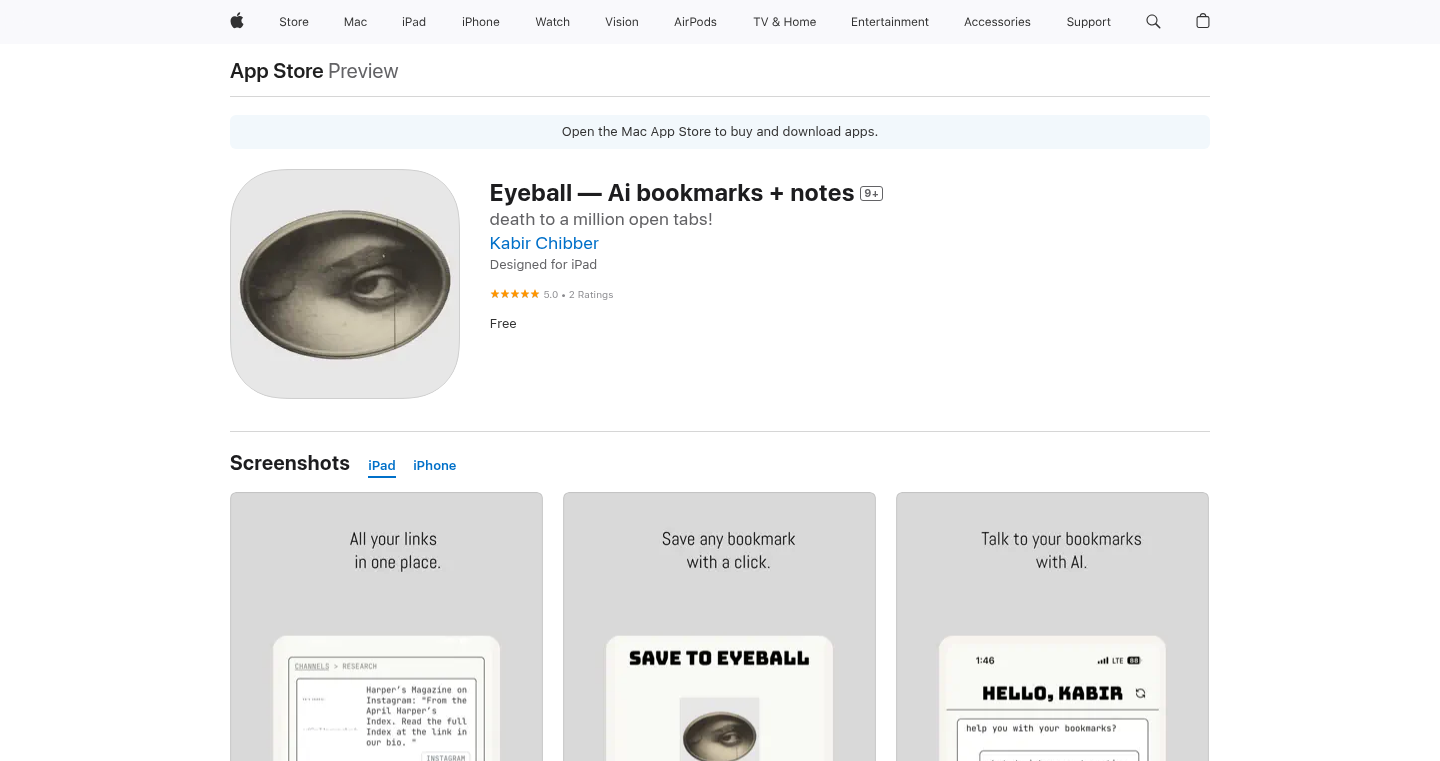
Author
quinto_quarto
Description
FeedFlow merges your bookmarks and notes into a single, chronological feed. This is a novel approach to personal knowledge management. Instead of keeping bookmarks and notes in separate silos, this project aims to combine them for a more holistic view of your research and thought process. It addresses the common problem of scattered information and the difficulty of connecting ideas across different tools. FeedFlow uses a lightweight backend, likely relying on a database and a simple algorithm to chronologically merge entries.
Popularity
Points 1
Comments 0
What is this product?
FeedFlow is a tool that brings your bookmarks and notes together in one place, displayed in the order you created them. Think of it like a timeline of your thoughts and the things you found interesting online. The innovative part is that it treats both bookmarks and notes equally, allowing you to see the connection between what you're reading and what you're thinking about. This tackles the issue of information overload by giving you a single place to review your digital life, rather than jumping between multiple apps. So, it simplifies how you keep track of everything online.
How to use it?
Developers could use FeedFlow as a foundation for their own note-taking or research tools. They could integrate it into existing applications or build browser extensions that automatically capture and organize bookmarks and notes. For instance, a developer working on a personal knowledge management (PKM) system could adopt FeedFlow's unified feed concept, allowing their users to create notes directly alongside bookmarked articles within the same interface. This could be easily integrated via APIs or custom integrations. You'd input your bookmarks and notes, and FeedFlow would organize them chronologically for you, like a personalized news feed of your research. So, you'd be getting a system that integrates your research and note-taking.
Product Core Function
· Unified Feed: The core function is to create a single, chronological feed by merging bookmarks and notes. This provides a unified view of your research and thinking. So, you can understand how your thoughts evolve along with your online discoveries.
· Data Input: The project likely allows for data input, whether manually entered notes or automated imports of bookmarks from various sources. So, you can easily add your information.
· Chronological Ordering: The system orders entries based on the time they were created or added. This helps to visualize the evolution of thought. So, you can see the progression of your research over time.
Product Usage Case
· Personal Research: A researcher can use FeedFlow to organize articles read, and notes about those articles, into a single timeline, allowing them to quickly review their work and see connections between different sources. So, it aids research productivity.
· Idea Generation: A writer or creative professional can use FeedFlow to capture inspirations (bookmarks) alongside their thoughts and ideas (notes) in a unified view, boosting idea generation. So, it aids creative work.
· Project Tracking: Project managers could use FeedFlow to keep track of both relevant links and notes, providing a central hub to review all project-related information. So, it improves information management.
59
RustMail: A Disposable Email Solution
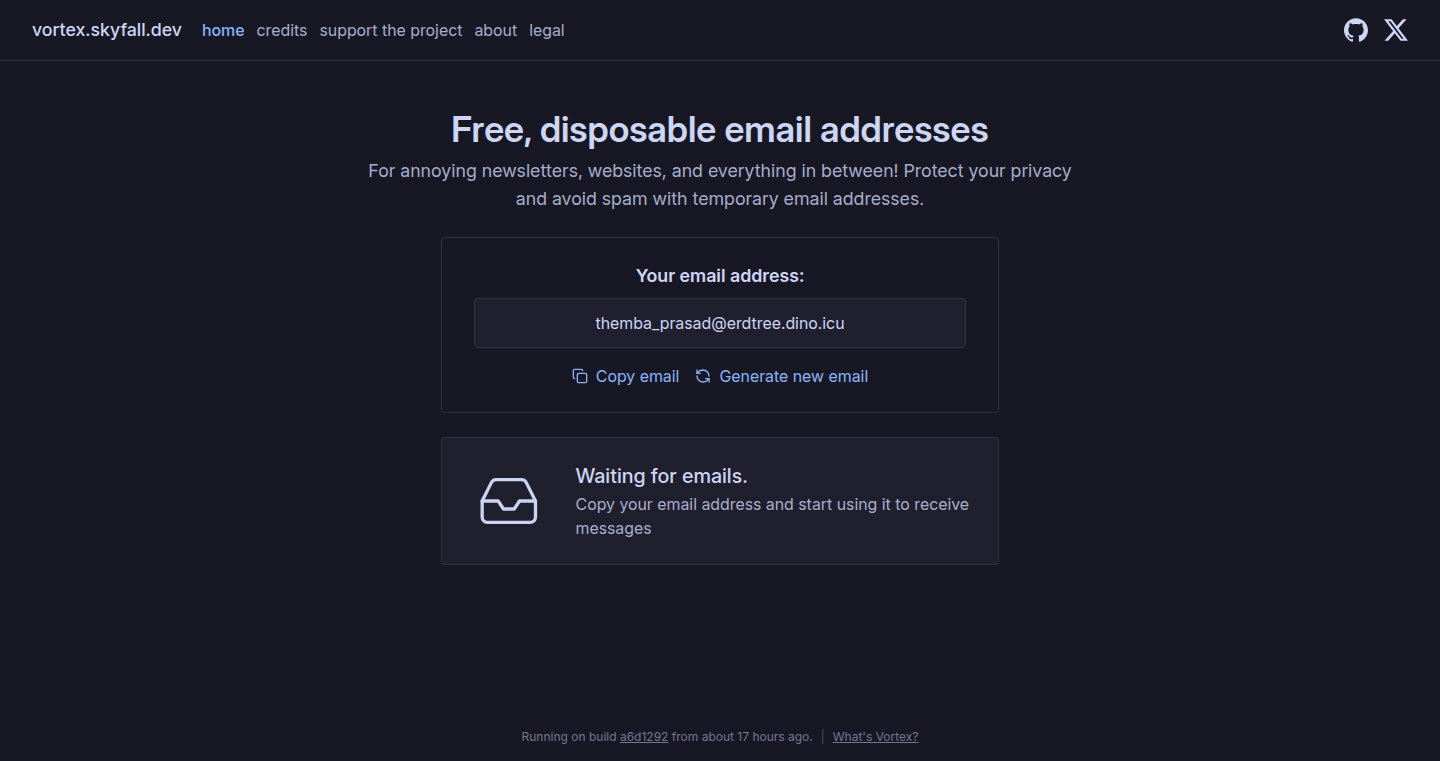
Author
JustSkyfall
Description
RustMail is a disposable email service built using the Rust programming language. It allows users to generate temporary email addresses for receiving emails without revealing their primary email. The core innovation lies in its use of Rust, known for its performance and security, to build a fast and robust email handling system. It solves the problem of email address clutter and potential spam by providing temporary, disposable email addresses.
Popularity
Points 1
Comments 0
What is this product?
RustMail is essentially a throwaway email service. When you sign up, you get a temporary email address. Any emails sent to that address are stored for a limited time and can be viewed through a web interface. It is built with Rust, a modern programming language known for its speed, memory safety, and reliability. This means it's designed to be fast, secure, and efficient at handling a large volume of emails, offering a robust alternative to traditional email providers for disposable use. So, what does that mean for you? It gives you a safe way to sign up for services, avoiding spam and protecting your main email account.
How to use it?
Developers can integrate RustMail's API into their projects to offer disposable email functionality within their own applications. This could be useful for testing email-sending features, verifying user accounts, or creating services that require temporary email addresses. Technically, this involves using API endpoints provided by RustMail to generate and manage email addresses, fetch emails, and potentially configure custom rules. So, you, as a developer, can easily protect user privacy by providing a disposable email solution, enhancing trust and security within your application.
Product Core Function
· Disposable Email Address Generation: The core function of RustMail is to create temporary email addresses. This functionality provides a way for users to generate new email addresses on demand, without any registration or long-term commitment. Technical value: It enables users to protect their primary email address from spam and data breaches. Application scenario: Signing up for newsletters or testing new online services.
· Email Receiving and Storage: RustMail receives emails sent to the generated temporary addresses and stores them securely for a limited period. Technical value: It provides a secure and private way to view emails received at the disposable address. Application scenario: Receiving verification codes, one-time passwords, or promotional emails without revealing your primary email.
· Web Interface for Email Viewing: RustMail typically offers a web interface or API that allows users to view the contents of emails received at their temporary addresses. Technical value: Provides a user-friendly method to access and manage disposable email inboxes. Application scenario: Checking the content of emails without logging into a separate email client or exposing your identity.
· Email Address Destruction: After a certain time or when the user chooses, the temporary email address and all associated data are deleted. Technical value: This enforces the disposable nature of the service, ensuring no long-term storage of user data. Application scenario: Guaranteeing privacy and preventing the accumulation of unwanted emails.
Product Usage Case
· Software Testing: A software developer is testing an email sending feature in their application. They can use RustMail to generate a disposable email address, send test emails, and verify that the email sending process works correctly without exposing their main email or dealing with spam. So, it helps to test your application's email features in a safe and isolated environment.
· User Verification: A website requires users to verify their email address. The website can provide users with a temporary email address using RustMail to receive the verification email. Users can then verify their accounts without needing to give out their real email address. So, it makes user registration safer and protects their primary email address from potential phishing.
· API Integration: A developer creates a service that requires an email address for account creation. The developer integrates RustMail's API to allow users to create accounts with disposable email addresses. So, it simplifies the process and reduces the risk of users signing up using fake or spam email addresses.
60
NameMatch: Instant Business Name, Domain, and Social Handle Validator
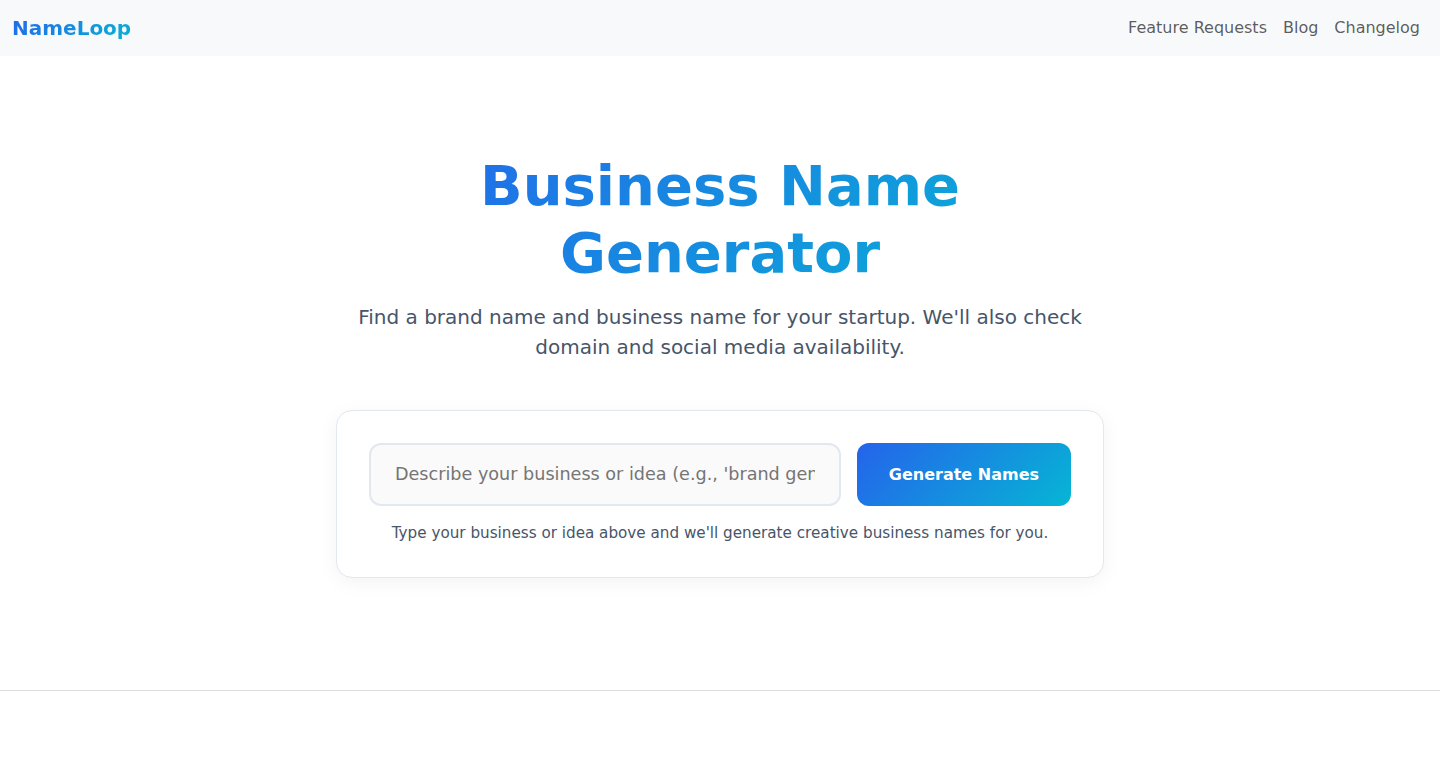
Author
maccubs17
Description
NameMatch is a tool designed to quickly generate and validate business names, checking for available domain names and social media handles simultaneously. The innovation lies in its real-time search and verification capabilities, streamlining the often tedious process of brand name selection. It solves the problem of wasting time on names that are already taken, helping entrepreneurs to quickly identify viable options and save significant time in the business planning phase.
Popularity
Points 1
Comments 0
What is this product?
NameMatch is like a name-finding assistant for your business. It combines name generation with immediate checks on domain name and social media handle availability. Instead of manually checking each name, the tool automatically checks across multiple platforms. The core technology behind this is likely a combination of name generation algorithms, API integrations with domain registrars (like GoDaddy) and social media platforms (like Twitter, Instagram), and real-time data fetching. This automated process provides instant feedback on whether a potential business name is available across essential online platforms.
How to use it?
Developers can use NameMatch as a starting point for building their own branding tools or integrating name validation into their business applications. It can be used through a web interface (if there's one) or potentially through an API, allowing developers to integrate the name checking functionality directly into their own projects. For example, you could integrate it into a startup idea generator or a business plan creation tool. So you can avoid manual checks and save time.
Product Core Function
· Name Generation: The ability to brainstorm and generate business name suggestions, often based on keywords or industry. Value: Provides a starting point for brand ideation. Application: Quickly identify potential names you might not have considered.
· Domain Availability Checks: Real-time verification of domain name availability (.com, .net, etc.). Value: Ensures the selected name can be secured online. Application: Avoids the disappointment of falling in love with a name only to find the domain is taken.
· Social Handle Validation: Checking for the availability of usernames on various social media platforms (Twitter, Instagram, Facebook, etc.). Value: Ensures a consistent brand presence across social media channels. Application: Enables easy brand consistency and online discoverability.
Product Usage Case
· Startup Founders: Quickly identify available names, domain, and social handles for their new businesses. Solves the problem of manually checking availability across multiple platforms.
· Marketing Agencies: Provide clients with brand name options and instant validation reports. Solves the need for rapid brand analysis and presentation of viable options.
· Developers of Business Tools: Integrate name and handle validation into their business plan software or startup idea generators. Solves the need for comprehensive brand name research within other tools.
61
AI-Powered StyleForge: Your Personal Fashion Design Lab

Author
dayaya
Description
AI-Powered StyleForge leverages the power of Generative Adversarial Networks (GANs) and diffusion models to create realistic fashion model images and outfit designs from text prompts. It allows users to generate diverse fashion concepts, experiment with different styles, and visualize designs without traditional photoshoots or complex 3D modeling, solving the costly and time-consuming challenges of fashion prototyping.
Popularity
Points 1
Comments 0
What is this product?
StyleForge is essentially a digital fashion design studio powered by artificial intelligence. At its core, it uses advanced AI models called GANs and diffusion models. Think of GANs as two AI entities: one trying to create realistic images, and the other trying to tell if they're real. Diffusion models refine the image generation process, leading to higher quality and more versatile outputs. You input text descriptions like 'a cyberpunk jacket' or 'a summer dress on the beach', and the AI generates corresponding images. This innovation lies in automating and democratizing fashion design, making it accessible to anyone with an idea.
How to use it?
Developers can integrate StyleForge into their fashion design workflows via an API or by directly using the command-line tools. Imagine a fashion startup that needs to quickly visualize different design variations for customer feedback, or a clothing brand that wants to generate marketing materials for new collections. You can upload the output to e-commerce platforms, use them as a reference for physical prototyping, or even create virtual try-on experiences. So, you can quickly iterate designs, reduce the time and cost spent on traditional photoshoots, and generate endless design possibilities.
Product Core Function
· Text-to-Image Generation: The core function, taking text descriptions as input and generating realistic fashion model images and outfit designs. This means you can turn ideas into visuals instantly.
· Style and Aesthetic Customization: Users can specify styles, aesthetics, and even reference existing fashion trends in their prompts, allowing for tailored design iterations. This allows you to refine the design to precisely match your vision.
· Outfit Combination and Exploration: It provides a sandbox for experimenting with different clothing combinations and styles, eliminating the time and resources required for physical prototyping. So, you can try out wild fashion combinations without needing to buy anything.
· Image Resolution and Quality: The system supports different image resolutions to adapt to various use cases from basic concepts to high-resolution marketing materials. This allows you to use the images for different purposes, from quick sketches to high-quality product photos.
Product Usage Case
· E-commerce Product Visualizations: A fashion retailer can use StyleForge to create product images without the need for physical models and photoshoots. They input descriptions of clothing items and generate realistic images for their online store. So, the retailer can save time and money on photography while providing customers with a good visual representation of the product.
· Virtual Try-On Integration: Developers can integrate StyleForge's output into virtual try-on applications, allowing users to visualize how clothes would look on them. So, shoppers can see how clothes fit before they make a purchase, boosting customer experience and conversion rates.
· Design Concept Prototyping: Fashion designers can use StyleForge to rapidly iterate through design ideas, experimenting with colors, patterns, and styles without the time and cost of creating physical samples. So, designers can quickly prototype many ideas and optimize for customer feedback.
· Marketing and Social Media Content: Brands can use the generated images to create marketing materials, social media posts, and even virtual fashion shows. So, this allows companies to create engaging and unique content without the traditional production costs.
62
KanbanAgent: GitHub-Integrated Software Engineering Agent Manager
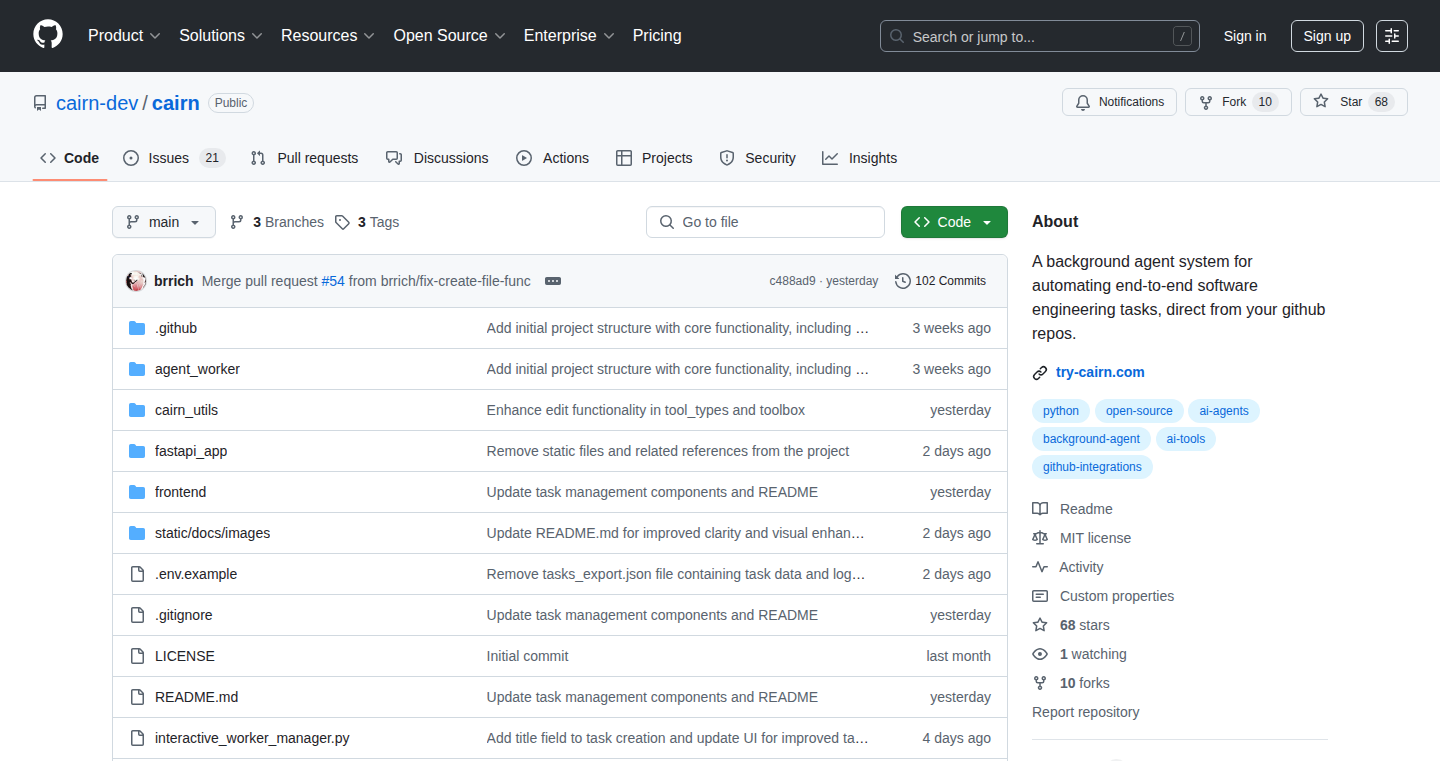
Author
brich4419
Description
KanbanAgent is an open-source project that allows developers to manage their background software engineering agents (think automated code helpers or testing tools) using a Kanban board interface. The core innovation lies in integrating these agents with GitHub, providing a streamlined way to deploy, monitor, and manage background processes directly linked to your code repository. This solves the common problem of managing and orchestrating background tasks in a distributed development environment, allowing for improved efficiency and reduced manual intervention in software development workflows.
Popularity
Points 1
Comments 0
What is this product?
KanbanAgent is essentially a control panel for your software 'assistants'. It lets you define and run programs that work behind the scenes, helping with tasks like code analysis, automated testing, or even generating documentation. The cool part is it connects directly to your GitHub repository. When you push code, certain agents can be triggered automatically. The Kanban board provides a visual way to track the status of these agents (e.g., 'In Progress', 'Completed', 'Failed'), making it easier to see what's happening and quickly address any issues. So it's like having a team of helpful bots working on your code automatically. So this means you don't have to manually run those tedious tasks; KanbanAgent automates them, freeing up your time for more important things.
How to use it?
Developers can use KanbanAgent by first connecting it to their GitHub repository. Then, they define agents, which are essentially scripts or programs, and configure them to perform specific tasks (e.g., run linters, perform security checks, or deploy code). The Kanban board is used to visualize the agent's status and manage its lifecycle. To use it, simply set up agents, configure their triggers based on your code changes, and monitor their progress on the Kanban board. So, use it in any project that involves automation and background tasks, especially on projects with CI/CD pipelines, or even simpler projects to automate the build process.
Product Core Function
· GitHub Integration: KanbanAgent connects directly to your GitHub repository, triggering agents based on code changes, pull requests, or other events. This provides a seamless way to automate tasks in your development workflow. This is useful because it enables automation directly linked to your code's life cycle.
· Kanban Board Management: The Kanban board interface visualizes the status of each agent, allowing developers to monitor progress, identify failures, and easily manage their tasks. This provides a clear overview of the background processes, making it easy to find and address any issues in your automated workflow. For example, if a testing agent finds an issue, you will know instantly.
· Agent Deployment and Management: The system allows you to deploy and manage background software engineering agents, enabling automated execution of tasks like linting, testing, or code analysis. This streamlines the development process and improves code quality and efficiency. It automatically executes tasks that are often manually performed, saving time and increasing productivity.
· Open Source and Extensible: Being open source allows for community contributions, enabling developers to customize the system, create new agents, and integrate with other tools. It's a flexible system, able to adapt to specific project needs, enabling developers to build their own custom functionalities.
Product Usage Case
· Automated Code Linting: Configure an agent to automatically run a linter (like ESLint or Flake8) every time a pull request is created. The agent checks the code for style issues and reports any errors directly on the pull request. This improves code quality and helps maintain consistency across the codebase. So this helps maintain consistent code standards across a team.
· Automated Testing: Set up agents to run unit tests and integration tests automatically whenever new code is pushed to the repository. If the tests fail, the agent can notify the developers, preventing broken code from being merged. This significantly reduces the risk of releasing faulty code. This immediately catches errors during development.
· Continuous Integration/Continuous Deployment (CI/CD): Integrate KanbanAgent with your CI/CD pipeline to automate deployment processes. Whenever the tests pass, the agent can automatically deploy the code to the staging or production environment. So this simplifies and automates deployment, saving time.
· Documentation Generation: Configure an agent to automatically generate or update code documentation every time the code changes, which then can be deployed along with the code. So the project's documentation is always up-to-date.
63
Escape Rope - Self-hosted Job Search Aggregator
Author
chaosharmonic
Description
Escape Rope is a self-hosted application designed to streamline job searching. It aggregates job postings from various sources, eliminates duplicates, and provides a user-friendly interface for filtering and tracking applications. The core innovation lies in its ability to efficiently gather and manage job search results, offering features like duplicate detection and a "swiping" interface to quickly sort through listings. This project embodies the hacker spirit by automating a tedious process and making job hunting more manageable.
Popularity
Points 1
Comments 0
What is this product?
Escape Rope is like a personal job search assistant. It works by gathering job postings from different websites (using "crawlers" to automatically collect data) and then organizing them in one place. It also has built-in features to prevent you from seeing the same job multiple times. Think of it as a smart aggregator that helps you avoid the hassle of repetitive job searches and scattered application tracking. The project uses a backend API for storing and managing job results, with duplicate detection during crawling and upload. The frontend provides a user interface to "swipe" through job listings, filter, and track progress. So, you can focus on applying for jobs instead of wasting time.
How to use it?
Developers can use Escape Rope by self-hosting the application and configuring it to gather job postings from their preferred sources. This can involve setting up the crawlers to extract data from various job boards and company websites. The application provides an API for storing and retrieving job data, which can be integrated with other tools or services. You can use the frontend to browse the collected job postings, apply filters, and track your application process. Escape Rope is designed to be easily deployed, allowing developers to customize it to their specific needs and adapt it to the job boards they use. So, if you are a developer, you can use it to automate your job search and track your applications in an efficient way.
Product Core Function
· Job Crawling: Automatically gathers job postings from multiple sources. This saves you time and effort from manually searching different websites. The technology here is web scraping, but it’s done in a way to make sure it’s efficient and doesn’t overwhelm the websites. So it saves you time by doing the work for you.
· Duplicate Detection: Identifies and removes duplicate job postings. This prevents you from seeing the same job multiple times, reducing wasted time and improving focus. This is done by comparing job descriptions, titles, and companies. So it gives you a cleaner and more focused job search.
· Data Aggregation: Consolidates job postings from various sources into a single, unified view. This gives you a complete overview of all available opportunities, simplifying your job search process. This involves using a backend API to store the job information and present it to you in a simple way. So, you can have all your job postings in one easy-to-manage place.
· Filtering and Sorting: Enables you to filter job postings based on your criteria. This allows you to quickly identify and focus on the most relevant jobs. It also provides a "swiping" mechanism for quickly sorting through results. So, you can find the jobs that match your skills and experience faster.
· Application Tracking: Provides basic tools to track your application progress. This helps you stay organized and monitor the status of each application. This keeps track of what you apply to. So you can easily manage your job applications.
Product Usage Case
· Automated Job Search: A developer can set up crawlers to automatically collect job postings from several websites, and then review the postings in a single interface. The duplicate detection feature makes it faster and less frustrating. So you can stop manually checking multiple websites daily.
· Personalized Job Tracking: By using Escape Rope, a user can keep track of the jobs they've applied for, their interview status, and any related notes. This helps to organize applications and remember the important details of each job. So you can keep track of all your applications and know exactly where you stand.
· Customized Job Feed: A developer could extend Escape Rope with custom crawlers tailored to specific job boards or company websites. This creates a highly targeted and personalized job feed. So you can be sure you are seeing the jobs that are most relevant to you.
64
PromptDC: The AI Prompt Optimizer
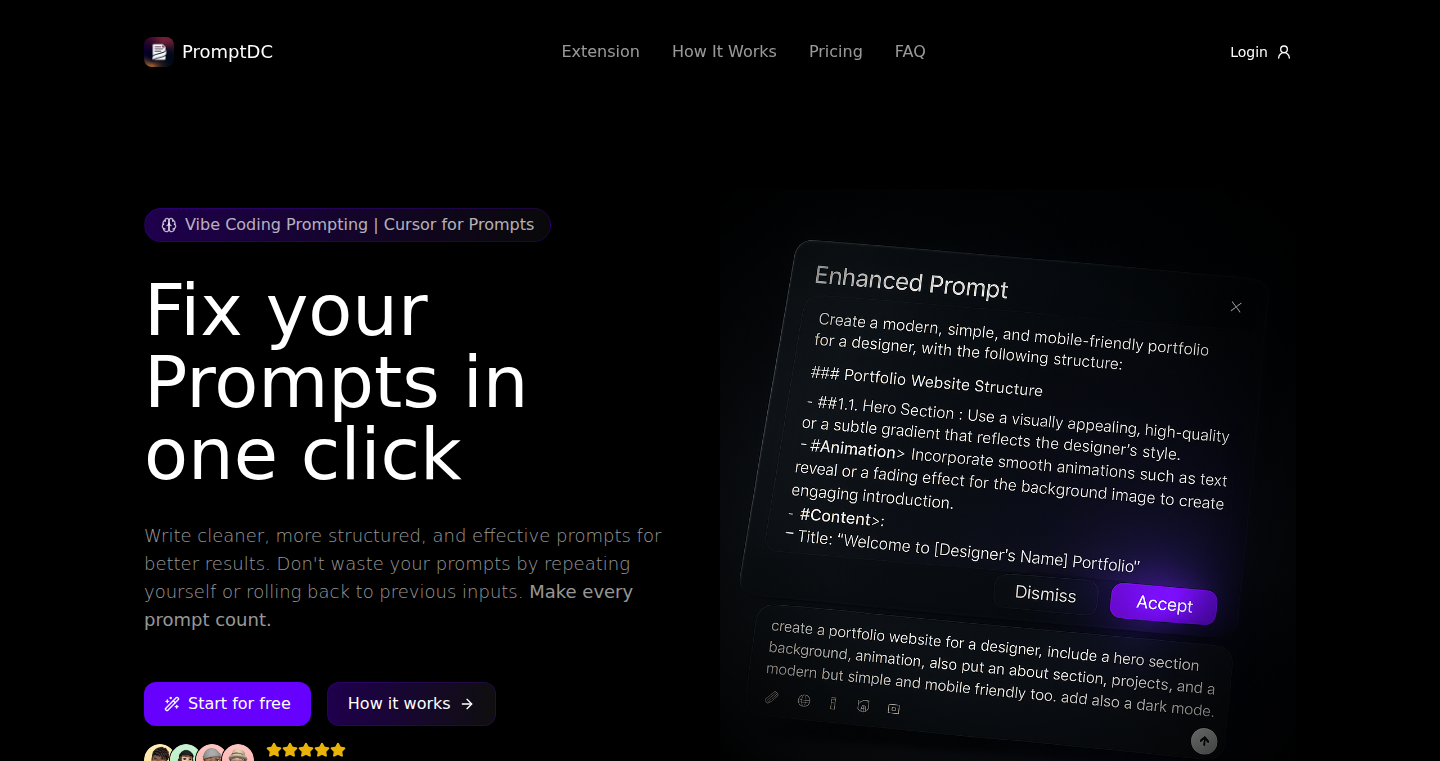
Author
pvisilias
Description
PromptDC is a browser extension and VS Code extension that enhances your prompts for AI models with a single click. It addresses the core problem of unclear or typo-ridden prompts, which often lead to AI models misunderstanding user instructions. By optimizing prompts, PromptDC helps developers get more accurate and useful outputs from AI, leading to faster and more efficient development. It helps you solve the real problem of bad prompts.
Popularity
Points 1
Comments 0
What is this product?
PromptDC works by analyzing your prompt and automatically improving its clarity and structure. It's like having a prompt editor built directly into your coding environment or browser. When you type a prompt, you can trigger PromptDC with a keyboard shortcut or a button click. The extension then intelligently refines the prompt, making it easier for AI models to understand your requests and generate the desired code or responses. So this helps in getting the right output from AI, quickly.
How to use it?
Developers can use PromptDC in various web-based platforms or directly within their local editor (VS Code extension). Simply write your prompt, press a key (or click a button), and watch PromptDC improve it. This means developers can refine their prompts in their existing workflow without switching tools or disrupting their coding process. For example, you can use PromptDC within your favorite AI-powered coding assistant or in a chat interface. So this allows you to use AI more efficiently.
Product Core Function
· Prompt Enhancement: The core function is to refine user-written prompts to improve clarity, structure, and specificity. This translates to more accurate and relevant outputs from the AI. Use case: Developers can write a vague prompt for a specific feature, and PromptDC can refine it to a more actionable and understandable instruction for the AI, saving time and effort in debugging and iterations. So this improves the quality of the AI results.
· Seamless Integration: The extension integrates directly into web-based platforms and VS Code, allowing users to optimize prompts without leaving their existing coding environment. Use case: When working on a new project with an AI assistant, developers can seamlessly use PromptDC to improve prompts within the IDE, providing a streamlined experience, and keeping them focused on the core development tasks. So this boosts productivity.
· One-Click Optimization: Users can enhance prompts with a single click or a keyboard shortcut. Use case: When experimenting with different code generation methods, a developer can rapidly iterate on prompts. With PromptDC, the prompt optimization becomes quick and effortless, enhancing the feedback loop for experimentation. So this makes the process easier to use.
Product Usage Case
· Scenario: A developer is using an AI code generator to create a function that sorts a list of numbers, but the AI's initial output is incorrect. The developer uses PromptDC to refine the original prompt by specifying the data type and the sorting order (e.g., 'Sort a list of integers in ascending order'). The refined prompt helps the AI understand the requirements more clearly, resulting in an accurate and efficient sorting function. So this provides the correct code generation.
· Scenario: A developer is building a web application and wants to add a specific feature to the UI. The developer uses an AI assistant to help write the code but struggles to get the assistant to understand the requirements correctly. Using PromptDC, the developer refines the prompt describing the feature and its expected behavior, such as 'Create a responsive button that triggers an alert when clicked.' The AI is able to generate better and more accurate code for the specific UI element. So this lets you build the UI faster.
· Scenario: A developer is creating a REST API and uses an AI assistant to generate documentation for their endpoints. The initial prompts for generating the documentation were vague, resulting in incomplete or inaccurate documentation. The developer uses PromptDC to improve the clarity and precision of the prompts, specifying the request methods, parameters, and response formats for each endpoint. The refined prompts lead to the creation of comprehensive, accurate, and easy-to-understand API documentation. So this gets accurate documentation from the AI.
65
App Ads Manager: Mobile-First Apple Search Ads Management
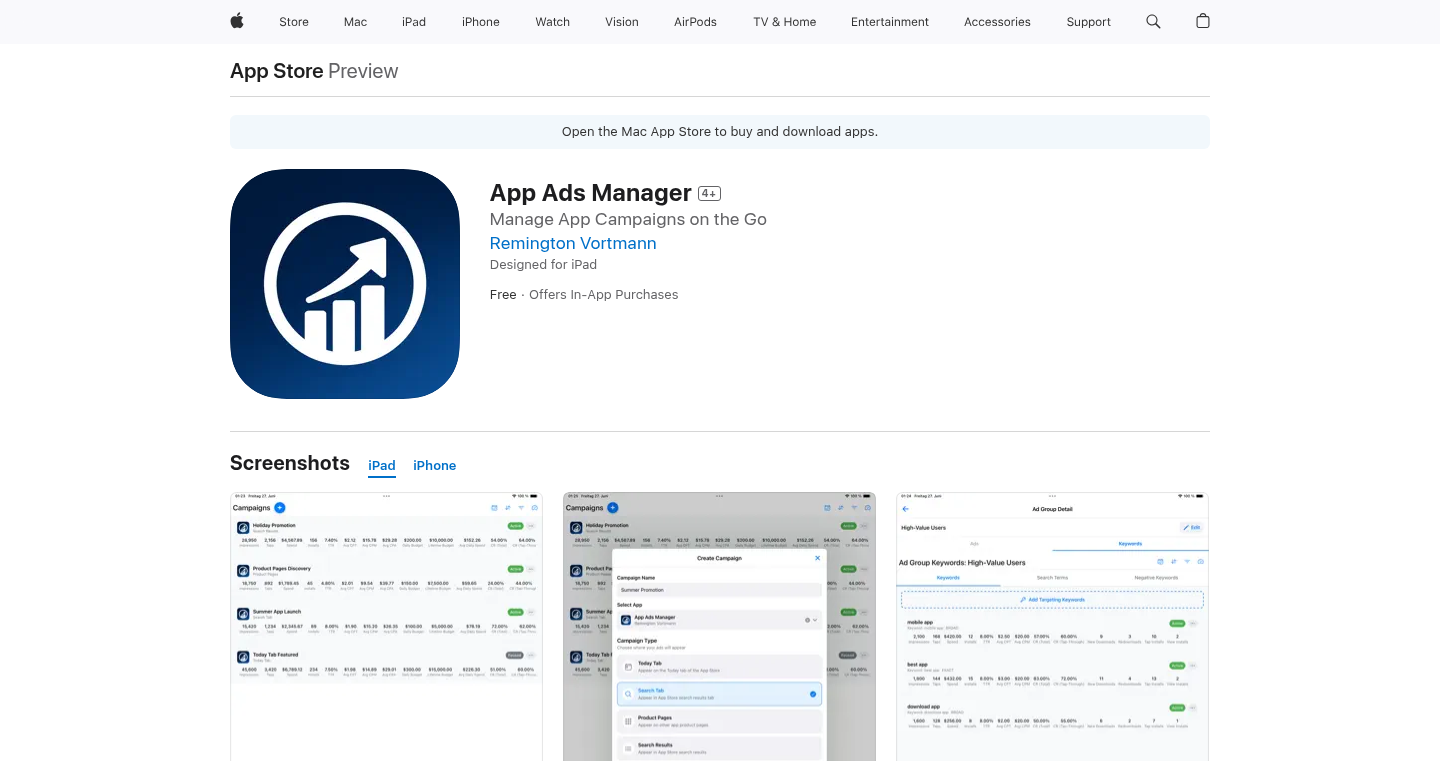
Author
notgnimer
Description
App Ads Manager is a mobile application for iOS devices that allows developers and marketers to fully manage their Apple Search Ads campaigns directly from their iPhone or iPad. The core innovation lies in bringing the complex Apple Search Ads platform to a mobile-friendly interface, solving the problem of slow and cumbersome web-based management, particularly on mobile devices. This app utilizes the official Apple Search Ads API for secure data access and provides features like campaign creation/editing, budget/bid adjustments, keyword management, and performance tracking, all optimized for a mobile experience. So, it allows users to control their advertising spend and optimize campaigns on the go.
Popularity
Points 1
Comments 0
What is this product?
App Ads Manager is essentially a mobile dashboard for Apple Search Ads. It works by connecting to your Apple Search Ads account using the official API (Application Programming Interface), which is like a secure bridge to your advertising data. The app then presents this data and allows you to modify your campaigns in a user-friendly way on your phone. The innovation is in re-imagining a complex web-based platform for a mobile interface, solving the problem of accessing and controlling your advertising campaigns when away from a computer. So, it simplifies the process of managing your app promotion efforts.
How to use it?
Developers use App Ads Manager by downloading the app on their iPhone or iPad and connecting their Apple Search Ads account. After connecting, they can create new campaigns, adjust their budgets and bids, add or remove keywords, and monitor the performance of their ads. They can also track metrics like impressions, taps, installs, and spend. The app supports advanced targeting options and bulk editing. Think of it like having your advertising control panel in your pocket, allowing you to make quick decisions and adjustments to improve your campaign's effectiveness. So, it allows you to react to market changes in real-time, even when you're not at your desk.
Product Core Function
· Campaign Creation and Editing: Allows users to create and modify Apple Search Ads campaigns directly from their mobile devices, including Today Tab, Search Tab, Product Pages, and Search Results campaigns. This streamlines the campaign setup process and provides flexibility in targeting and ad content. So, it makes it easy to launch new advertising initiatives or adapt existing ones from anywhere.
· Budget and Bid Adjustment: Users can adjust campaign budgets and bids on the go, optimizing ad spend in response to performance data or market changes. This ensures the best possible return on investment and prevents wasted spending. So, it helps in better managing the advertising budget.
· Keyword Management: App Ads Manager enables users to edit keywords (including negative keywords) to fine-tune ad targeting and improve ad relevance. This helps to reach the most relevant audience. So, it improves the accuracy and efficiency of ad targeting.
· Performance Tracking: Provides access to key campaign metrics, such as impressions, taps, installs, and spend, and allows users to filter and analyze this data. This enables data-driven decision-making and performance optimization. So, it allows you to see how your ads are performing and make informed decisions.
· Advanced Targeting: Supports advanced targeting options like location, age, gender, and device type, enabling precise audience segmentation for more effective advertising. This helps in reaching the right people. So, it allows you to target your ads towards the perfect audience.
Product Usage Case
· On-the-Go Campaign Monitoring: A developer notices a sudden drop in install rates for their app while they're traveling. Using App Ads Manager, they can quickly check the campaign performance, identify underperforming keywords, and adjust bids to improve visibility and conversion rates. So, it allows you to solve advertising problems quickly and keep the install rate steady.
· Real-Time Budget Optimization: A marketing manager wants to take advantage of a trending keyword. They use App Ads Manager to quickly increase bids for relevant keywords and capitalize on the increased search volume. So, it allows you to react to market opportunities efficiently and get more customers.
· Quick Negative Keyword Implementation: A developer realizes that their ads are appearing for irrelevant search terms. They use App Ads Manager to instantly add negative keywords to prevent wasted ad spend and improve ad relevance. So, it helps prevent the money from being wasted in wrong ad displays.
· Performance Trend Analysis: A marketing team uses App Ads Manager to track performance data, like install rates, and compare it to the overall advertising strategy. So, it allows the team to monitor the results and refine the marketing strategy, to make sure all the efforts pay off.
66
Lunova: QuickBooks Event-Driven Alerting

Author
chidog12
Description
Lunova is a system that lets you set up custom SMS and email alerts based on events happening in your QuickBooks accounting software. It focuses on a critical aspect: providing real-time notification for important financial activities, like invoice payments, new bills, or balance sheet changes. The core innovation lies in its event-driven architecture, reacting directly to QuickBooks data changes, without the need for constant polling. This simplifies the monitoring process and offers instant updates.
Popularity
Points 1
Comments 0
What is this product?
Lunova is like a smart assistant for your QuickBooks. It listens for specific things to happen within your accounting data, such as an invoice being paid, a new expense being recorded, or a critical balance being adjusted. When one of these events triggers, Lunova instantly sends you an alert via SMS or email. The innovation here is its real-time, event-driven approach. Instead of checking QuickBooks constantly (like a persistent query), Lunova reacts directly to changes as they occur. This saves time and resources, and more importantly, keeps you informed the instant something important happens. So this project provides faster response to your important business financial changes.
How to use it?
Developers can integrate Lunova into their workflow by setting up triggers (events) based on specific QuickBooks actions. You define what events you want to monitor (e.g., invoice payments, overdue bills, etc.) and how you want to be notified (SMS or email). The system will monitor your QuickBooks account, and send you notifications whenever the triggering event takes place. Think of it as creating rules that say, "If X happens in QuickBooks, then send me a notification". For developers, this opens the door to building automated financial monitoring systems. It's particularly useful for businesses needing to quickly respond to payment issues, manage expenses, or track important financial changes. You might integrate this with your business's reporting dashboard to alert important stake holders.
Product Core Function
· Real-time Event Monitoring: It continuously monitors QuickBooks for specific events. The value is instant awareness of important financial changes, which allows for quicker responses to critical situations, like payment delays or unusual transactions. This can be used for compliance and reporting.
· Customizable Alerts: Configure alerts to be sent via SMS or email. The value is flexible and immediate notification based on your preferences. Allows users to get informed of business operations via channels which best suits their preference. This enables faster responses to issues.
· QuickBooks Integration: The system directly integrates with QuickBooks, extracting data changes and trigger alerts. The value is the ability to connect financial data with user alerts. Developers can avoid the technical overhead and API complexity to obtain and process the same information. You can now develop on top of business' financial data.
Product Usage Case
· A small business owner uses Lunova to receive SMS alerts whenever an invoice is paid. This helps them track cash flow in real-time. The user gets immediate notification on financial changes. This increases efficiency.
· An accountant uses Lunova to get email alerts when a bill payment is overdue, enabling them to promptly follow up with clients. This ensures the organization can manage the financial obligations on time.
· A developer integrates Lunova into a financial dashboard to automatically notify the sales team about significant changes in revenue or expenses. By leveraging the event-driven alerts, developers can build robust solutions and avoid the need for the continuous polling of APIs.
67
Project Navigator: Unified Architecture Dashboard
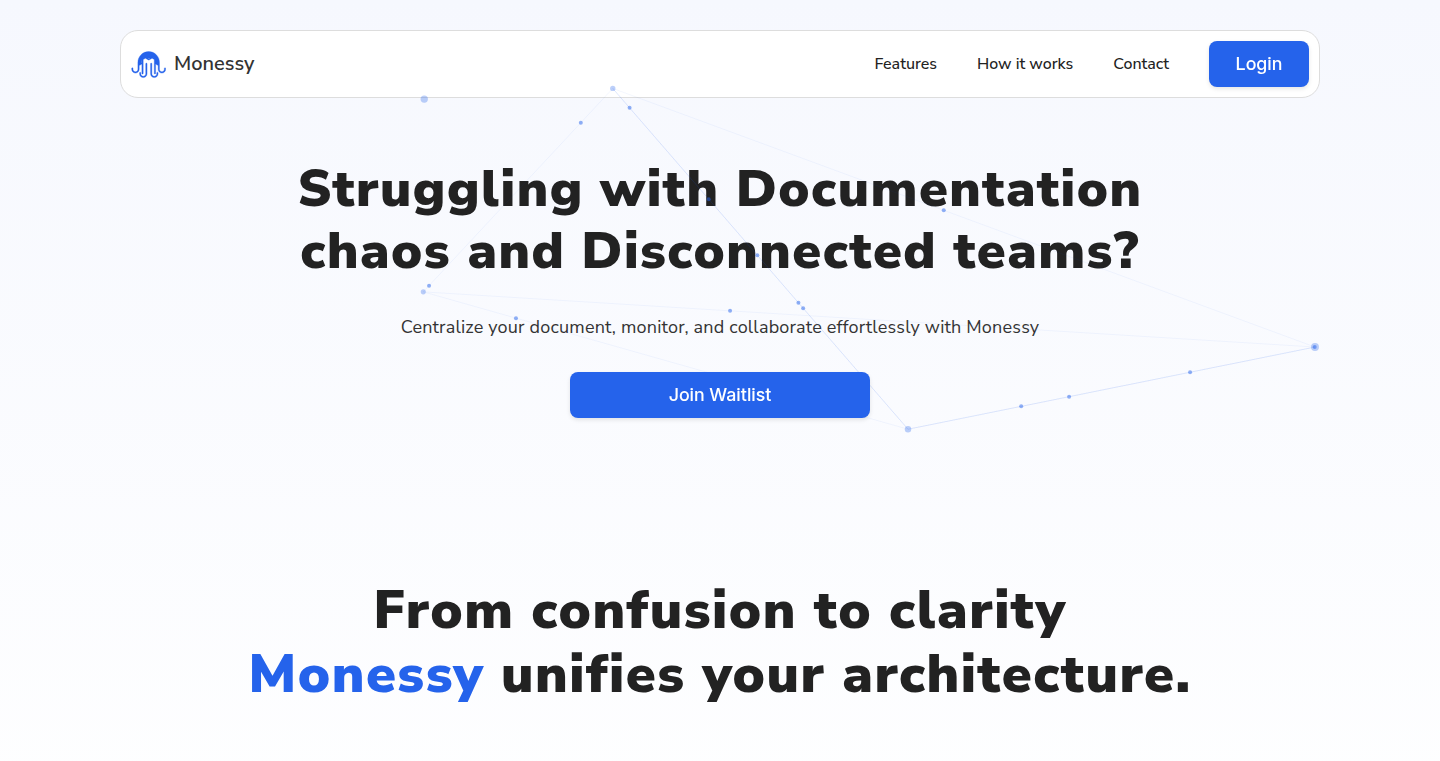
Author
praneethd110
Description
Project Navigator is a centralized dashboard that acts as a 'GPS' for your entire project architecture. It solves the common problem of scattered documentation and hard-to-find resources (logs, dashboards, and documentation). It simplifies project navigation by providing a single access point for all project components, thereby reducing wasted time searching for critical information and streamlining collaboration across teams. This is a significant technological advancement because it eliminates the time-consuming task of constantly updating documentation and manually sharing links, ultimately boosting development efficiency.
Popularity
Points 1
Comments 0
What is this product?
Project Navigator is essentially a central hub that automatically aggregates and organizes all of your project's vital resources. Think of it as a smart directory. It uses intelligent indexing and linking to provide one-click access to things like logs, documentation, and dashboards. The innovation lies in its ability to automatically keep this information up-to-date, reducing the burden of manual maintenance and ensuring everyone has the correct information. It works by scanning your project structure and identifying different components and services, then linking them together so you can quickly jump to the information you need. This avoids the need for endless searching and manually updating documentation.
How to use it?
Developers can use Project Navigator by integrating it into their development workflow. You might configure it to recognize specific service patterns or documentations locations. Then, when you're working on a bug or need to check system logs, you simply navigate to your Project Navigator dashboard. From there, you can find all related resources with a single click. Think of a project where you have a microservices architecture, each with its own logs, documentation, and monitoring dashboards. Project Navigator consolidates all these, giving you a single pane of glass. You can integrate this into your CI/CD pipeline so that with every deployment the dashboard is updated automatically.
Product Core Function
· Centralized Dashboard: Creates a single point of access for all project resources (logs, dashboards, documentation). The value is that it dramatically reduces the time spent searching for critical information across various tools and systems. Application: debugging production issues becomes faster, and onboarding new team members becomes simpler.
· Automated Resource Discovery: Automatically detects and links to project components. The value is that it eliminates the need for manual documentation and link maintenance. Application: When a new service is added, the Project Navigator automatically integrates it into the dashboard, keeping the information fresh.
· Cross-Team Collaboration: Facilitates easy information sharing across teams. The value is that it enhances collaboration and reduces communication overhead. Application: When a team needs access to another team's service, they can find all the necessary information in a single location.
Product Usage Case
· Scenario 1: A developer is debugging a critical production issue. They use Project Navigator to instantly access the relevant logs, monitoring dashboards, and documentation. By having all these resources in one place, they can quickly diagnose and resolve the problem. This saves precious time during a crisis.
· Scenario 2: A new developer joins a project. They can use Project Navigator to quickly understand the entire architecture, find all the key resources, and get up to speed quickly without being burdened by outdated documentation or having to search through countless links and documents. This accelerates the onboarding process.
· Scenario 3: A DevOps engineer needs to update the configuration for a specific service. With Project Navigator, they can go straight to the documentation, dashboards, and other resources related to that service. This improves the speed and accuracy of their work and reduces errors.
68
Natural Language Sprite Animator
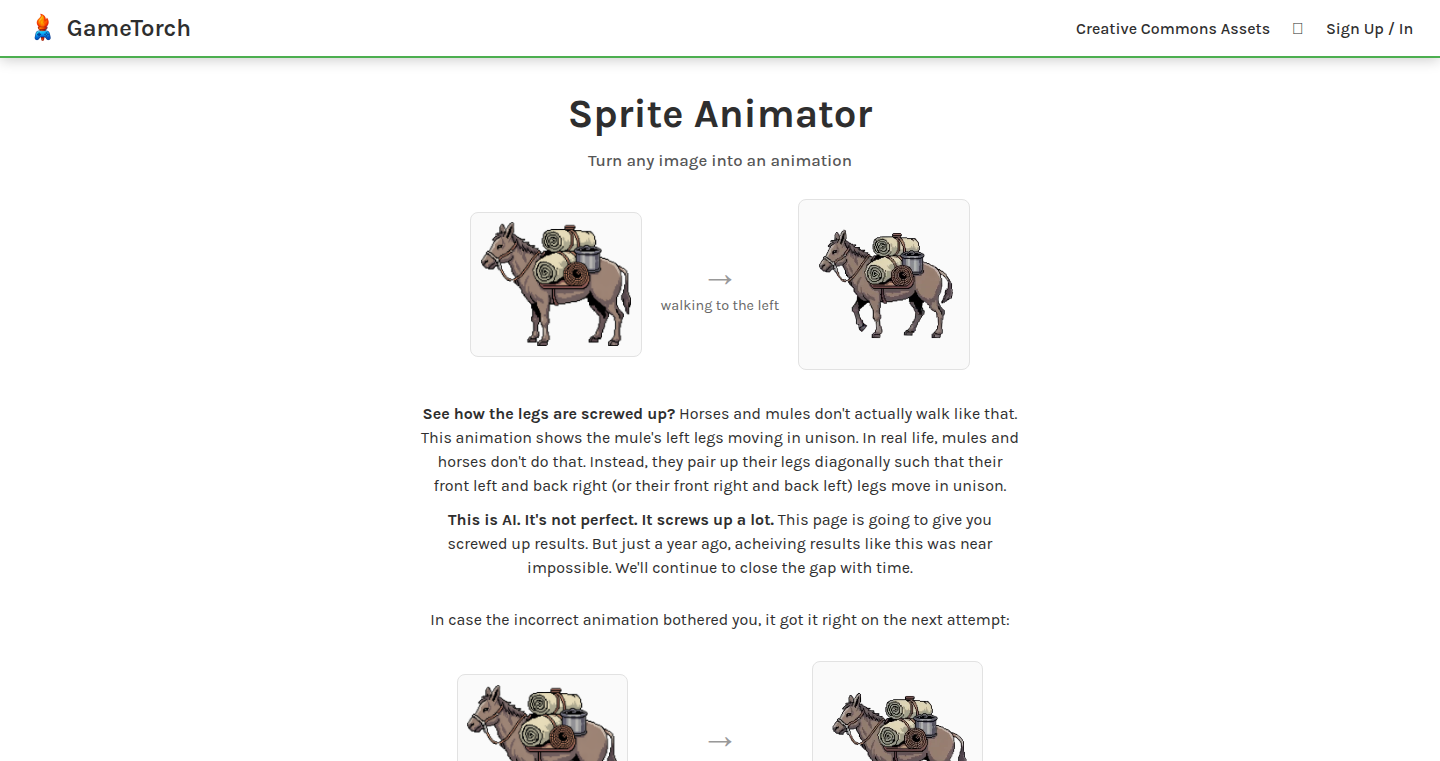
Author
gametorch
Description
This project is a tool that uses artificial intelligence to create sprite animations (like those used in old-school video games) from simple text descriptions. Instead of painstakingly drawing each frame of an animation by hand, you can now describe the action (e.g., "running to the left") and the tool will generate the animation automatically. The core innovation lies in a refined approach: the AI generates each frame separately but uses previous frames as a reference, ensuring consistency and reducing unwanted changes in the character's appearance. This significantly simplifies the animation process and opens up new possibilities for game developers and artists. So, it helps you create game animations faster and easier.
Popularity
Points 1
Comments 0
What is this product?
It's a system that uses a large language model (like those used for generating text) to create animated sprites. The key technology is the way it generates the frames. Instead of creating an entire animation in one go (which often fails), it creates each frame individually while considering the previous frames. This ensures that the character stays consistent throughout the animation. It's a clever way to leverage the power of AI to solve the tedious task of sprite animation. So, it helps you to automate a tedious task and use AI to make the animations.
How to use it?
Developers would use this tool by simply providing a text description of the desired animation (e.g., "character jumps") as an input. The tool would then generate a series of image frames that constitute the animation. These frames could then be integrated into a game engine like Unity or Godot. This greatly reduces the time and effort required to create game assets. So, it lets you create animations quickly.
Product Core Function
· Natural Language Input Processing: This functionality converts text descriptions of animation actions into instructions for the AI. This is valuable because it abstracts away the technical complexities of animation, making it accessible to non-artists and speeding up the creation process. This enables anyone to describe animations without knowing how to draw or code.
· Iterative Frame Generation with Context: This is where the AI generates individual frames for the animation, referencing previous frames to maintain consistency and appearance. The benefit here is higher quality animations with less manual work. So, it means your animations will look better with less work.
· Sprite Sheet Output: The tool packages the generated frames into a sprite sheet, a single image containing all the animation frames, which is a standard format used in game development. This makes the generated animations immediately usable in most game engines. So, it makes it easy to implement the animations into your games.
· Consistency Enforcement: A method to ensure the subject/character in the animation maintains a similar appearance over all frames. This is crucial because early attempts at AI-generated animation often resulted in the character's appearance changing from frame to frame. So, it allows the animations to look more professional and complete.
Product Usage Case
· Indie Game Development: A solo game developer wants to create a character animation for a new platformer game. Instead of spending hours drawing each frame of the running animation, they input "character running to the right" into the tool and receive a sprite sheet. The developer can then import the sprite sheet into their game engine, saving considerable time and effort. So, it saves the developer's time and allows the developer to focus on other things.
· Rapid Prototyping: A game designer wants to quickly visualize a new game mechanic involving a character's jump animation. They use the tool to generate a jumping animation based on a text description. This allows them to quickly prototype the animation and test the game mechanic without needing to hire an artist or spend hours drawing it themselves. So, it helps in rapid prototyping.